This site is dedicated to my mom, who taught me to love all animals equally, especially reptiles.
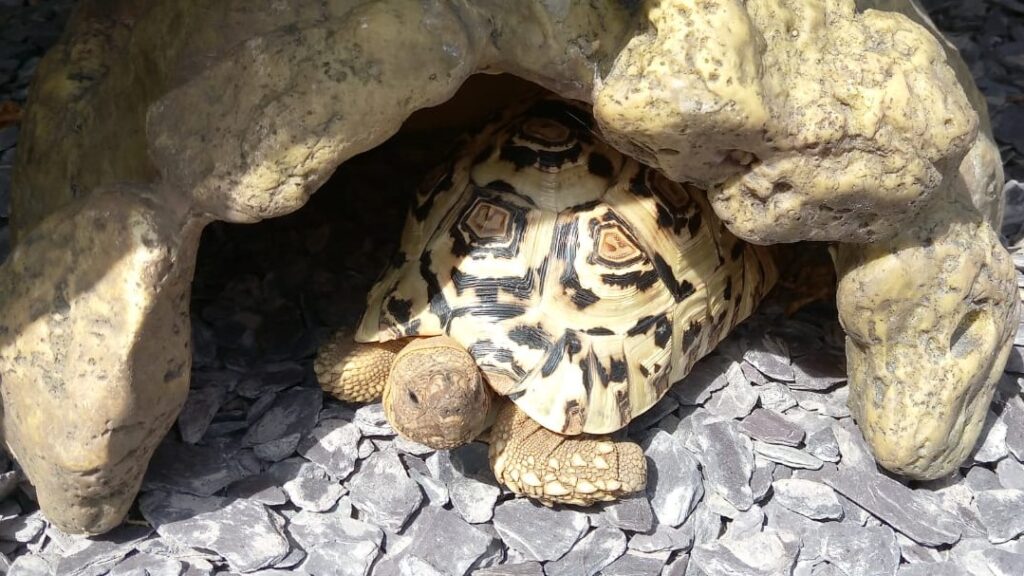
*All images and information are copywrite, please contact us on contact page for use of site images or commissioned photo work, my commissioned photography work is very affordable, and some images may be exempt of any fee
Disclaimer: Nothing on this site is meant to be medical advice, and no responsibility will be taken for adverse outcomes, which may, or may not be due to taking advice from this website or using interventions suggested on this site. All suggestions are purely for information purposes and should be cross referenced with other sensible sources and multiple veterinarians as part of developing a diverse and holistic knowledge base for the care of your exotic.
Interventions, if you like, can be seen as under the human therapeutics auspices of ‘Right to Try’ & ‘Compassionate Use’ which are growing in both their acknowledgement coverage & their broader meaning.
“Conservation can only begin, when someone has a full stomach” – Fraser Gilchrist
But in most parts of the world, there are many empty stomachs, and often war, and this is rapidly getting worse. So, responsible keepers – zoos and private keepers, more than ever, are becoming the last hope for the survival of so many species.
So lets do it right
Tortoise Husbandry
I believe, all exotic species kept in captivity, must be kept, only with the primary purpose of conservation and prolongation in mind. If you want an exotic captive bred animal just ‘for fun’ Become a poet or a painter instead. This is not for you. I say Captive Bred, because you should not be taking possession of wild collected animals unless you are involved in a conservation or rehabilitation programme with some sort of official status. I am all for certain wild animals being brought into captivity as their numbers are just collapsing in the wild, for reasons already discussed under the About section of my site, but this has to be done / realized and decided upon on a collective, large scale, professionally as a whole by everyone, not just one or two of us going our own way.
Also, remember that a wild caught animals will likely die by being brought into captivity, most do, so you won’t get to keep it very long, and you will no doubt have spent a good bit of money on acquiring it and its enclosure. Captive bred individuals come from stock that has acclimated reasonably well into captivity and have been more trait and genetically suitable for captivity, often just by luck. But they will be producing offspring that will have inherited those traits and the offspring will be better suited to captivity themselves.
It should be imperative that you:
1)Keep exotics with the readiness to breed them responsibly or, at least, be willing to offer your individuals or specimen for breeding purposes on occasion, particularly if they are rare. This is to keep genetic diversity high in captive bred numbers and not to have too many individuals who cannot find homes, or to breed for profit. And you should be willing to learn about and engage on the subject and and engage on other related research subjects.
2)Keep your exotics with the premise that you are keeping them to eventually be released back into the wild. This will make sure you are keeping them in the most natural and true to their original environment as you possibly can. That way, they are likely to live longer and be healthier, and maybe one day get to go back into the wild, or at least their offspring get to go back.
3)Employ The 4 Pillars of Medical Ethics, tailored for animal husbandry:
a) The right to autonomy of your exotic, to the best of your ability. Don’t make or expect them to do things they are not naturally comfortable with. If they are trying to climb out of their enclosure continuously, for example – there is a problem with their enclosure, they are unwell or, there is a problem with another individual in the enclosure or (they will likely know before you do if one of their mates is ill. Try to find out what they want or need, perhaps extra space is needed or they are uncomfortable with something in their enclose like too much heat or a nasty plant or substrate, or there is illness in the enclosure.
b) Beneficence toward your exotic. Be kind to them at all times, they really can tell, and they will appreciate it. It is too, your duty to do so.
c) Non-maleficence to your exotic – don’t take out frustration on your little friend, don’t neglect them when you feeling down, they can make your life so great and fulfilling, always be mindful of the importance of unconditional care.
d) Justice – uphold Justice toward them and for them
4)Appoint a responsible, capable and financially able Guardian or Guardians, or trusties, especially if you are thinking of going the Charity or Trust route – which, is a great deal more work, but financially beneficial and more welfare orientated to your exotic or collection of exotics.
Visit your exotics natural environment, and get a feel for the environment where they come from, take pictures, learn about the local plants and especially temperature and humidity… at night and throughout the day. Become a dedicated researcher and post online, as much as you can, for others to learn from you too.
4)Network with other enthusiasts, for help, advice, support and, that all important readiness for genetic diversity propagation, or guardianship should you fall ill or something to that effect.
Tortoise Keeping best practices
I stick to African tortoises as these are the only ones I have ever kept / taken on as rescues. These species do not fully hibernate, so I don’t cover Hibernation on this site. However, the principles for keeping other types of tortoises are very much the same with regard to husbandry.
I will start with Housing, as, when you are just starting out, this is where you ideally must start, and this should all be set up before you acquire your new friend or friends. And that comes along with researching your particular species requirements and natural habitat and diet, naturally.
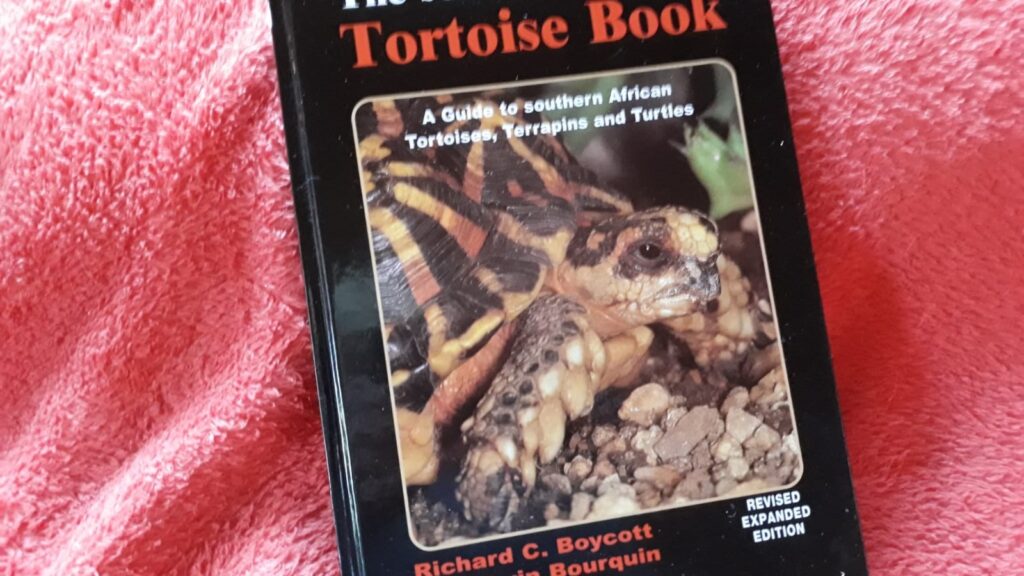
Enclosures
Outdoors
Other than in summer, many countries where tortoises are kept are not their home countries or environment, and the climate will be unsuitable for outside living in the winters often. Some African tortoises will happily hibernate, but most don’t under normal circumstances, and will simply go into a mild Brumation (winter slowdown). So an indoor facility is most often a must, as Hibernation and even Brumation for African species comes with risk, if a very good diet and robust immune system is lacking, which it can often be with captive individuals.
Also, predators like foxes, mink, mongoose, pine martins, rats, birds of prey, and even mice & cats can cause great harm to a tortoise, these predators would almost never have a chance with indoor enclosures, so the construction of outdoor enclosures for summer time needs extra careful thought in this regard.
A balance of safety and large space, especially for the larger tortoise species like Aldabra’s, Sulcata’s and Leopards is the target. Hides that are tough and robust, that Tortoises can squeeze into for safety at night in summer time are required, if they are indeed staying out at night
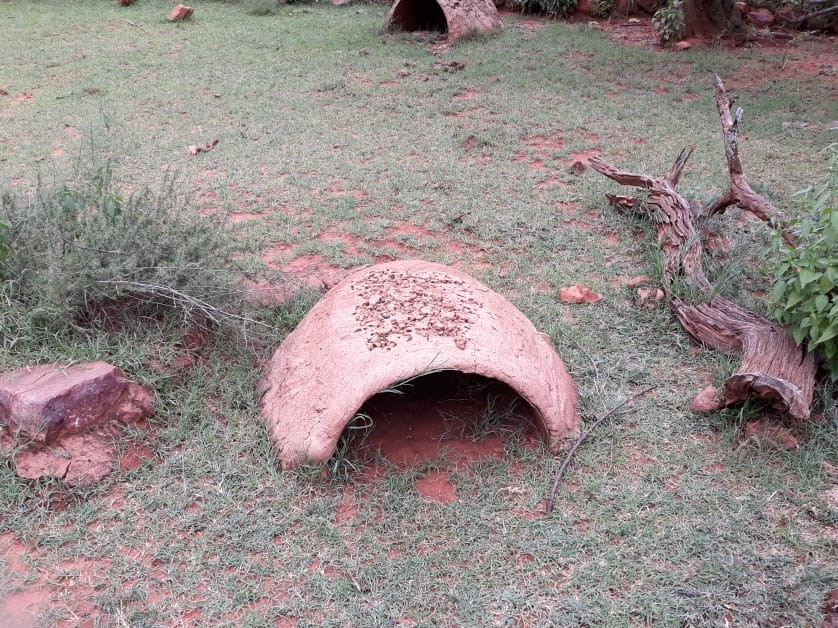
Concreted over quarter 44 gallon drum cut out, with macaroni pasta pieces mixed into the concrete on the top, to make it look like an old ant hill. Ideal for Leopard Tortoises. For adult Aldabra’s or even Sulcata’s, you need something even bigger
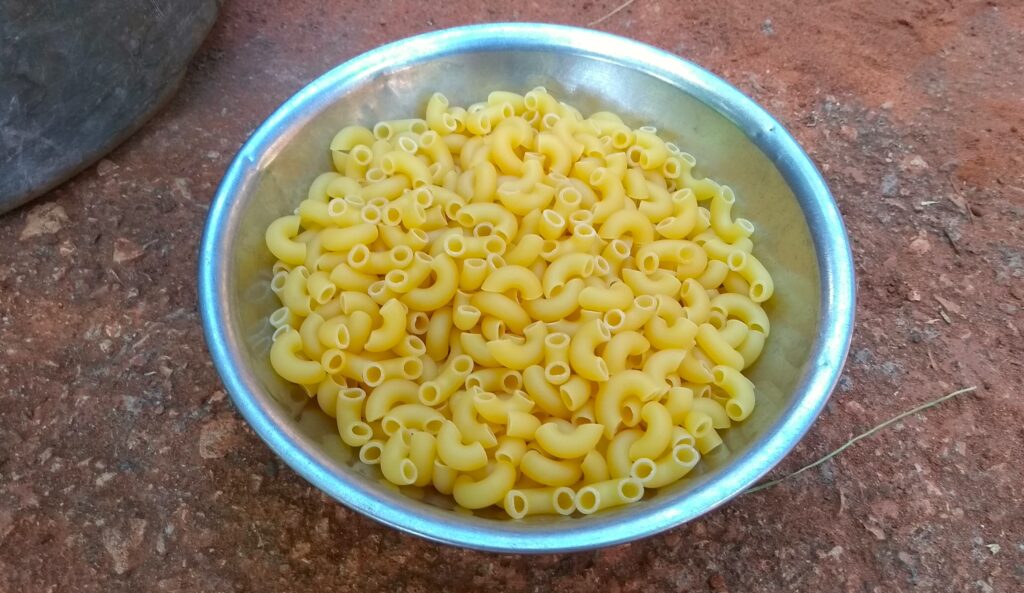
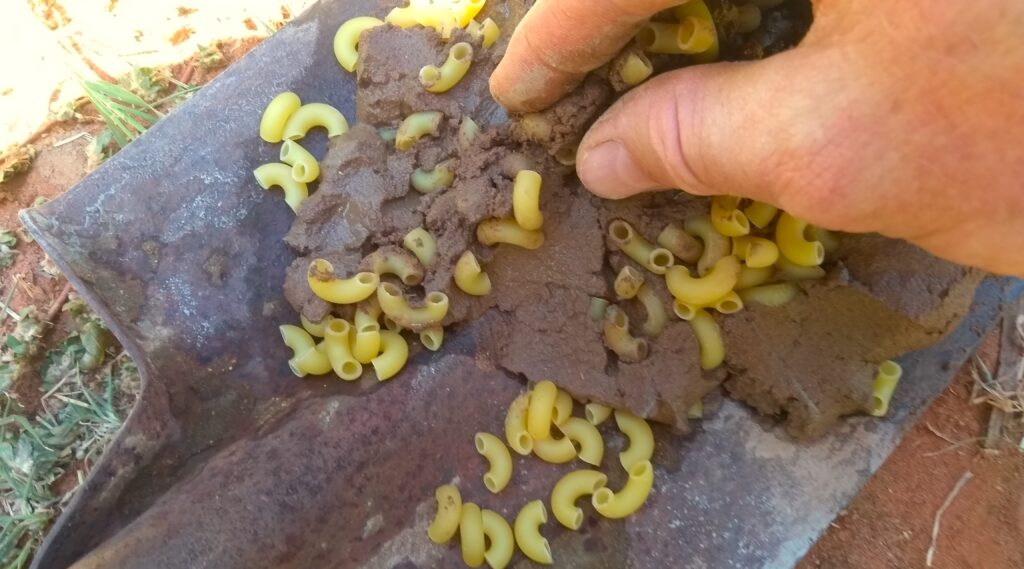
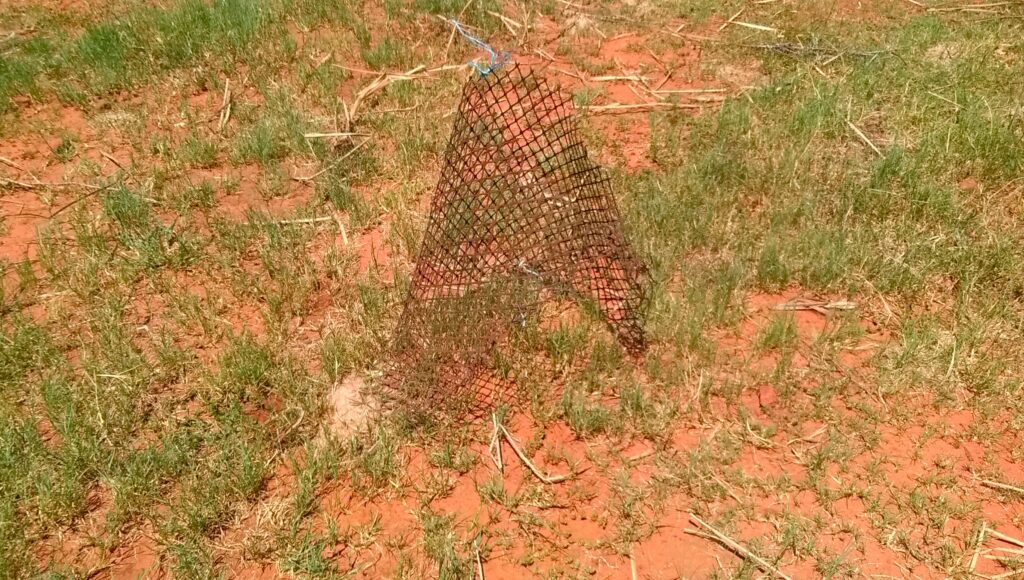
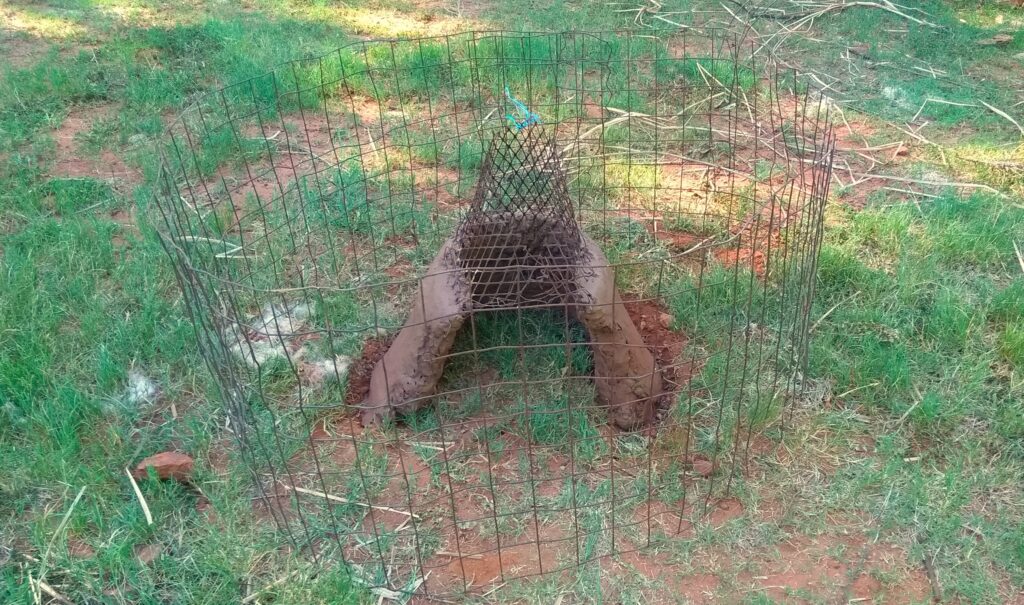
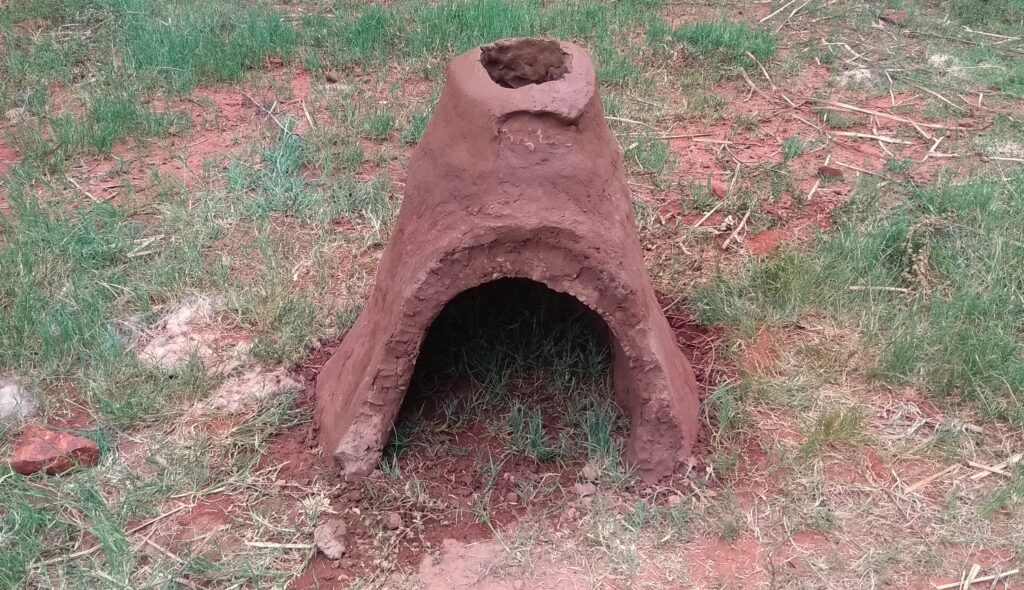
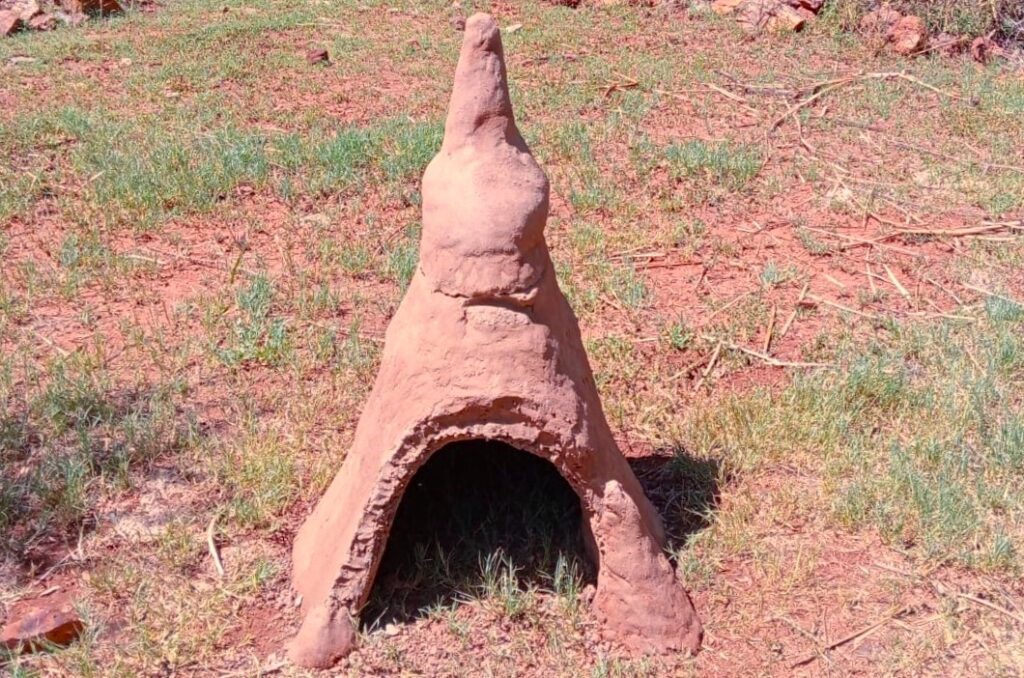
*Note: I have not put ‘caves’ or holes into the ground, below the ground surface, for the tortoises, these are sort out by many tortoise species, especially in the wild, because they are much cooler than any above surface grotto is likely to be. The problem is, during heavy rain and flash flooding, these can fill up with water very quickly and possibly drown a tortoise. A ‘cave in’ is also a risk if not built properly or it is augmented by your tortoise without you knowing, as tortoises can dig very well. So no below surface caves are advised.
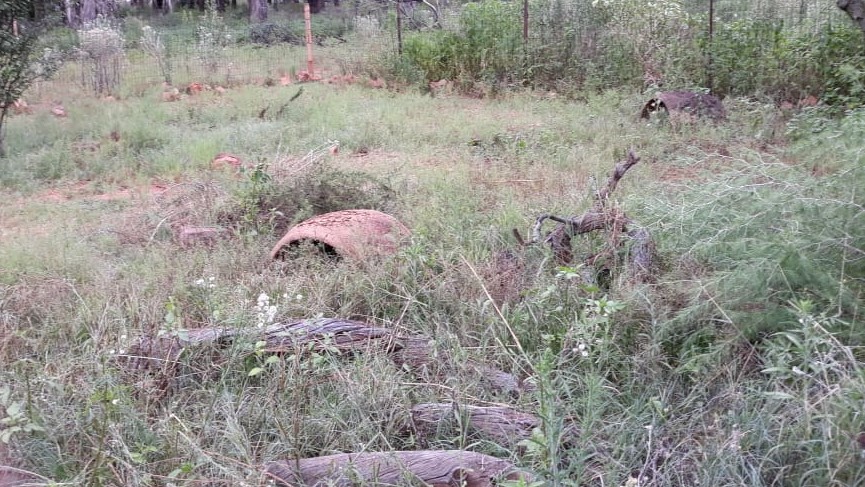
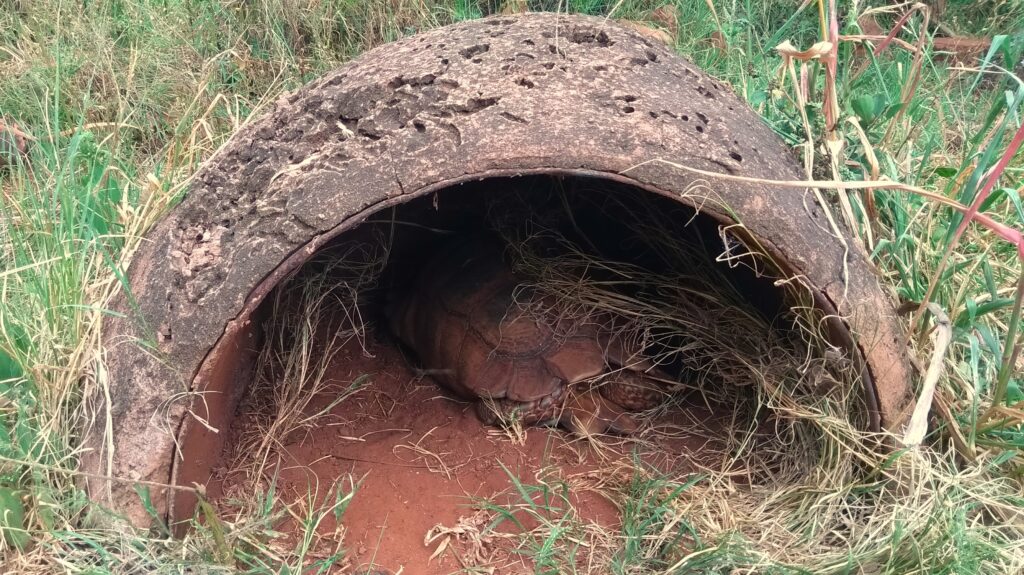
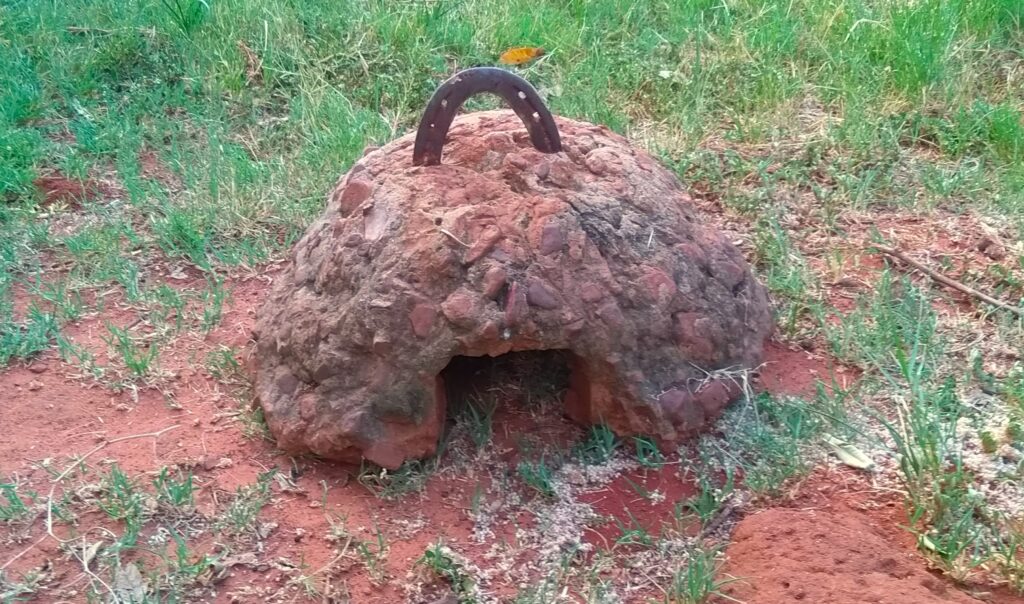
I also allow some of our bigger tortoises access to our house as they please. Below, we have a cat flap into our conservatory I built, they are very smart and use the cat flap regularly when we are at home and keeping an eye on them.
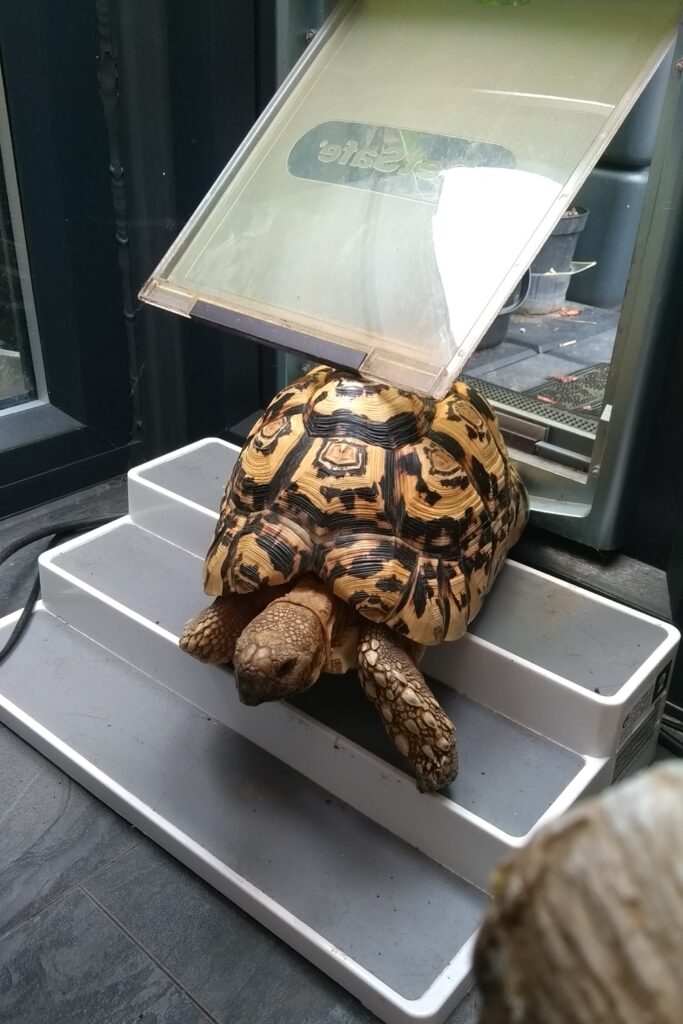
Indoors
Vivs and Tables
Pic of Viv full
The ideal indoor enclosure should be a hybrid of a vivarium and an open tortoise table, this allows the enclosure to be somewhat closed at night and especially on cold days, to maintain heat / warmth and humidity levels. For my juveniles, I close my enclosures at night, essentially turning the table into a vivarium, to up the humidity mainly, but also maintain a minimum temperature at night. However, on warm days, the enclosure is open for fresh air to circulate into. Remember though, if you have other pets, like cats, even a parrot, can take a nasty bite out of a small baby tortoise (parrots will and do eat meat) – so close the top off with some sort of grill or mesh.
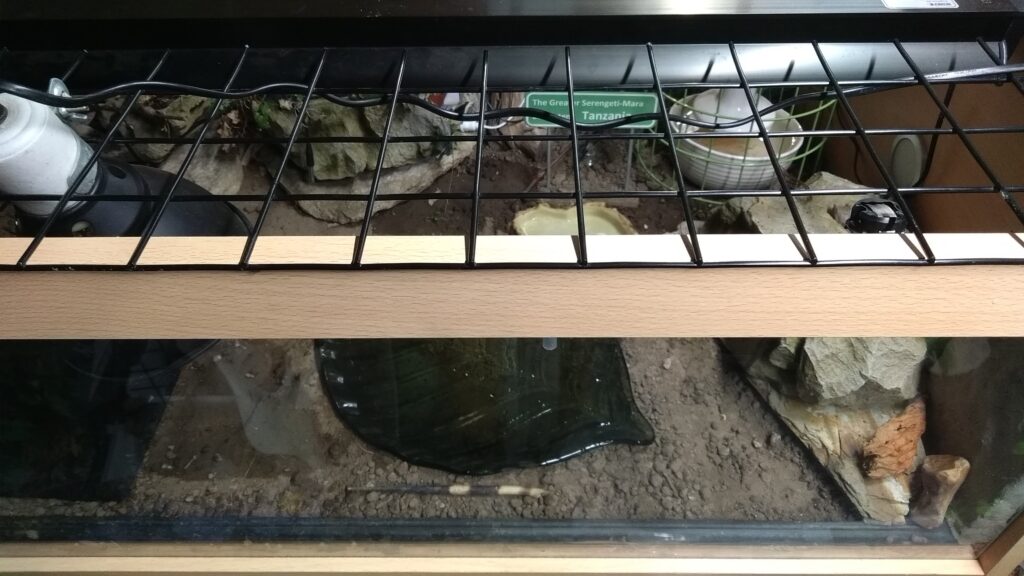
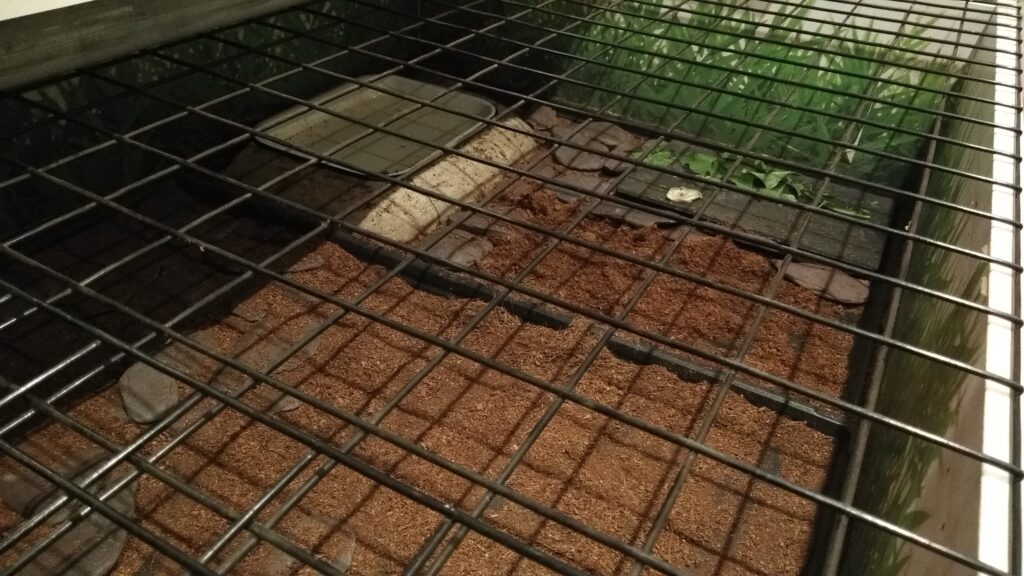
Maintaining a clean enclosure that wont harbour pathogens and toxins is critical. UV lighting, as you will see in the Lighting section, helps with sanitization. Tap water for misting helps too, as mentioned in the Water section of this page – it has some powerful additives for disinfection. Use glass sprayer / mister containers only , change water and rinse / wash container at least once a week – I put mine in the dishwasher once a month too. Use tap water for Misting substrate, and use Bottled Spring Water for misting tortoises’ shells – Chlorine and Chloramines in Tap Water will dry out their shells.
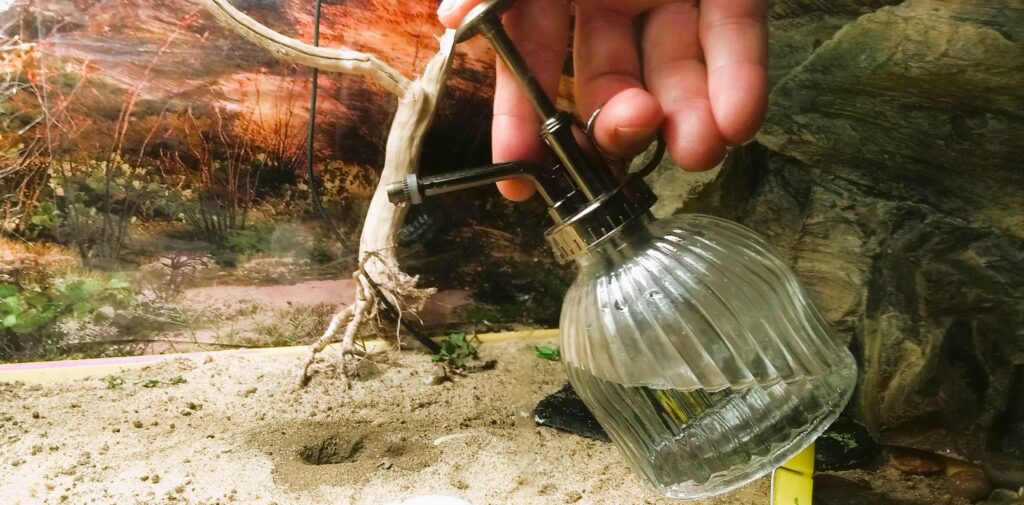
But, another important inclusion for hygiene is Activated Charcoal, granulated Activated Charcoal has Anti-Microbial, Anti-Biotic and Anti-Viral properties, so is really useful sprinkled on or mixed into flooring substrate. I like to especially use it around water bowls. Charcoal is naturally found in the natural environment because of bush fires, so is very safe to use.
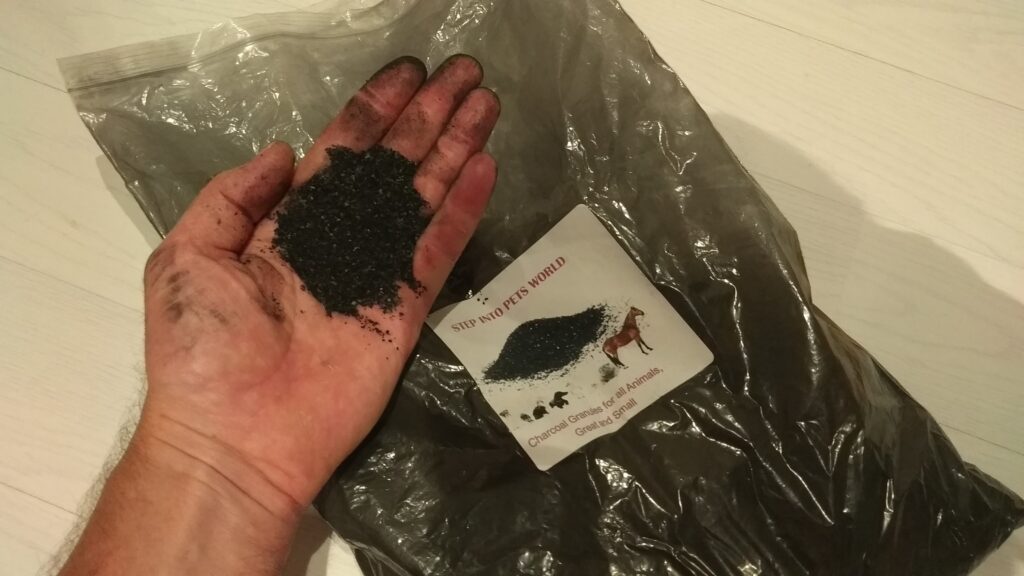
All accommodation should be as large as possible, adventurous, with up and down topography and obstacles to negate boredom. It should also have space for the replenishing of sprouted seed trays, as well as some grown Tortoise weeds and plants (including a bit of grass seedlings) This allows your tortoise to forage on fresh, still growing plants, this is especially important for juveniles and hatchlings to encourage and wean from egg sack onto proper food.
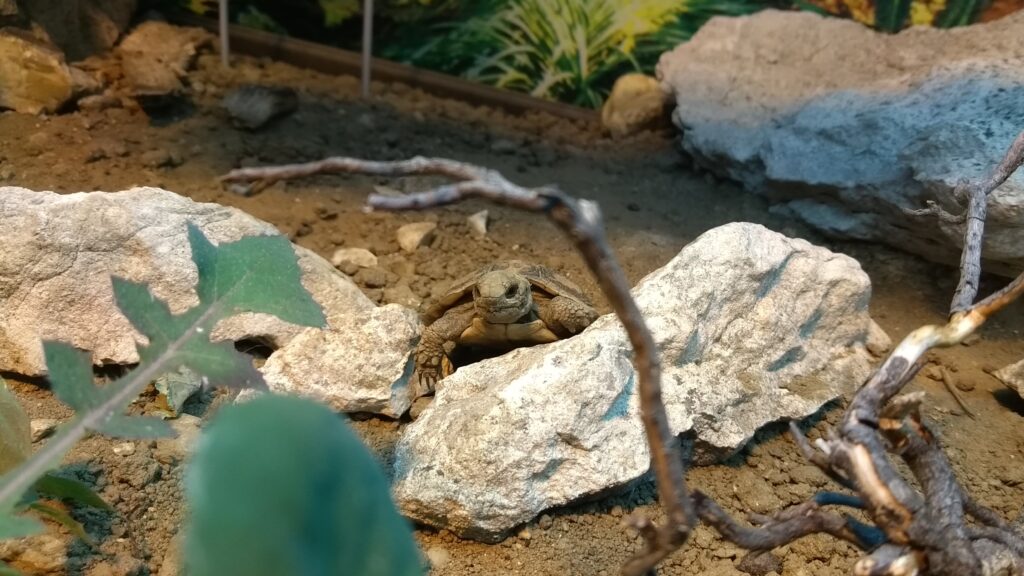
In summer time, all tortoises, of all age types should have a suitable and safe outside enclosure to spend at least some of the day in. Again, this enclosure cannot be allowed to get too hot or too dry, or to wet and not too cold, on rainy or colder days. Adult tortoises can handle more temperature extremes than juveniles, but they still need to by watched. Now, exposure to outside habitat increases the risk of parasites & pathogens to some degree, most particularly, for juveniles and hatchlings. So make liberal use of Diatomaceous Earth & Activated Charcoal sprinkled on the substrate to reduce this risk a bit. Rain, however will render these ineffective, especially Diatomaceous Earth, so don’t have your little guys out if it is going to rain. If it is going to quick warm shower on a warm sunny day, species such as Pancake Tortoises absolutely love a bit of rain.
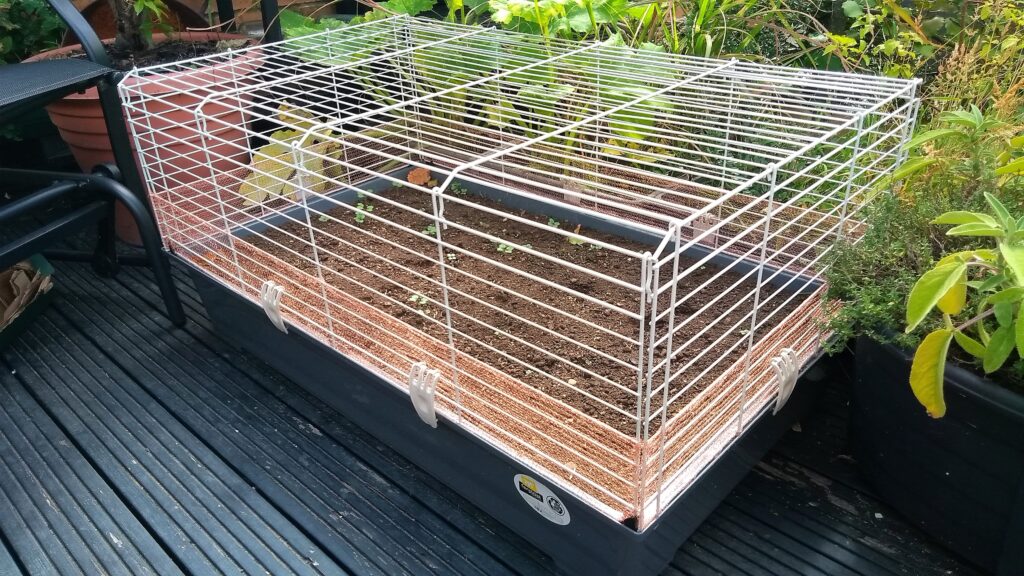
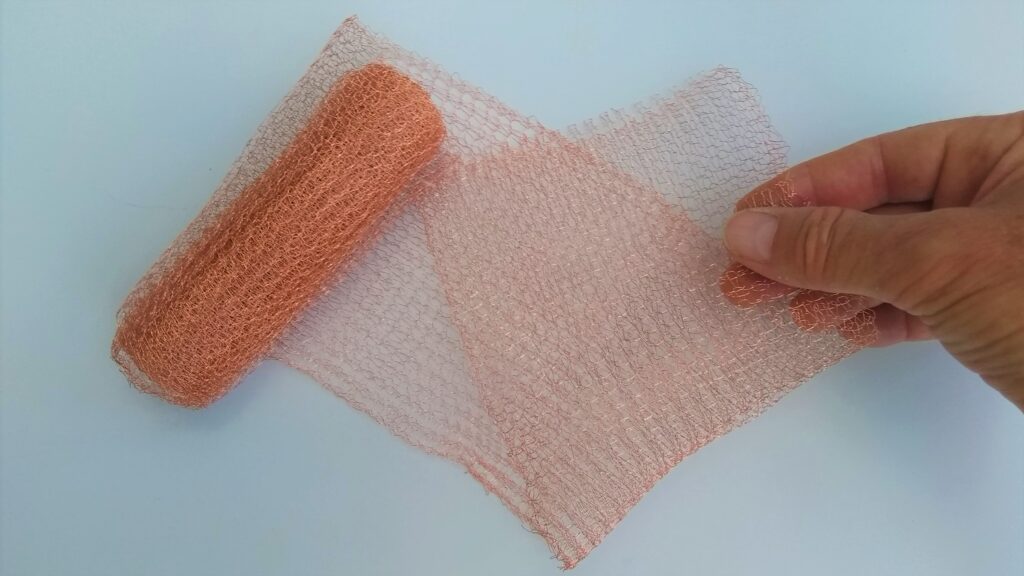
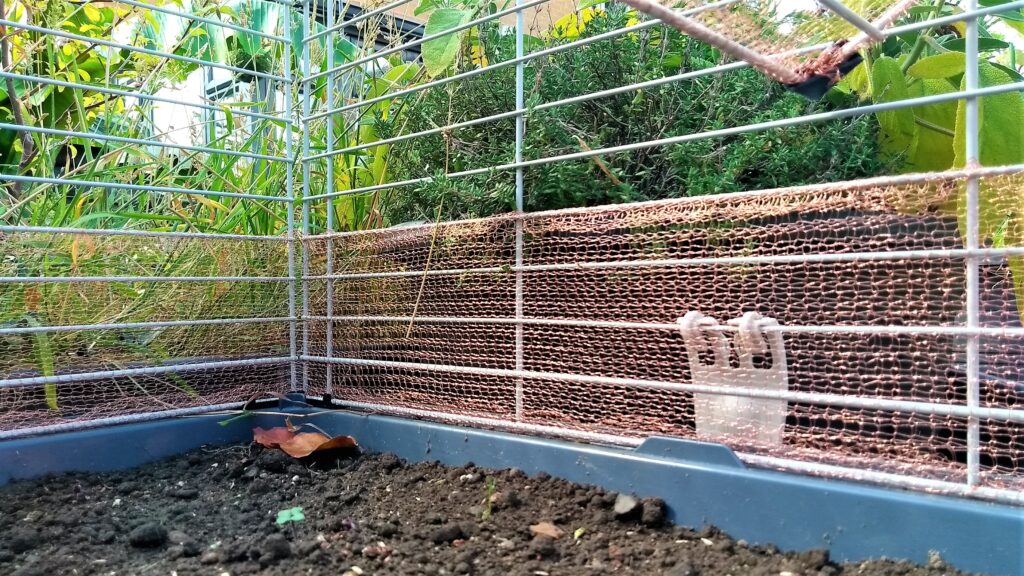
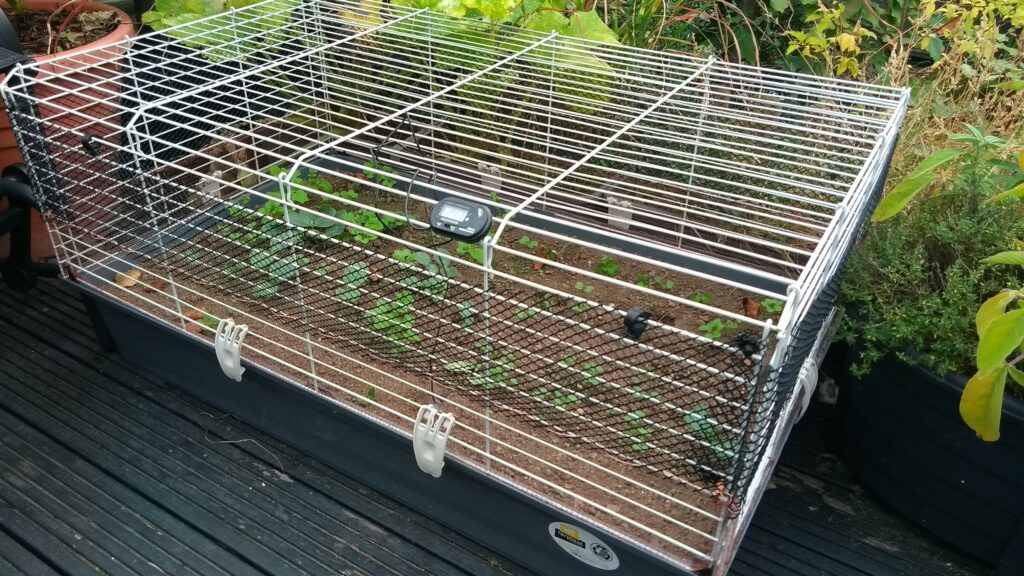
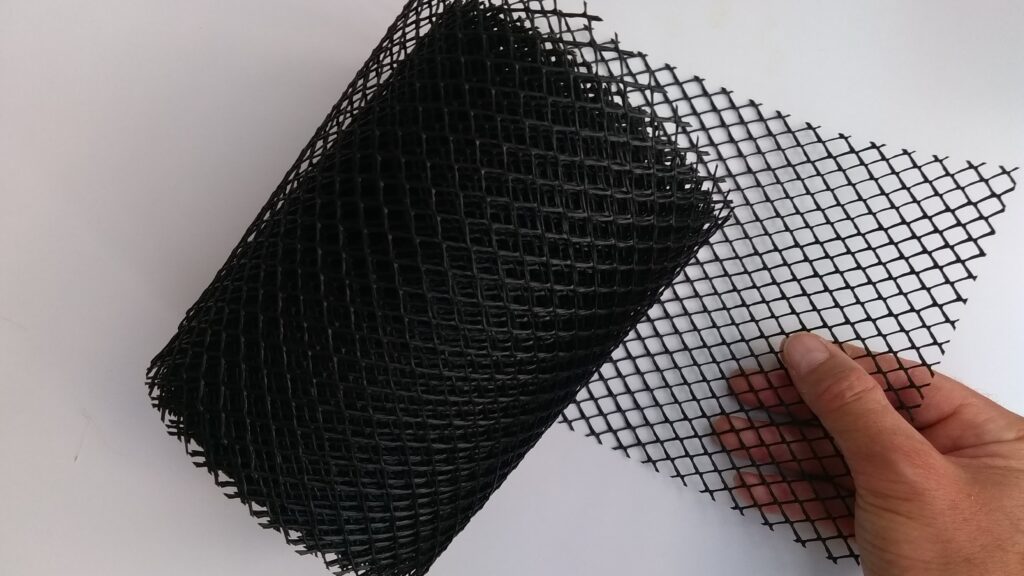
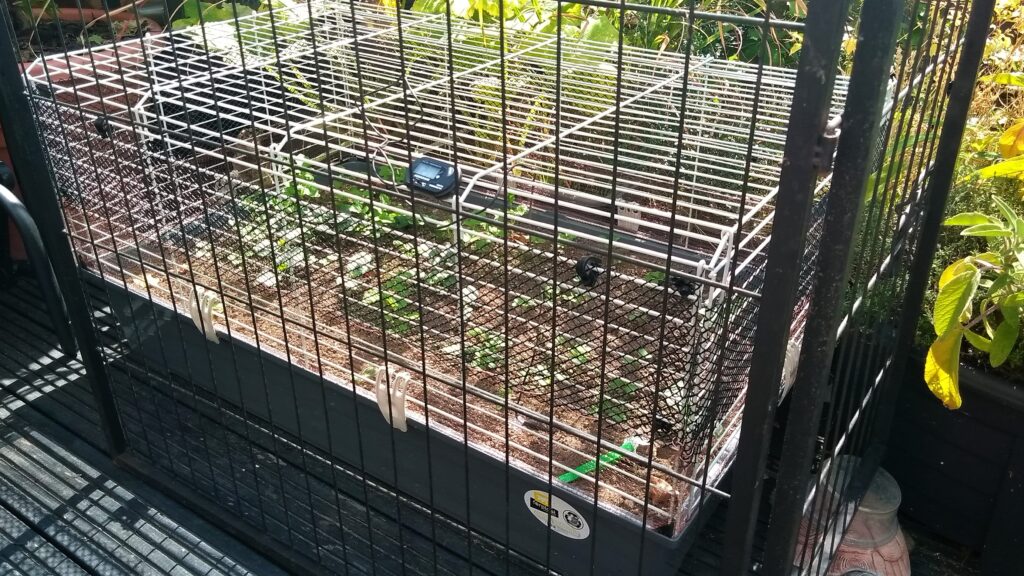
Water
Daily cleaned water supply is essential for keeping tortoises. Ideally, cleaned more than once daily, especially if soiled.
Tortoises may go for long periods without having to drink water in the wild, they often come from very arid habitats, as is the case with most African tortoise species, but you won’t know when they will need water or not. Tortoises can find water in the desert, they can make use of succulent plants and morning dew, and rain, not so easy in a badly set up Tortoise Table or viv. So a constant water supply is absolutely necessary.
There is no such thing as a desert tortoise arguably, yes many are found is very arid regions such as Mexico and the southern US, and the Testudo Species of the Palearctic region comprising the Greek tortoise, Afghan or Horsefield tortoise, the Egyptian tortoise, and even the Sulcata tortoise, to name a few, inhabit arid regions. But they don’t comfortably reside in true deserts, not even the Sulcata African Spurred tortoise is found extensively in the Sahara desert. Indeed, no tortoises are found in the the biggest and most profound deserts of the the world, namely, the Arctic desert, the Antarctic desert (for obvious reasons) but, the Gobi desert, the Sahara desert, the Nazca desert and the Atacama desert are home to no tortoise species. Even in the Sahara, the Sulcata is only found on the outskirts of this vast desert.
Tortoises have largely been pushed out of tropical and humid areas to make way for the pressure of human sprawl and agriculture, which has been going on for thousands of years. Tortoise species that were not able to adapt to the arid less hospitable and safe, less favoured by humans, semi desert areas, simply went extinct. Tortoises never evolved in dry arid conditions, and even when they are found in these habitats, they always prefer to be close to rivers, fleis and marshland where it is more humid and more fertile and thus lends itself to more food availability and less chance of desiccation.
So, we cannot expect tortoises in general, to be at home in a dry environment, or be safe from disease, which is exacerbated by dehydration – almost all disease is, and in humans too, so often primarily the result of dehydration. Even with the Egyptian tortoise, in its natural environment, the ‘deserts’ of South Mediterranean, these areas can often read 95% + humidity at night.
In regard to husbandry, have a secondary / back up water supply in your Tortoise Table, Vivarium and outdoor enclosure. This does not have to be changed every day, but weekly at least, if not used or soiled. It is a valuable back up if you happen to forget to fill your main water bowl, or your exotics soil it badly early in the day and then won’t use it, or it is knocked over. It is also yet another supply of water vapour for your indoor enclosure, keeping up those crucial humidity levels.
Hydration is critical for keeping any animal, its critical for humans to. Most ailments, and even diseases are a direct result of not drinking enough and not drinking pure water, this is true for humans and especially pets.
Baby tortoises will get used to the idea of not having water if it is not readily available, and may not think to drink when it is finally available, causing them to dehydrate and eventually die very easily.
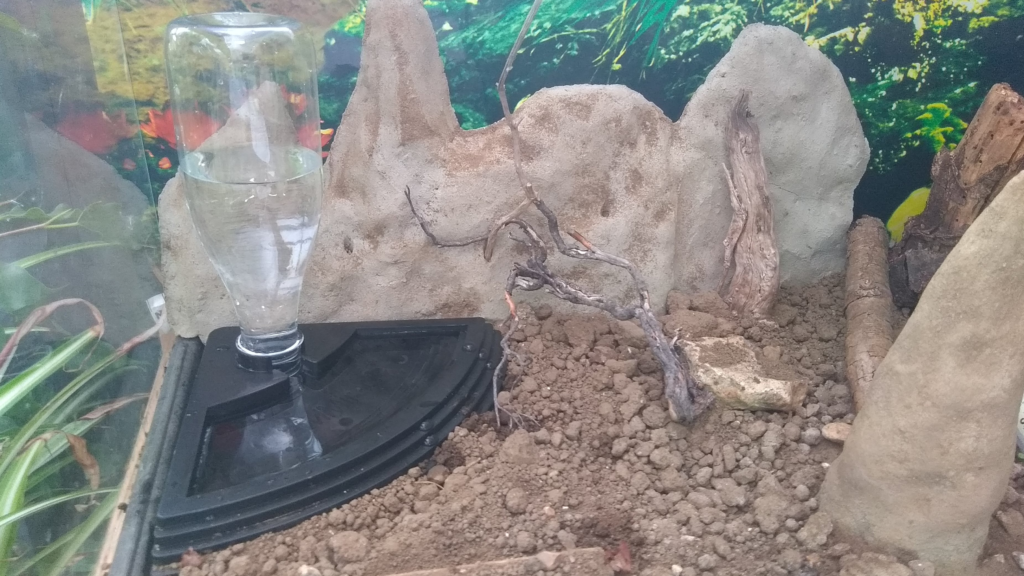
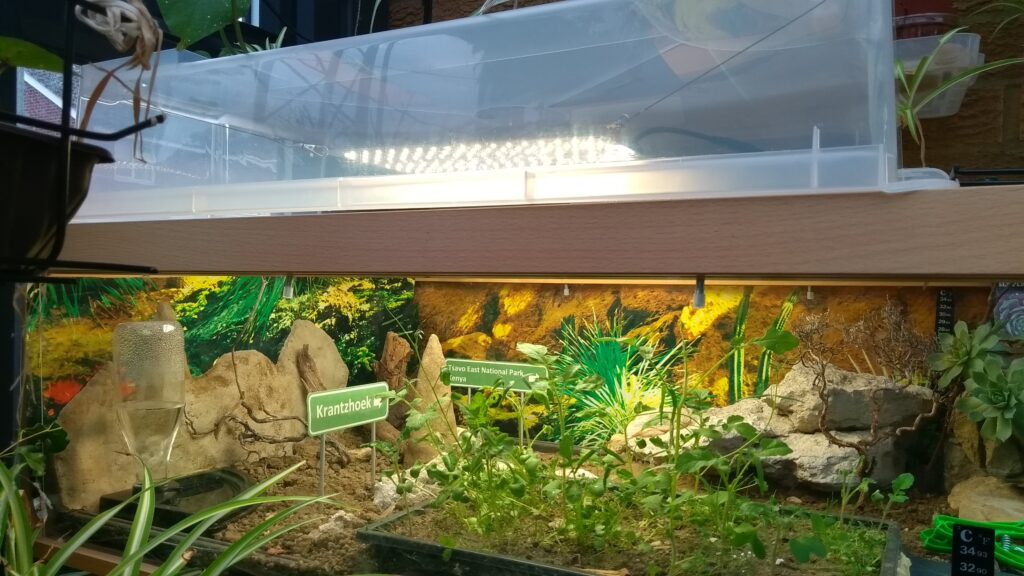
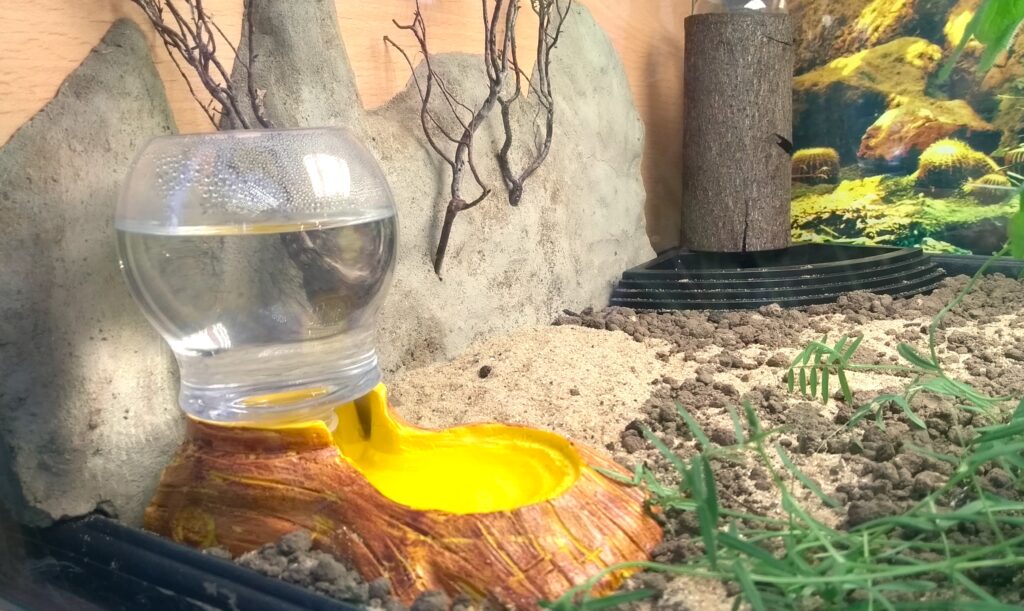
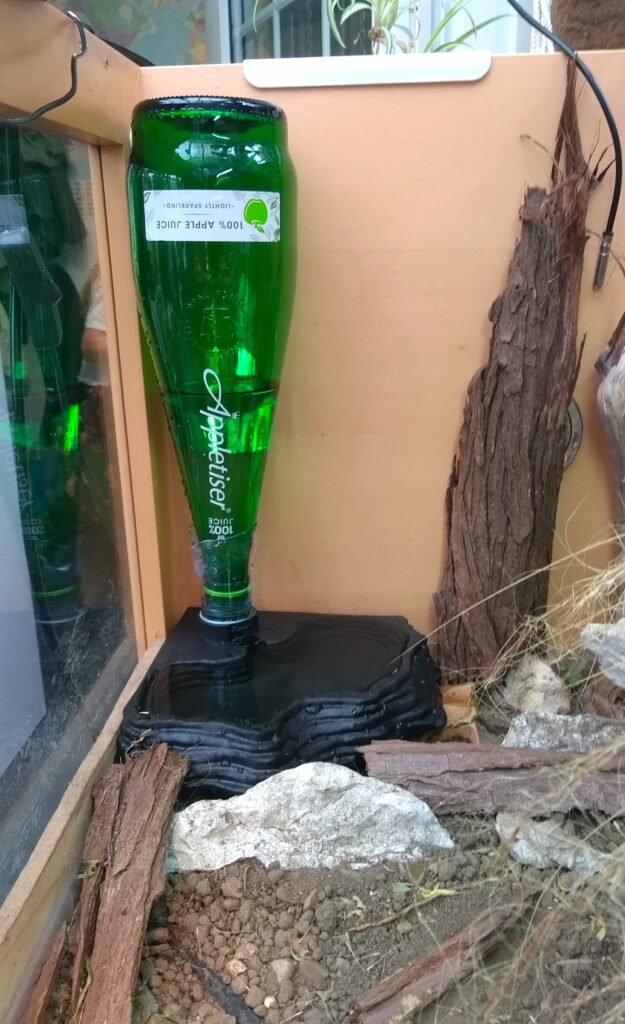
For Juveniles and sub adults, I only give glass bottled Spring water for drinking water, especially hatchlings.
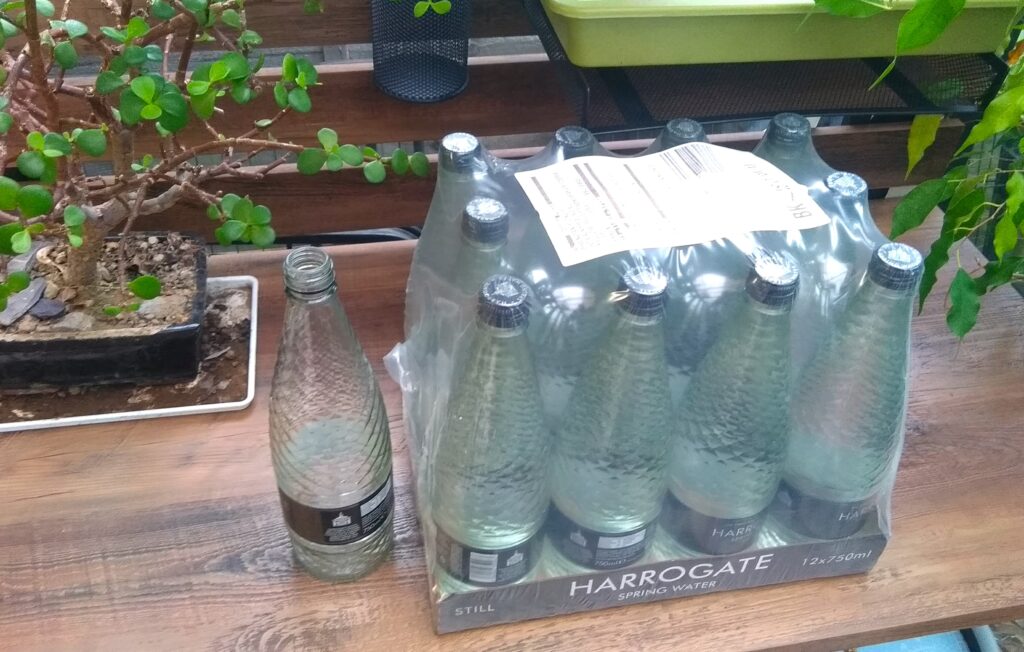
For daily soaks, of which I don’t do, unless a tortoise is under care for not being well, I will use warmed tap water, but not for drinking on a regular basis. Tap water is not an ideal drinking water, almost all municipal water supply – ie tap water is ‘treated’ quite heavily.
Tap water needs to be hygienic. To achieve this, Water Companies treat with some rather powerful chemicals, especially these days. Tap water is Chlorinated, and also has Chloramines added in most countries and places (Chlorine & Chloramines are not the same thing) Tap water often contains Nitrates and often, is ‘treated’ with Fluoride. Fluoride binds to health damaging heavy metals, drawing them out of the piping systems and into your cup of water. Nitrates are more naturally occurring but are not healthy, and human children are not to be given water from supplies high in nitrates, for good reason. Chloramines are not good either, what is worse, is they cannot be boiled out of or left to dissipate out of tap water like Chlorine does or like Chlorine Dioxide (another water treatment additive) can & does. Humans, being the size we are, might be able to handle these substances just barely, but poor little tortoises? My position is, tap water for drinking is not healthy for us or little tortoises, but most especially not for baby tortoises.
https://www.sciencedirect.com/topics/nursing-and-health-professions/chloramine-derivative (refer to the section: Commonly Used Animal Models 7.5.5 Housing and Management)
Chloramines are not found naturally in nature. Horticulturists and professional plant growers don’t use tap water for this reason, because it adversely affects life forms, and if they do use tap water, they have to treat the water, or filter it. Tap Water cannot be used in Hydroponics, Aquaculture or Aquaponics either, for the same reason.
Chlorine & Chloramines in drinking water have been implicated in causing constipation, nausea, diarrhea, eye irritation, kidney disease, and indeed even Colon Cancer. Our baby tortoises here at African Tortoise Resource have always been on premium Bottled Spring water, but we are now giving our larger tortoises (who are not in the larger natural enclosure with a body of water serviced by borehole ground water & rain water) but spend time outside and indoors, we are now giving them Filtered & UV treated drinking water. Look at our Ultra Violet Filter along side our Berkefeld™ gravity fed water filter. Incidentally, I did not add the UV Filter to our water system to kill off Bacteria, Viruses, Fungi & Algae and Protozoans, but, to break down Chlorine and Chloramines. Naturally, UV filters do combat these germs too quite well, and are a must have if you are using rain water or water from a river or lake for your animal drinking water or indeed for your own drinking water too.
Extract from below study:
“An association between water chlorination and the development of colorectal carcinoma is well established”
https://pmc.ncbi.nlm.nih.gov/articles/PMC4824718
The Berkefeld™ is gravity fed, so requires no electricity, and the UV filter can be 12 volt, so can work off of a solar panel. Important attributes as we move into a world with, shall we say, fewer guarantees regarding utilities and services.
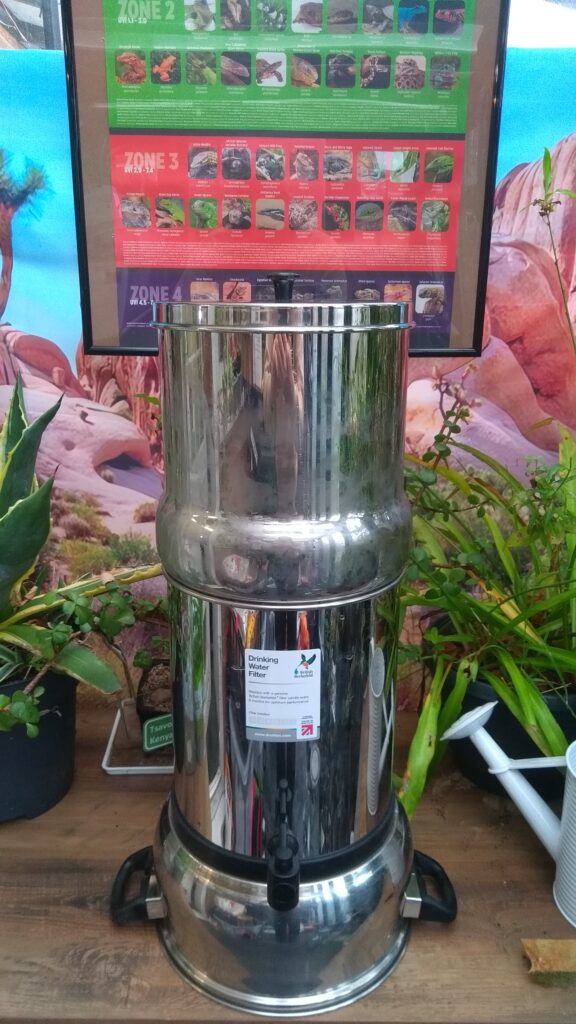
exotic animals
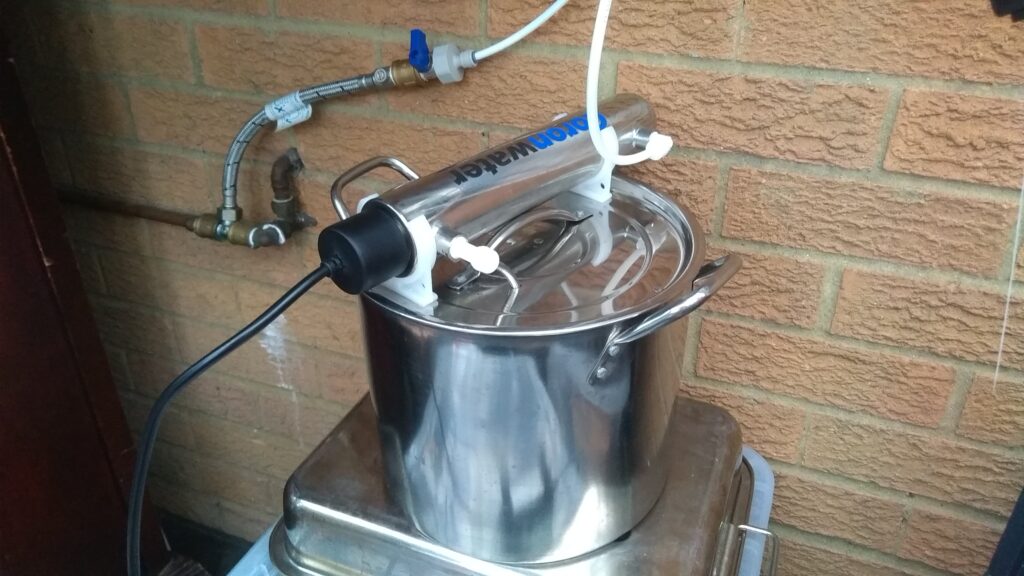
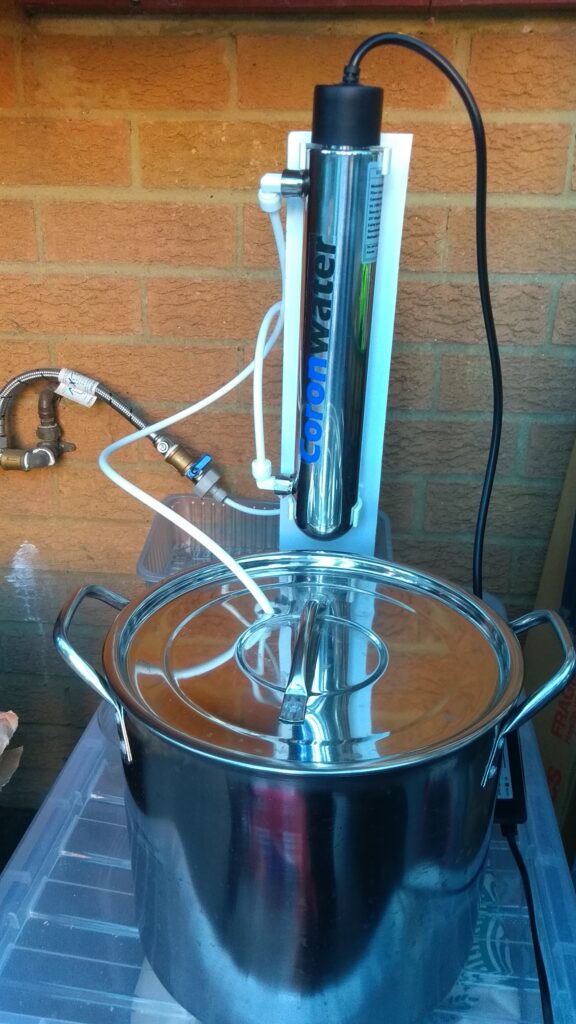
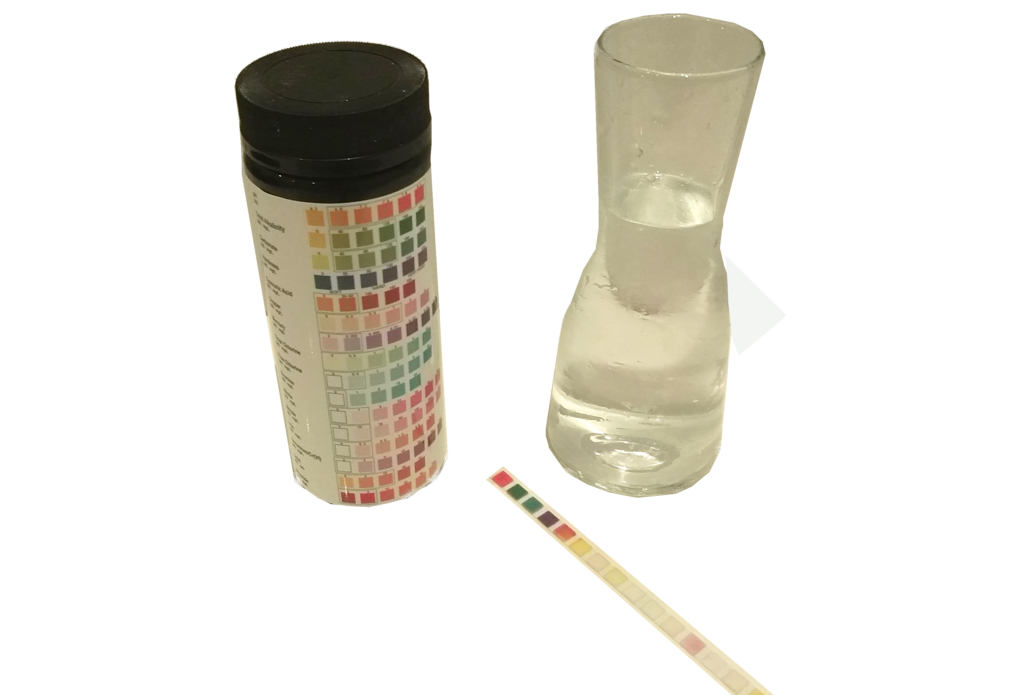
There is an entire industry dedicated to dealing with chlorine and chloramines, so they are not benign or something to disregard.
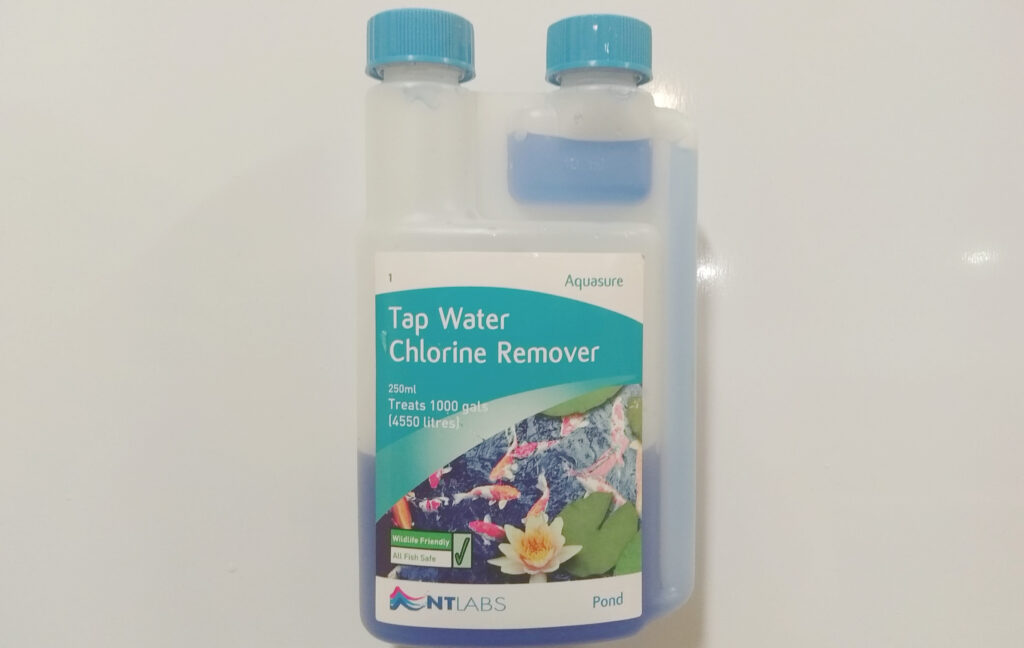
You might very well notice your tortoise is drinking more after ending tap water use, as we have witnessed. That is a really good thing for your shell friend.
I use only Glass and Ceramic bowls for my main water supply, because they are easier to keep clean. Plastic and even Resin containers I would not use because of chemical leaching and infection control. Just take care though, Glass and Ceramic can be broken and shatter into sharp pieces.
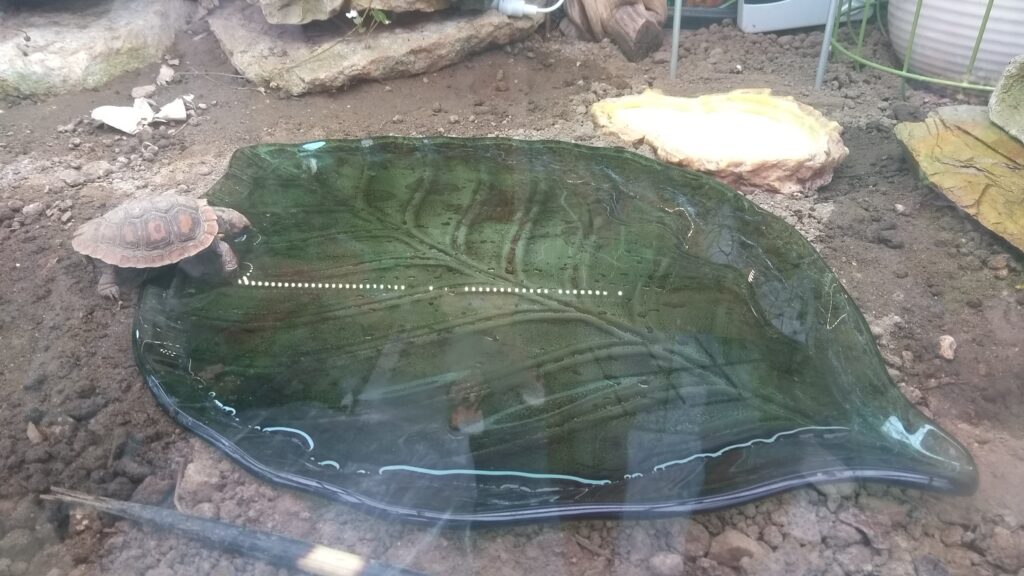

Things I then add to bottled spring water are: per roughly 1 litre of water
a) 1 to 2 drops Lugol’s human grade pure iodine (but Not topical antiseptic iodine or crystal iodine) Iodine is an essential trace element exceptionally important to all animals including humans, for the proper function of the Thyroid and hormone production. It is deficient in most natural diets around the world and it is most often supplemented in life stock feed throughout the world as a result. Tortoises eating a natural diet (which is best, apart from a few deficiencies) that eat food not grown close to the sea, or are not accustomed to eating or have access to Marine Calcium / Algal Lime, will naturally be deficient in Iodine most likely. Calcium deficiency can also cause Metabolic Bone Disease and is likely a contributing factor in MBD caused by Vitamin D3, Calcium and /or UVB light deficiency. Iodine itself is also a powerful antibiotic, and is also anti viral, antifungal, antiyeast, antimold and anti-protozoan. While relitively ineffective in the small concentration of 1 or 2 drops into water, it will offer some antibiotic result.
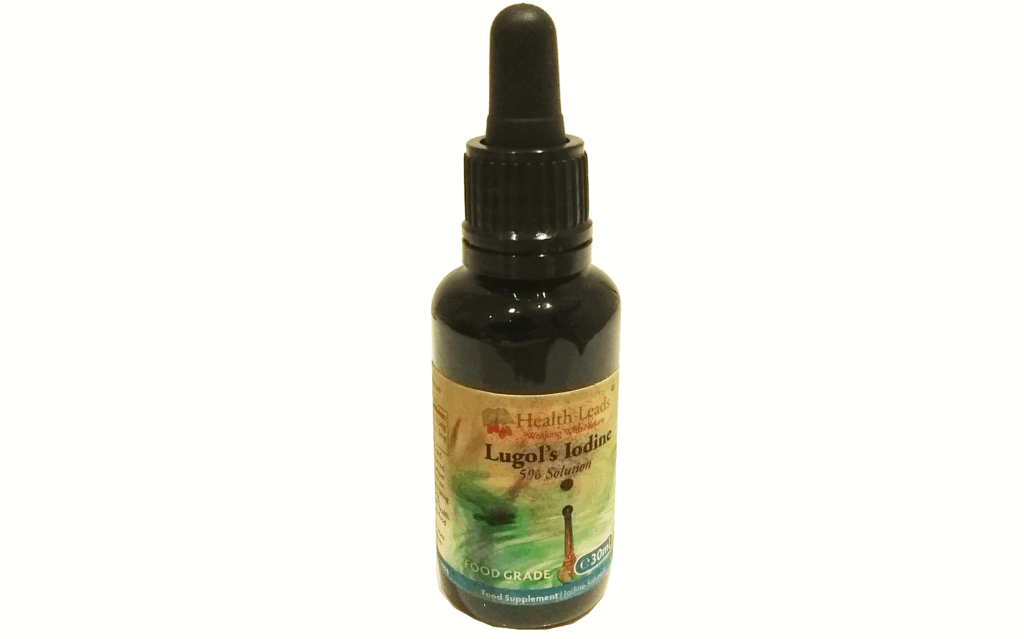
b)1 pinch of Sea Salt, Celtic Sea Salt or Himalayan Salt (which is also sea salt) as these are rich in over 80 essential trace elements also lacking in most diets, human & animal, and most that will not be present in commercial Tortoise food. Remember, that prior to the age of humans / human interference, near enough all water found naturally, anywhere on earth, to one degree or another, was brackish, in other words, it was salty. And. here we are talking about naturally fortified mineral salts, not just sodium chloride on its own. A bit of salt will also offer a slight antibiotic effect.
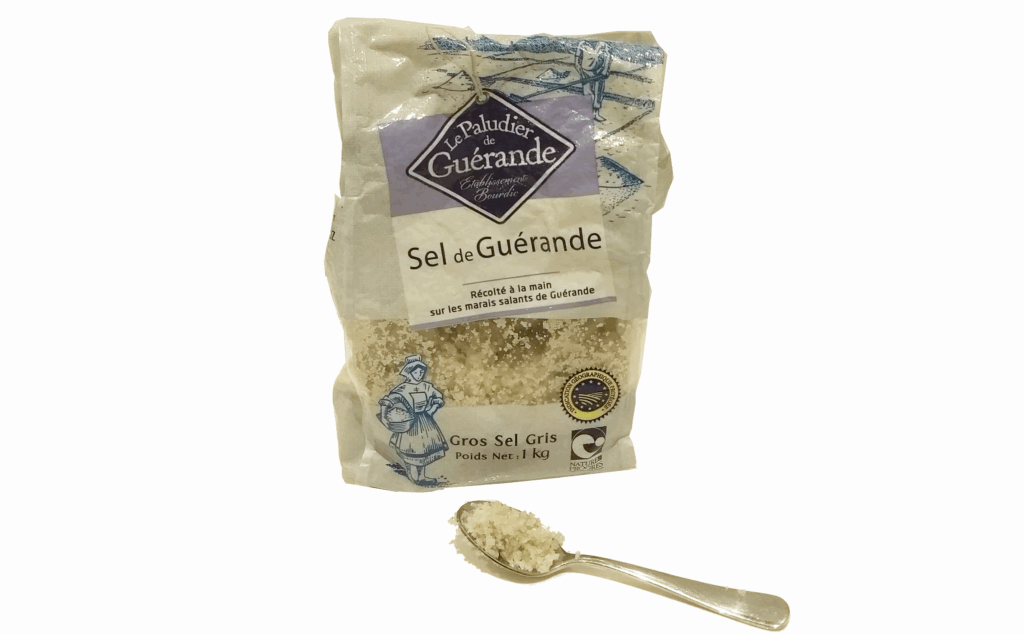
I would also look at adding human grade, clean, no additives Melatonin power if you are looking at a big move or some other stressful experience your Tortoise might have to endure. This MUST be done with the guidance and mentorship of a suitable expert, or diversely knowledgeable Vet, or very seasoned keeper, to avoid overdosing. Overdosing is difficult, but can result in hypothermia, high heart beat rate or tachycardia and or hypotension. Why Melatonin? Melatonin is often used as a medication to calm pets that are over stimulated, neurotic, stressed, hyperactive and or suffering from sleep deprivation. Mostly in cats and dogs. As a natural hormone, it is produced usually in the penial gland found in almost all animals and is critical in regulating sleep patterns and some other hormone cycles, antioxidant enhancement, and… pain management.
Extract from study below
“The efficacy of melatonin as an analgesic and anxiolytic agent has been demonstrated in animals and humans. It has been suggested that melatonin regulates pain via membrane receptors, nuclear receptors, and simple diffusion. Given these properties with few adverse side effects, melatonin has potential as a painkiller”
https://pmc.ncbi.nlm.nih.gov/articles/PMC7012243
Hides
Your exotic / tortoise must have somewhere to hide, a place they feel safe when sleeping or resting, cool or warmer if they so feel, dryer or damper to suit their needs.
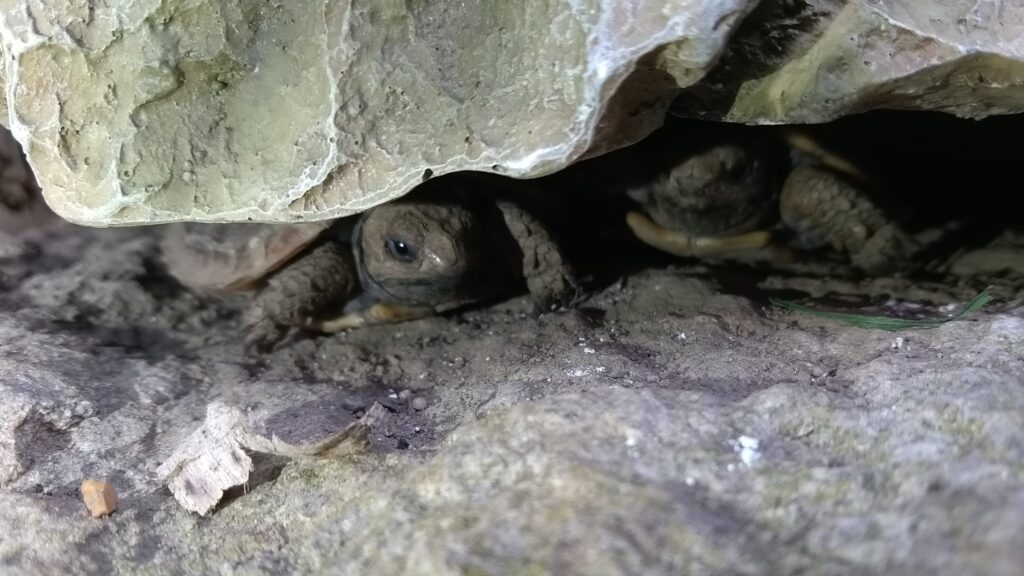
4 or 5 hides per enclosure are best. 1 or 2 hides in the cooler part of the enclosure, 1 or 2 in the warmer part, one or 2 in the middle of the temperature gradient you will need to create in your enclosure. Your tortoise also might not want to use the same house or hide every night. Many animals don’t like to sleep in the same place every night to discourage pests or to look for that sweat spot of temperature and humidity they feel is best, in a changeable circadian climate range.
I put moist Sphagnum Moss in one of the hides, this aids in providing a moist cooler place to sleep, should your tort want this, but don’t use it for longer than a week because of potential infection issues like the fungus known as Sporothrix schenckii. So it’s a good idea to find a regular source for moss in your local woods or park, or pet shop, but can also be found in some untreated lawns.
But Sphagnum Moss has antibacterial and antiseptic properties and was used for wound dressing in wars gone by, like WWI, so is a good candidate for an enclosure. It can also be ingested by tortoises without causing ill effect
https://www.sciencedirect.com/science/article/abs/pii/S0367326X07000822
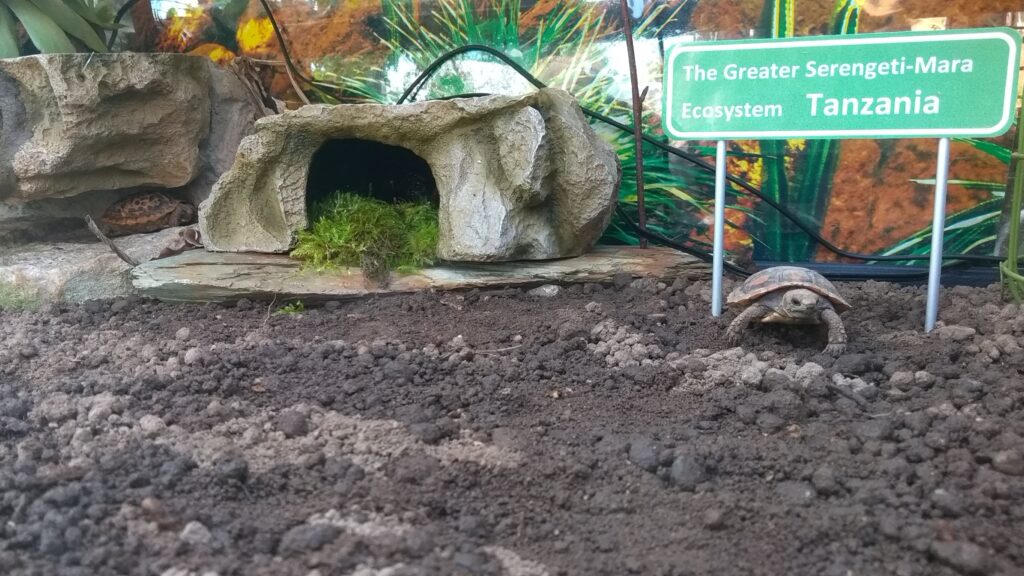
Believe me, tortoises also know when something looks shoddy, and is made out of unnatural or unappealing materials, try to always use natural products as much as possible, but be mindful that natural products can house spores, moulds, bacteria & viruses, so you need to disinfect them to some degree, but don’t use chemicals. Heating sand substrate in the oven is a good way to sterilize a good quality top soil for the bottom of your enclosures. High heat will kill Bacteria, Viruses, Moulds, it will Neutralize most Toxins, and Denature many Poisons – mind you, it can make a few poisons too, but on the balance of risk, heating is better.
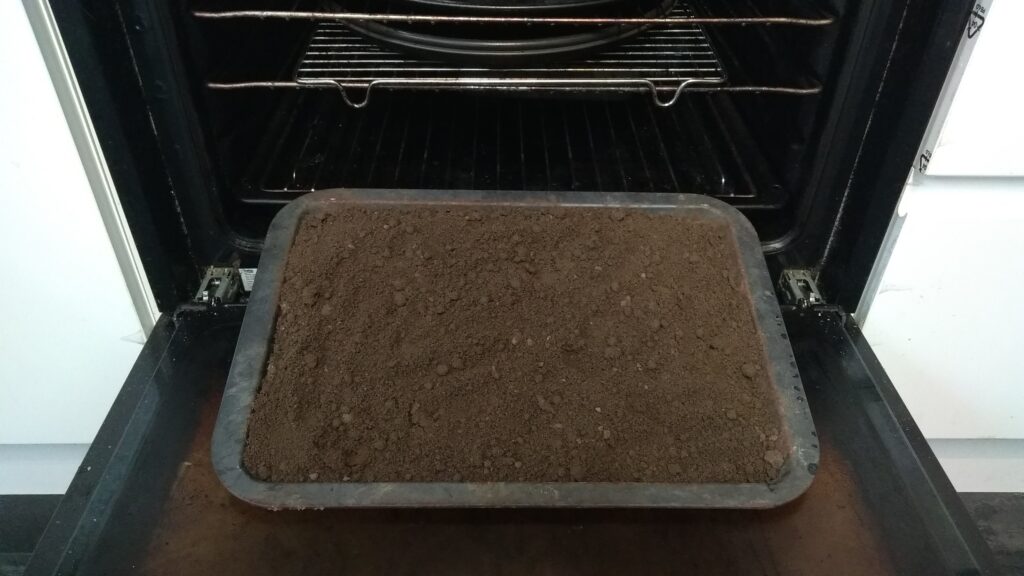
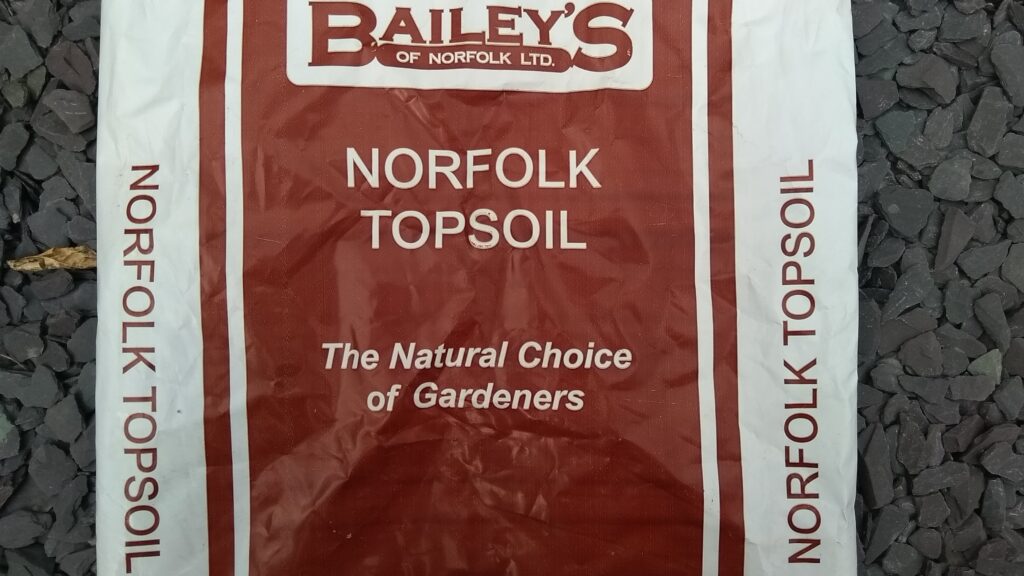
Stone and plastic give off different resonances, as do all other objects in the universe. Humans give off a resonance of about 5 Hz – 10 Hz for example. Concrete, tiles & brick give off different resonances. Keeping your exotic in or around natural objects with resonances they are more likely to experience in nature, will likely aid in maintaining their health. Be careful though, stone is heavy, so care must be taken in constructing hides to make them safe. I use plastic and real stone, with the stone on the bottom.
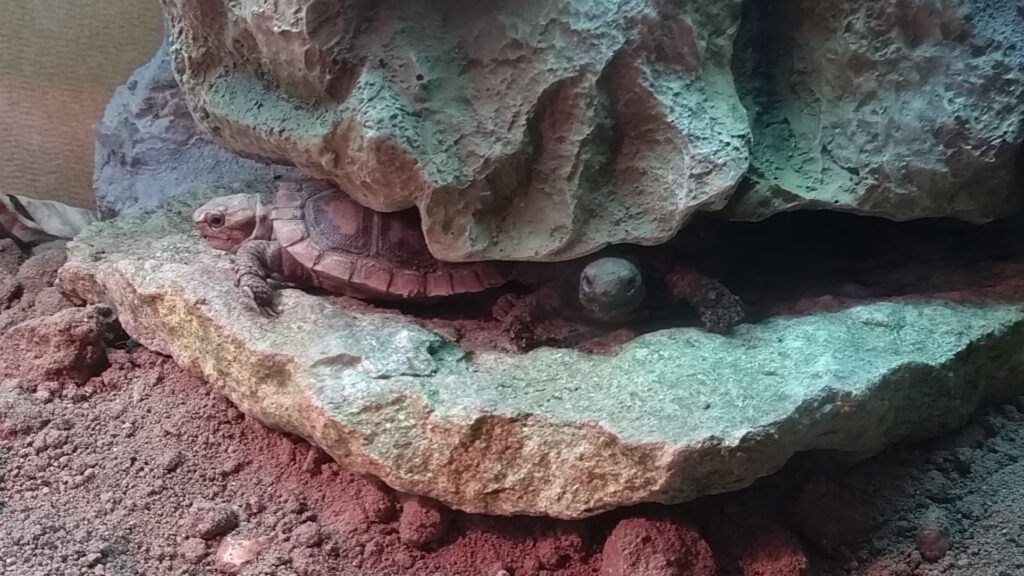
Bioactive Vivs and Tables
Learn how to the make the right substrate mixes for your particular species and what plants you like, but are safe for your tortoise of choice or herp (Herptile) to have in their enclosure.
Learn about different types of lighting, broad spectrum, or plant spectrum lighting, as you should have some edible / safe real plants in your enclosure. Plants will not do well under UV light only, they will also likely dry out and be scorched by your heat / basking lamp, if too near to it. So, in addition to your UV lighting and your Basking heat lamp, you should also have a wide / broad spectrum LED Grow light fixture positioned at the right minimum height. This is good for the plants and likely better for your exotics too. If you can keep plants happy in your enclosure you will likely have achieved a balanced and healthy good environment for your exotic, and thus a well-functioning Bioactive enclosure, with the right humidity, the right lighting, the right temperature & temperature circadian fluctuation.
*Just one thing that needs to be kept in mind, particularly with LED and some UV tube lighting, but indeed all other electrically powered items as well. They all give off RF & EM ‘bleed’ radiation. RF (Radio Frequency) & EM (Electromagnetic) radiation is emitted from electrical appliances and components. The radiation bleeding is highest at distribution feeds like plug sockets and extension adapters, and often quite high from LED and lighting controller circuitry too. This radiation is well known be unsafe. Hence, it is said, one should never sleep with one’s head close to a plug socket. Many with limited understanding will tell you it is not a problem, its best to avoid these types of people, and do some sound deep research into, even mild RF & EM exposure risks.
And remember, your little guys are a lot smaller than you, by body mass, but absorbing the same radiation amounts, you might be, sometimes even more, as they are closer to lights. This is not good.
Keep all your electric plugs and LED lighting as far as possible from plants and particularly, your tortoises. Turn everything that is not used at night off at the wall socket and unplug it from the wall too. Some ‘bleed’ will still travel from the wall socket through wires to the off appliance, even though it has been turned off at the wall switch.
By buying a RF / EMF sensor/ RF Field emission detector and testing your areas, you will be shocked to see how much of this nasty bleed, and wasted electricity is actually emitted.
Excess of water, too much food, too much stress, too much light, too dark, too wet, too dry,too hot, too cold, too noisy will cause adverse effects with exotics, and often will result in death. So, why oh why, would we assume an excess of EMF would some how be ok?
Often, one of the first or second things a Vet will suggest if your Tortoise has abdominal issues, is an X-ray. On such small, long lived creatures, an X-ray should often be avoided as much as possible. This is especially true when considering the heightened RF / EMF they are receiving from enclosure electronics. The study referenced below suggests why we should avoid X-ray as much as possible. And push harder for UltraSound and especially for MRI (Magnetic Resonance Imaging) diagnosis for our pets, instead of relying on X-ray so much, which is very useful but rather outdated. Using MRI though, you and the vet must be sure your tortoise has not ingested a metallic object, as metal, in or around the patient during an MRI scan can cause some very undesirable issues. It has also been observed in Sea Turtles mainly, that MRI scanning plays havoc on their ability to navigate. Animals use magnetic fields to geolocate, this has been know for a long time yet seldomly acknowledged in scientific realms. A blast from a very useful MRI scanner causes prolonged interference with Turtle navigation and is thus detrimental. Sea Turtles, being wild animals, live shorter lives, even though they are considered long lived. The wild, especiaslly these days, is simply not conducive to longevity, and most Sea Turtles never near the 100 years of age they could live to. So, MRIs might be neither here nor there, all things considered, but for Tortoises in captivity, navigation ability is not of pressing importance, and thus, I feel, MRI should be the prefered standard. The more demand we have for MRI scanners the more we will have, the more the better, for human health too. And, they are the safest and most advanced scanning tool we have.
https://www.ncbi.nlm.nih.gov/pmc/articles/PMC7605663/
Plants
Now, plants also need water in ‘water trays’ usually, sitting most of the time with water available to be soaked up into their soil, just as any pot plant. Make sure this water is not accessible to your tortoises for drinking. Bioactive enclosures are the best way to go, but they do require a good degree of diligence and maintenance, as there is the heightened risk of fungus, mould, bacterial or viral infection from stagnant water, if the right balances are not kept. Plants should not be given tap water either, I water my plants from my pond or my custom UVC degrader and Ceramic water Filtering System. Add only Non-Toxic plants to you enclosure – the sight below is an excellent resource for checking safety of plants for tortoises.
https://www.thetortoisetable.org.uk/
This is a lot less of a problem with adult exotics as they will already have a well-developed immune system, but juveniles – which most people will be starting out with from a purely cost point of view, not so. That is why it is always a good idea at first, to consider a rescue or rehomed adult exotic rather than a juvenile.
Heaters, Lights and Humidifiers
Intelligent electronic controllers are really for when one gets a bit more experienced, have a higher budget and are going to keep juveniles and / or challenging species. But if you can, you should start off with the ease of allowing a circuit to regulate light, heat and often humidity in your exotics enclosure, replicating circadian light heat and humidity changes and fluctuations that would be found in their natural environment. Incorrect lighting will cause eventual serious health problems for tortoises, as will too low temperatures & very often the wrong humidity can cause death. That’s why these 3 aspects must be controlled together and with equal importance.
Heaters
*The best heat for you tortoise is the graduated natural radiant solar (sun) & background heat of their natural environment, and the best way to get them close to that is outside, as much as possible. Winters are an exception.
There are a number of ways to heat your enclosures, and in different places
Night time:
Ceramic bulb heaters are a good reliable standard for heating vivs and even tables at night primarily, but also during the day if its cold.
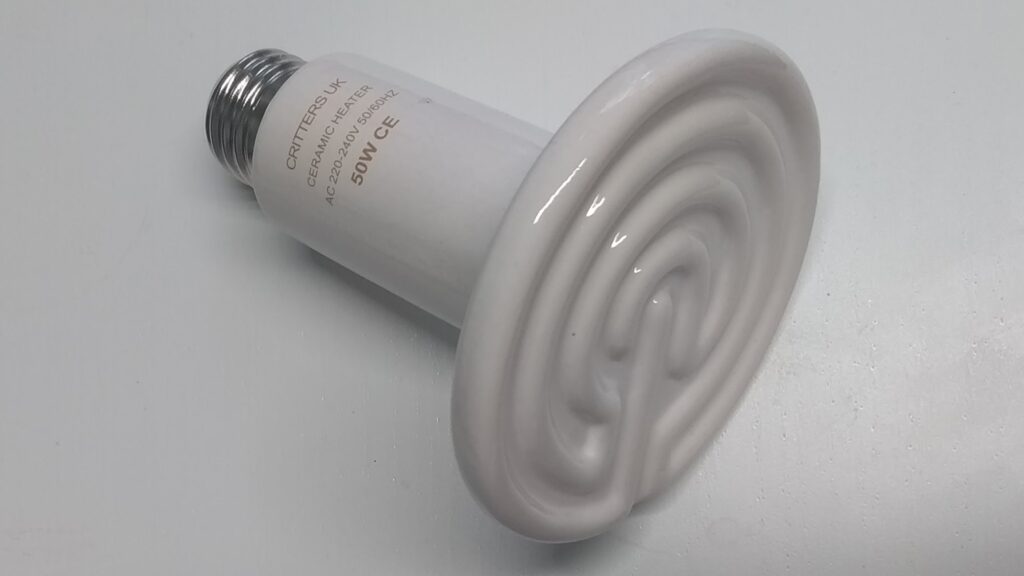
I do add something though, I have not seen anyone else do, and that is to hang or suspend the ceramic bulb over a bowl of water with high sides ( inside a larger lamp shade grill / mesh protection to prevent ‘climbing exotics getting in ) – this serves 3 purposes:
- Provides heat / ambient heat to enclosure – its intended original purpose.
- Prevents any animals from getting under the lamp and burning themselves, or the lamp falling on them by accident.
- Provides Humidity uptake into the air as the lamp will very slightly warm the water below and create a bit of evaporation – keeping up those all-important humidity levels (humidity levels increase significantly at night in most natural environments around the world.)
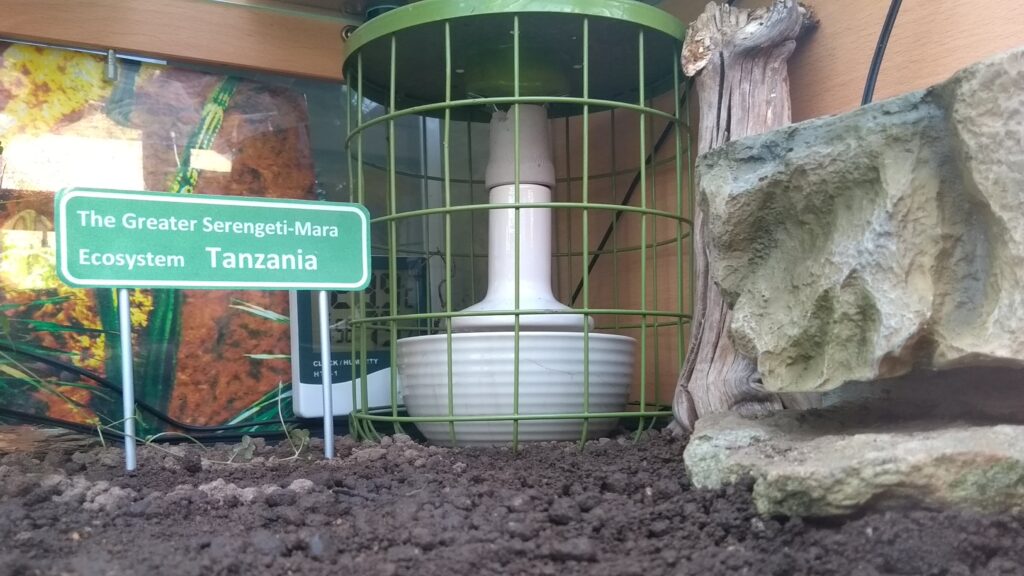
If it is night time where you currently are and it is not raining – go outside a feel the grass or soil, it will be damp to the touch most often – there is no sun to immediately evaporate the moisture and condensation. Tortoises rely heavily on this humidity to keep hydrated while asleep at night and, during the day to some degree too. So misting their dens and hides, and keeping these some distance from basking lamps and other warm lights to prevent overheating and drying out, is pertinent. All the while, forming that temperature & humidity gradient you will need to create across your enclosure, so when your exotic is hot, it can go somewhere cool, and when it is cold it can head over to the basking light.
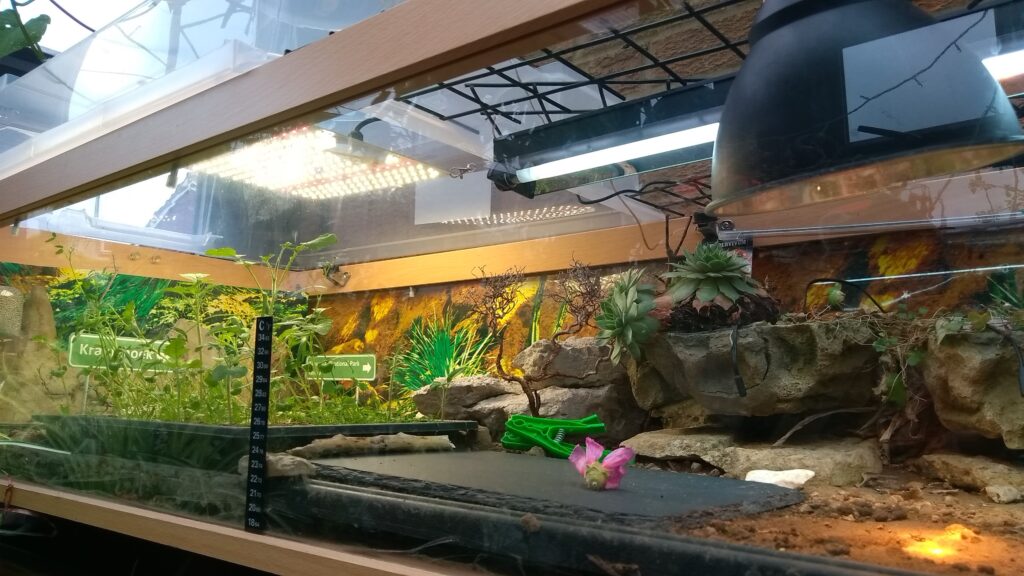
You can also use a Heat Pad or Heat Mat, you can purchase these online or at a pet store quite readily. They are great for cold nights beneath hides or also under thin slate in basking areas during cold days. They should ideally be powered through a Thermostat Controller, so they wont come on when nights are quite hot, but will come one when it gets a bit too cold during the night.
Daytime:
Intelligent electronic controllers are really for when one gets a bit more experienced, have a higher budget and are going to keep juveniles and or challenging species. But if you can, you should start off with the ease of allowing a circuit to regulate light, heat and often humidity in your exotics enclosure replicating circadian light, heat and humidity changes and fluctuations that would be found in a natural environment. Incorrect levels cause all sorts of problems like shell pyramiding, dehydration if too dry, mould, fungal & bacterial infections if too a high humidity, and or without air flow or a little ventilation.
I use among others, Micro Climate products
https://www.microclimate.co.uk/
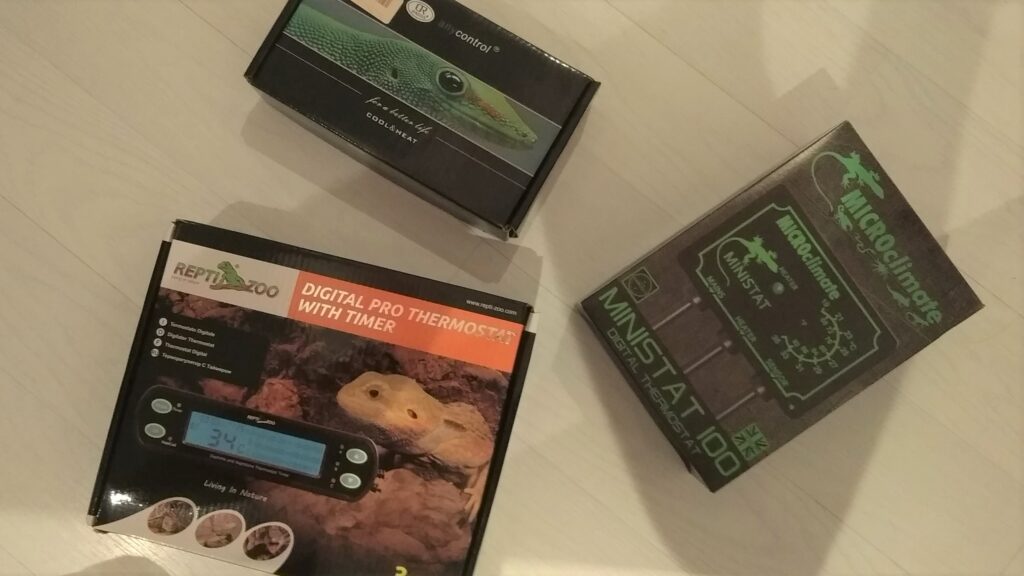
Power or Gas failure back-up for your Tortoises room
While in many places in the ‘Western’ world we are privileged enough to have gas & electricity permanently available… for now, meaning we always have some way to heat our home if we have a electric power failure, or a gas boiler or geyser, as both are unlikely to go at the same time, we should however have a back up plan. I have a small Diesel Heater unit for an emergency.
PIC of Diesel Heater unit
Lighting
UV Lighting. Most important apart from heat lamps. Tortoises, as with most reptiles, need UV (UVA / UVB) light to metabolise properly. UVB helps reptiles, specifically tortoises to synthesize vitamin D3, allowing them to absorb calcium, which is very important for shell and bone growth and egg development in females.
However, UV light helps too, in the disinfection of your enclosure to a small degree, as UV breaks down DNA & RNA in pest organisms, like viruses and bacteria.
It is very important to keep in mind that UV is unsafe for all organisms, it is just that, humans and animals have developed ways to protect ourselves form excess UV by seeking shade, and protecting our eyes and skin in other ways. Thus, UV lights for keeping reptiles are typically limited to 5 – 12% UV emissions per bulb (12% high end is for desert dwelling reptiles)
So, use only officially designated ‘for reptiles’ UV lights. UV lights for disinfection / Germicidal UV lights, water & pool disinfection UV, UV lights for testing bank notes and crime scenes, and UV lights for Curing Resin and Nail Bar Curing lights are definitely not suitable for reptile enclosures, and often emit deadly UVC, not UVA & UVB, which are the wave light length reptiles need.
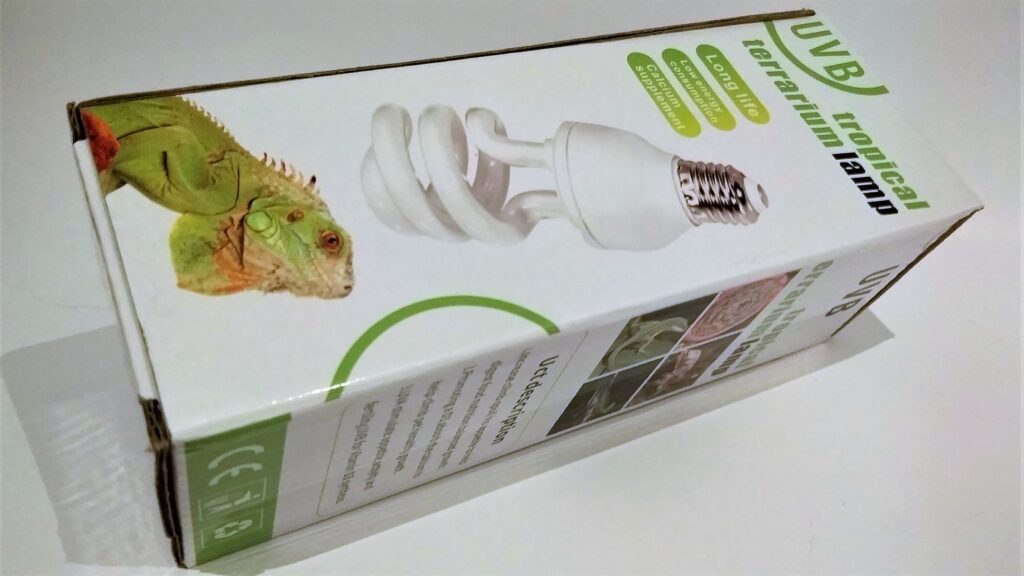
There are excellent, very lightweight and power efficient UV lights out there. I prefer strip Fluorescent T5 tubes as they cast the lighting over a wide area of the enclosure, wherever your tortoise may be roaming mostly, he or she will get enough of that UV. They are small / narrow and relatively energy efficient tubes. Fluorescents are being phased out for general lighting because of environmental protection, but not necessarily for specialist use, at least not yet, specialist use such as horticulture & Herp husbandry use, but we may need to watch this space, they however remain my favourite by far. Although, please be aware they do emit a lot of RF bleed radiation and they are also not all made equal, and may emit unhealthy levels of either UVB or UVA. Ideally, getting someone to test your lights or buying UVA and UVB meters yourself is best. Here is a link to our Advanced Keepers area, with a bit more on UV Lighting here then please return to this section to finish our bit on lighting.
https://www.neorep.net/product-category/reptile-lighting-fixtures-fitting/
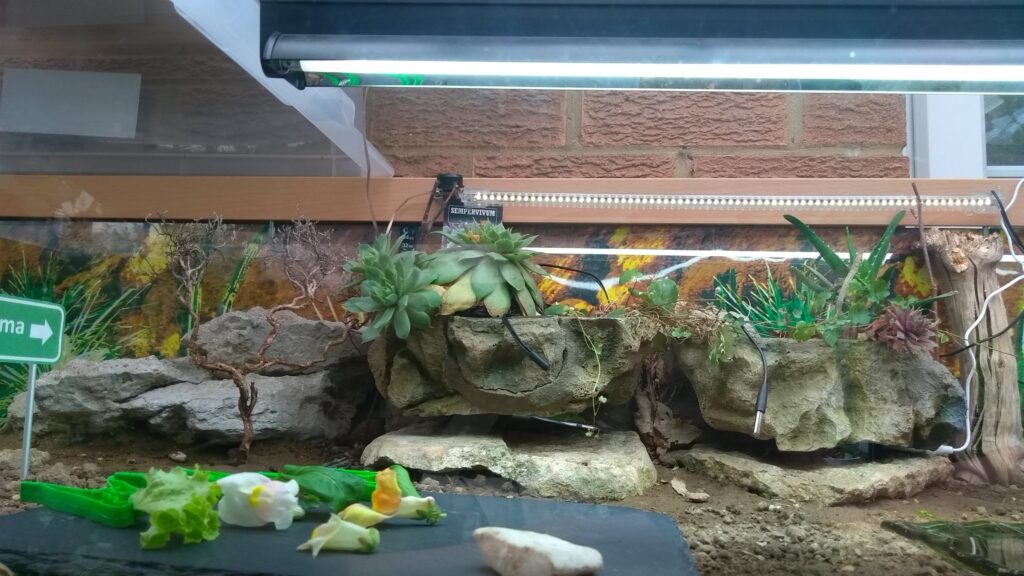
UV is only emitted from lamps sufficiently for about 6 months to a year at the most, so they need replacing, at very least, every year. You can keep an eye on the UV levels of your particular lamp by using a cheap card such as the one below. A blue dot will begin to appear in the presence of UVB light in the test area.
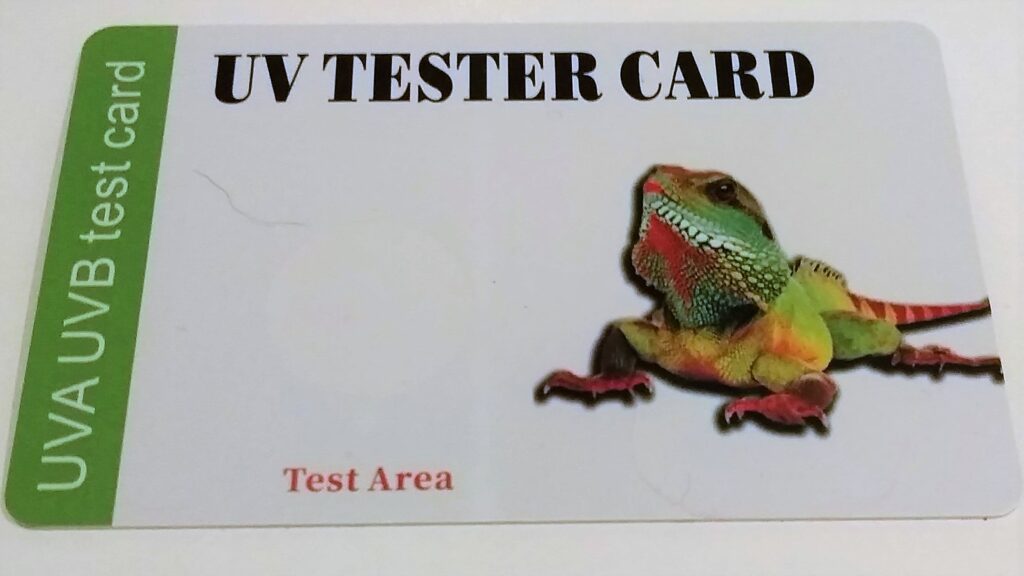
Please be aware, some small UV fluorescent lights can be mal-manufactured and can actually burn reptiles eyes. It is hard to be sure if your chosen light is causing an excess of UV light discharge without a very sensitive UV meter, but one sure sign is cracks in the white phosphor / powder internal layer (and not the outer glass) in the tube of the light – this allows too much pure UV light made in the tube, to get through the white powder or phosphor breaks, without being converted to the visible light we use to be able to see in darkened places. How the lamps work, is they make UV light deep in the tube which is not visible to humans and most other life forms – so useless. But, a layer of white powder called phosphor coats the inside of the glass tubes and converts the UV light to visible useful to see with – normal light. If this phosphor layer is not present on any part of the inside of the tube it will allow too much UV though.
This is why, wherever possible, your reptile pets, and indeed any pet, should have access to pure unfiltered natural sunlight for at least a few hours a day.
*Please note: phosphor is not the same as Phosphorus (as in the dietary supplement
Basking Lighting / Lamps. These lights are for day time only use, and only need to be in one place, and you only need one. If it happens to burn out while you are at work or out, it is not the end of the world and could mimic an overcast day, so you don’t need redundancy with this aspect of your enclosures lighting. However, this lamp will be providing the lions share of heat to your enclosure often, unless you are also relying on house central heating, Ceramic Heat Lamps and or Gold Halogen Infra Red lamps or Deep Heat Projectors DHPs / or using mild (responsibly used) Heat Mats to keep your general temperatures up in your enclosure, especially in winter.
So, you should have your night time ceramic bulb / heat lamp heater / Gold Halogen IR or Deep Heat Projector or Heat Mats connected to a thermostat controller that will turn the ceramic heater on, the moment the temperature, even during the day, in the enclosure, drops below a minimum you have set – which should be around 22° C (72° Fahrenheit) down to 17° C (62° Fahrenheit) at the lowest and or at night, but dependent on your species.
What Heat Basking Lamps are best? Well your local reptile store or pet shop will have suitable basking lamps for your use, but a very professional set up would ideally use Sodium Lamps or Halogen Lamps, which are suitable incandescent lights (incandescent means heat emitting) Or, Mercury Vapour basking lamps, which also provide and can give off appropriate UV light.
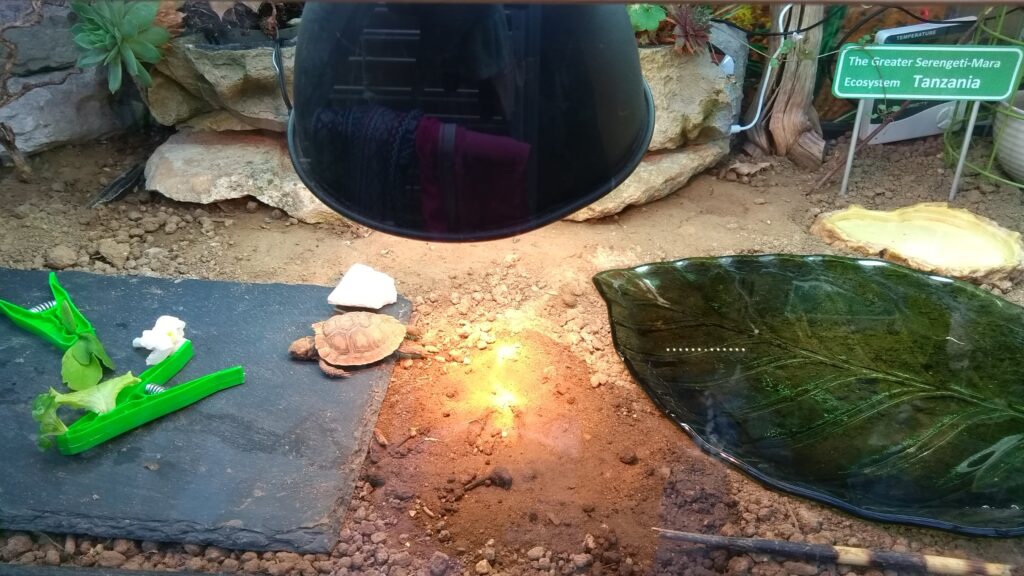
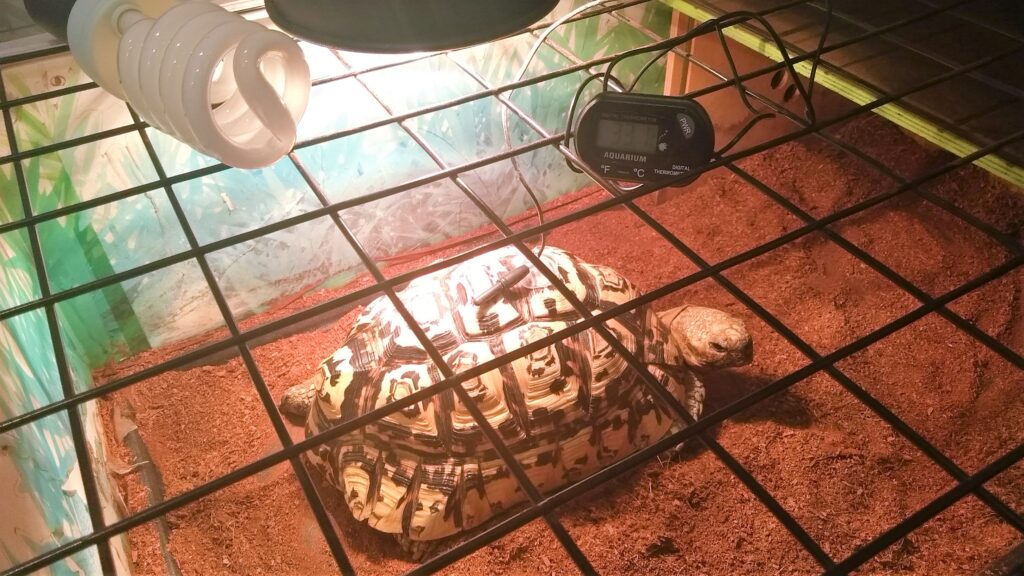
For an even more professional and responsible set up Sodium Lamps (High Pressure Sodium Lights or HPSs) and Metal Halide MH HIDs (either CMH – Ceramic Metal Halides or MH – standard Metal Halides) (These are for the daylight range of lighting) HID stands for High Intensity Discharge. And too, Gold Halogen Infra Red lamps. (Gold HIRs are for the Infra Red range of the suns wavelengths) These HPSs & MHs and the Gold HIR are actually the closest to the suns light you can get in advanced traditional lighting, so they are used often in commercial green houses for good plant growth. They are preferable in their elongated Double Ended form (MH HIDs & Gold HIRs) as this spreads the light more, and covers a bigger area. the RX7s Double Ended Ceramic Metal Halide lamp and specialised housing is a good example. Don’t use anything higher than 70watt… unless you are housing adult Sulcatas, Aldabra’s or Galapago’s Giant Tortoises. Gold HIRs can be a slightly higher wattage though. All these lights are also relatively energy efficient. They are perfect for a larger bio-active enclosure. However, they can get very very hot, so need to be protected from being bumped or burning anything near to them, they should also be at least 800mm away from anything. They emit UV at unhealthy levels, but this is mitigated under normal safe operating conditions by the glass they are contained in. They also contain mercury, which is toxic, so they need to be protected from damage, and disposed of safely, when no longer usable. They are being phased out as standard lighting and will become harder to acquire in the future. For a broader spectrum of Infra Red ( IR ) primarily IR A & IR B, the use of a Gold Lamp, usually found as a Double Ended r7s bulb like the ideal Tungston Halogen bulbs is a good idea.
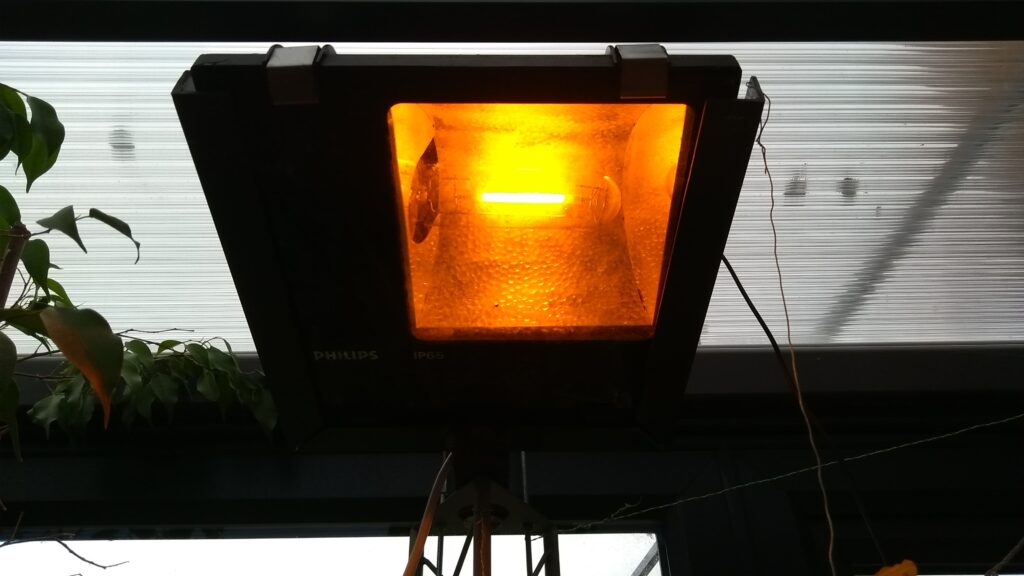
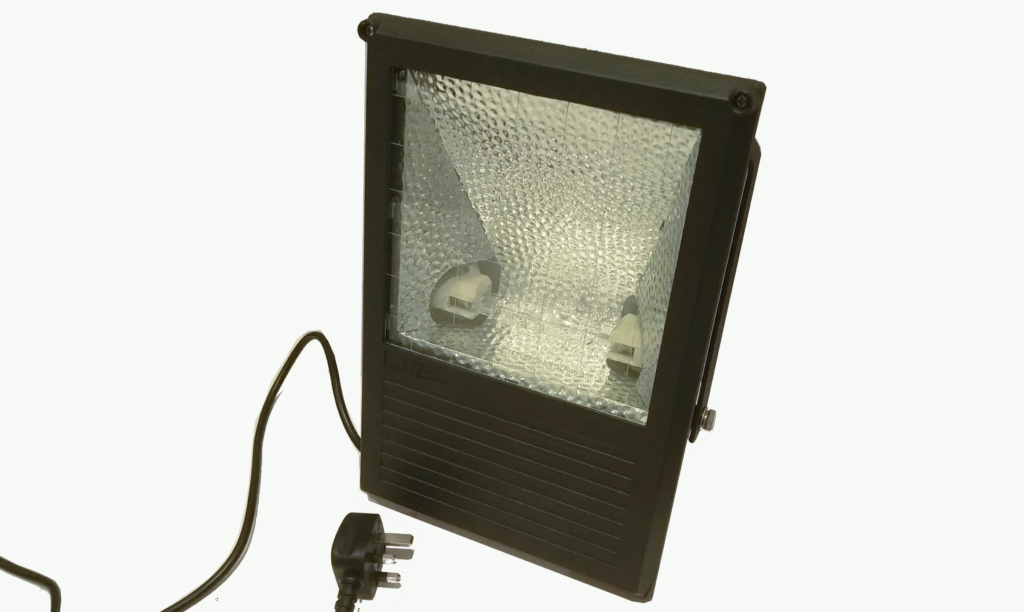
For a broader spectrum of Infra Red ( IR ) primarily IR A & IR B, the use of a Gold Lamp, usually found as a Double Ended r7s bulb like the ideal Tungston Halogen bulbs is advisable, both bulbs are Halogen, but for the gold coating on the Gold Lamp. Infra Red light is very important as well for exotics kept indoors. The Gold coating on the R7s lamp allows IR to pass through while blocking most of the Visible light, very useful for heating at night. In nature, rocks and the ground will absorb Infra Red during the day from the the sun, then irradiate that heat off at night, so, it is a natural holistic experience for your exotic.
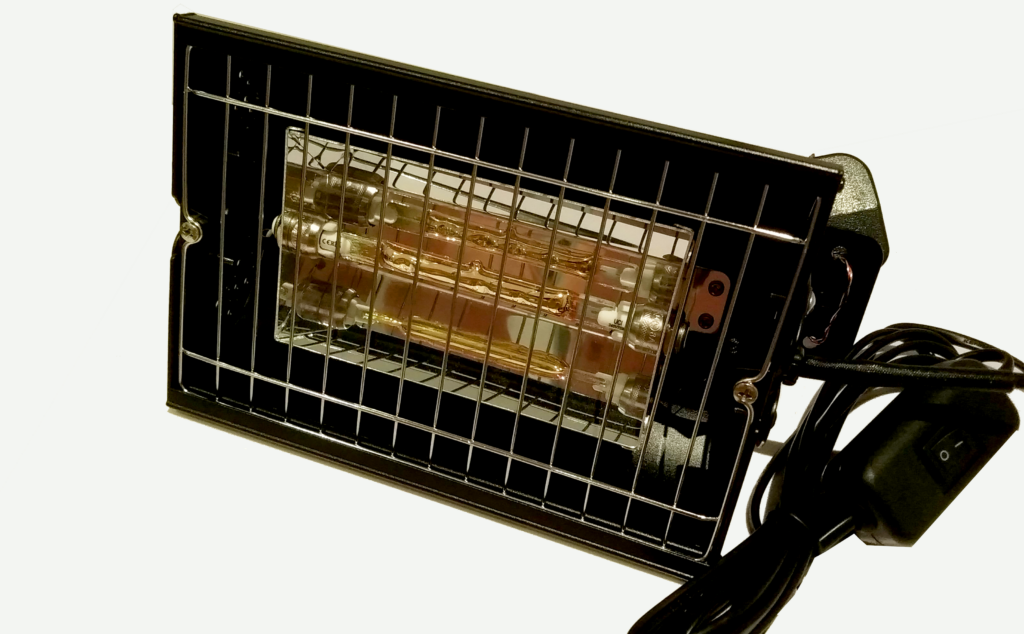
With a 100 watt bulb, very good for sick and ‘under the weather’ tortoises as it delivers deep Infrared warmth in the range of thermal radiation 780nm – 50,000nm and above. The ideal is IR-B Infrared B @ 1400nm – 3000nm 3000nm – 50,000nm is considered Infrared C
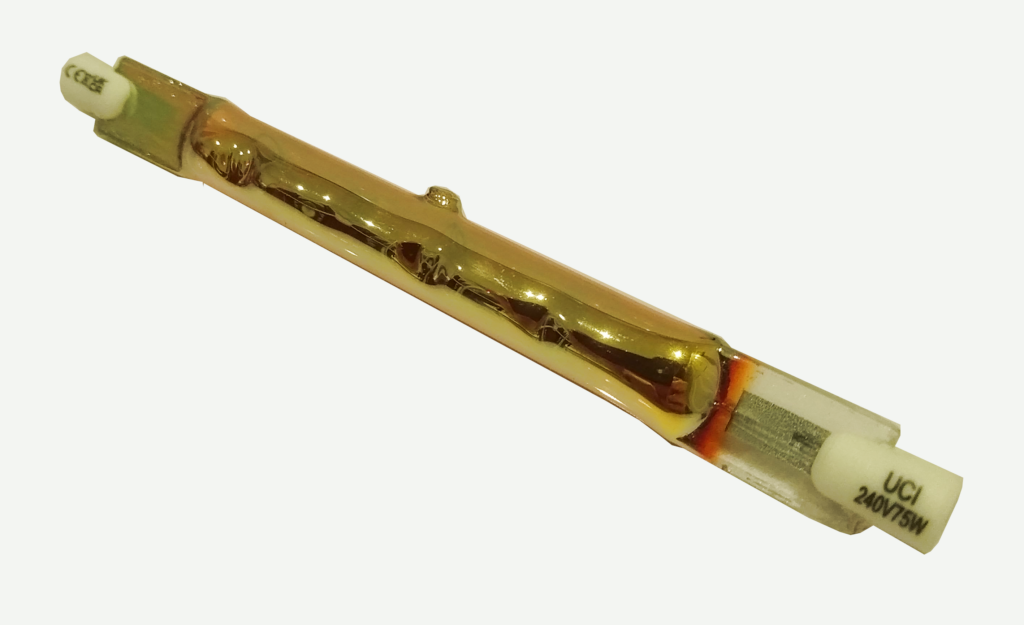
Please take care to make sure your lamps are very securely attached to their holders, lamps can fall off and burn pets badly, and they can also start fires, they can also burst causing small glass fragments to go everywhere, unless they are encased.. which Gold Lamps are not as ordinary glass covers would not allow much of the IR to travel through.
With all things I make and build, I do a little risk assessment and use a minimum of 3 unrelated safety features to ensure things cannot harm anyone or anything. With a lamp set up, this can be: Ensure the lamp holder is not damaged in anyway and all screwed together tightly. Wrap the cable around the stand holding the lamp fitting a few times to further guard against the light falling into enclosure. Provide a grill of some sort underneath the light to again prevent it falling. Attach a length of steel wire around the light holder and secure the other end of wire to something else stable.

Variable intensity LED Grow lighting
These are for a more natural broad spectrum modern light to compliment your UV and Basking lighting, but mainly to assist the health of live plants in you enclosure. They are widely available, mostly made in china, and mostly in a small number of factories that will provide OEM manufacture to a large number of ‘brand names’ So, don’t be hung up on buying well-known brand names which can be quite pricey, as they are often essentially the same items as the cheaper offerings found on, say AliExpress or Temu.
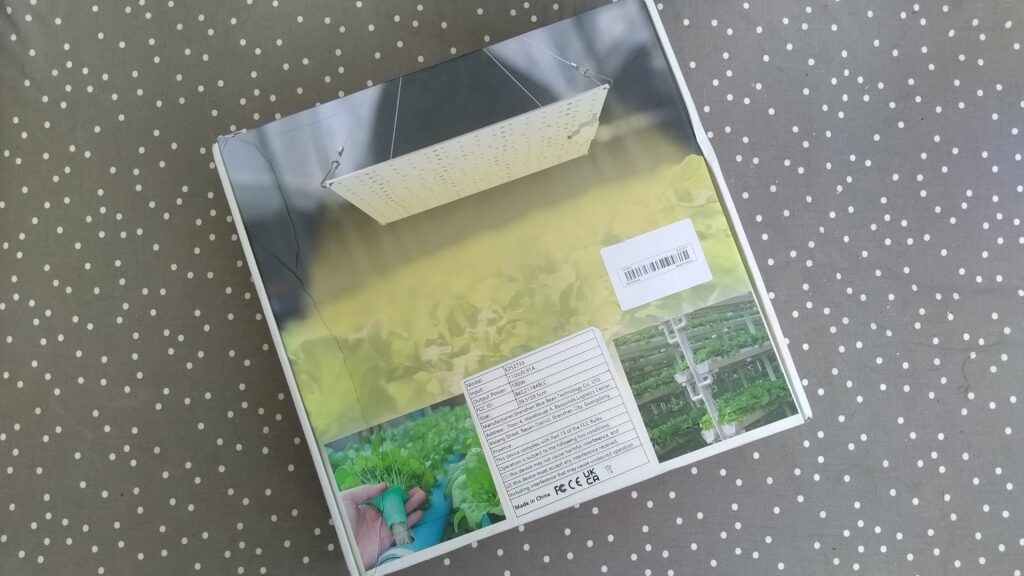
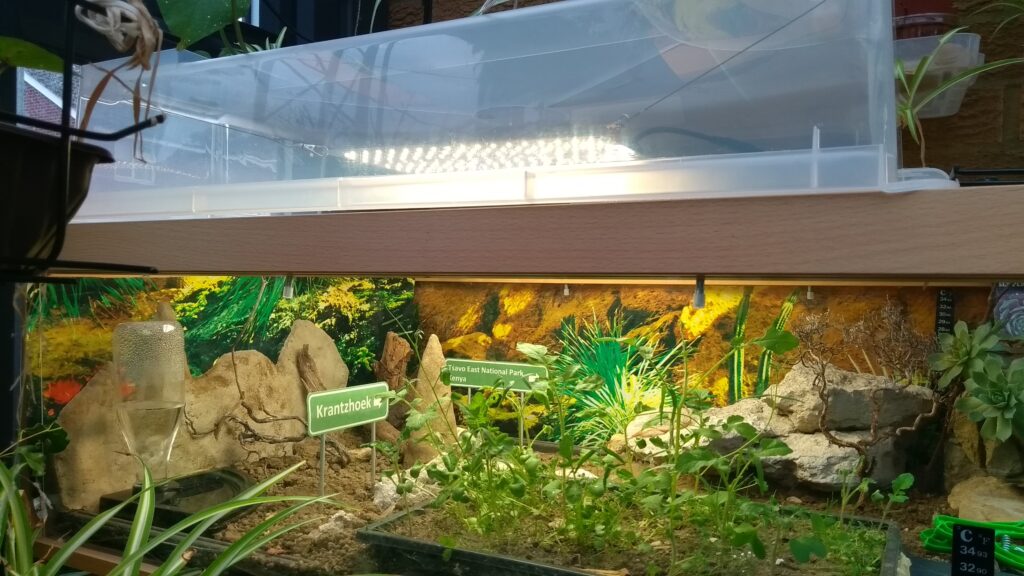
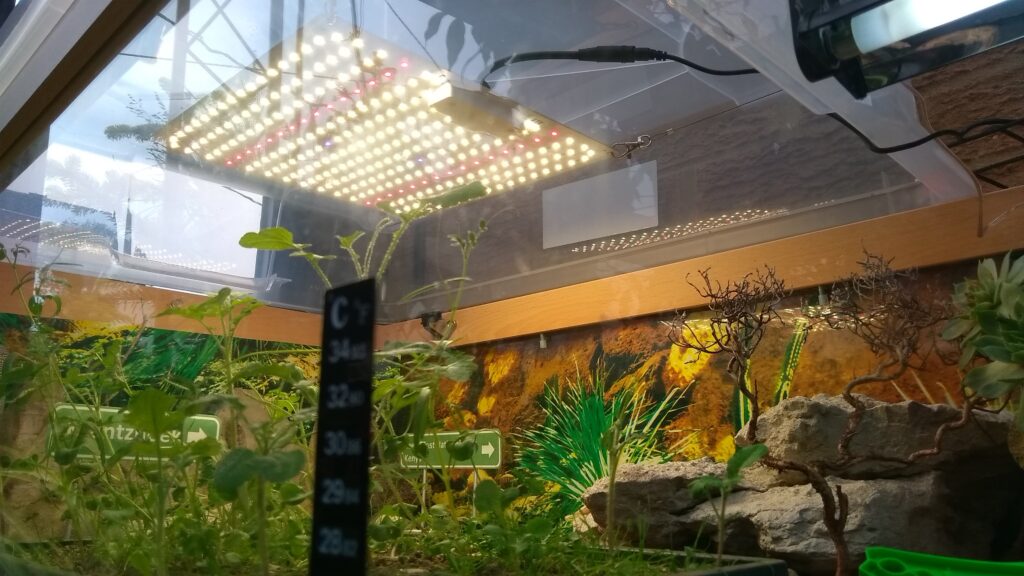
micro environment

Air Flow
Air Flow is important in Enclosures and Tortoise Tables that are not open completely, especially during the day. In the above images, you will see that in the canopy / cover, is mounted the relatively permanent Broad Spectrum LED light fitting. Although this is often turned off when it is exceedingly hot and sunny, it is a good idea to mount a small fan into this bulk head plastic cover / canopy to move hot air out slowly. A bit of air flow will also move away some of the bad positive ions created by Electrical Equipment, hopefully replacing them with good for the body and spirit Negative Ions.
https://holisticlakewood.com/when-a-negative-is-positive/
Now, you don’t want a wind or a gush of air in your enclosure, as this can cause respiratory problems in you exotics, it can also cause your micro environment and plants to dry out quicker. So, use a very small fan. The one I use is a very small 5volt DC fan, run off of a small solar panel. If the sun goes in, the fan will slow down or stop, creating variable airflow, which is ideal. When it is hot, the fan spins faster to alleviate heat build up a bit a bit more.
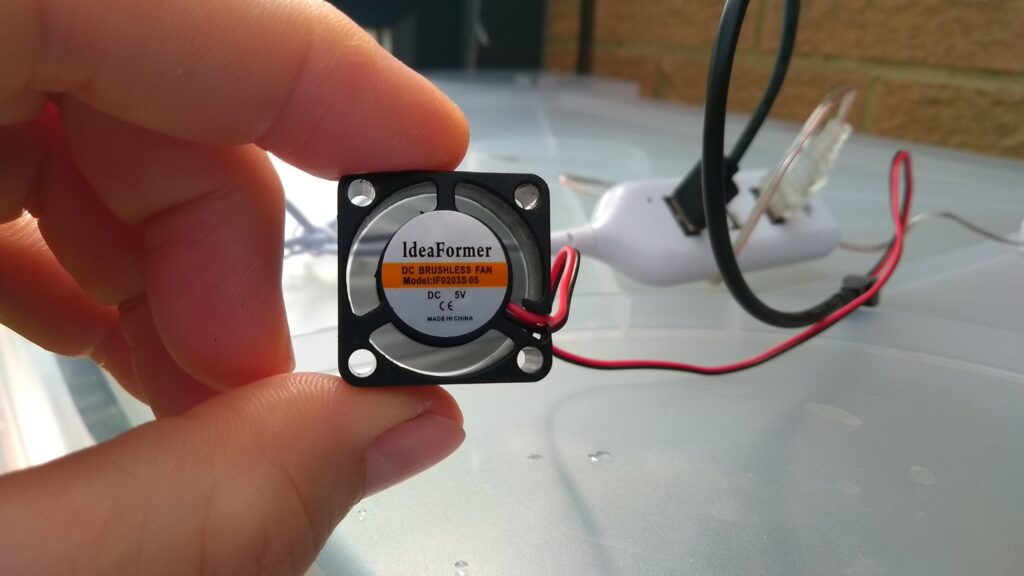
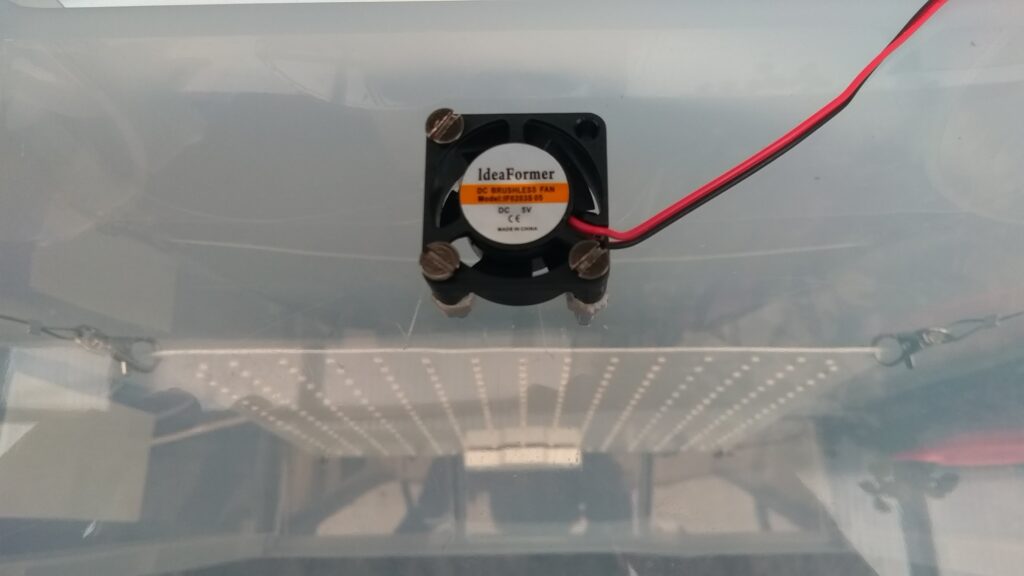
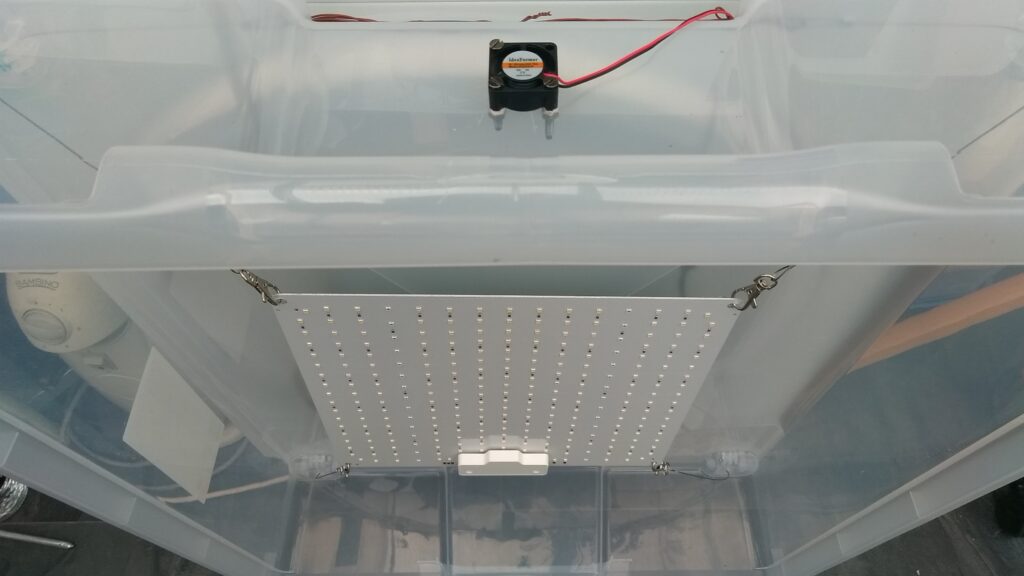
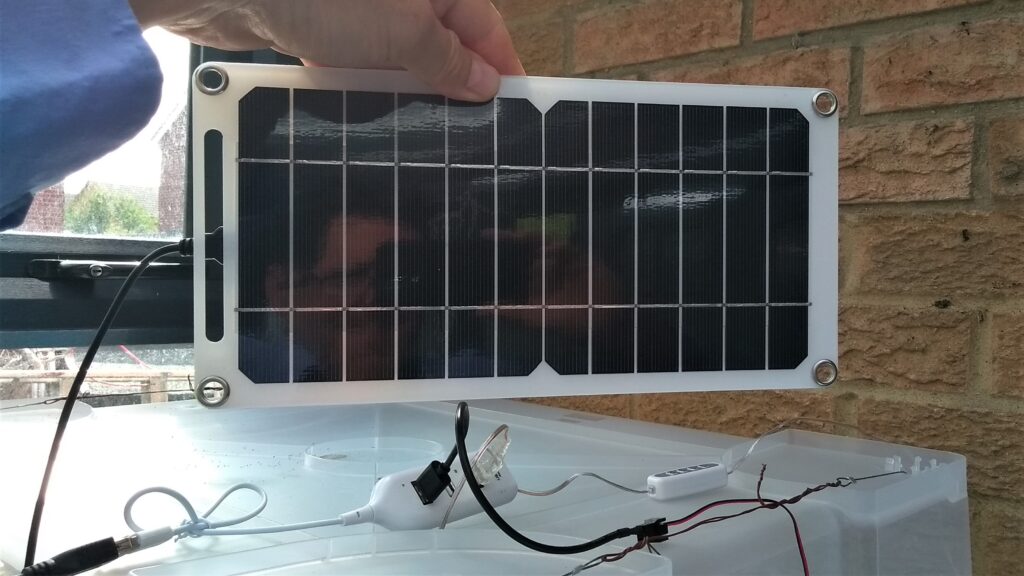
Humidifiers
I have not been overly enthused by humidifiers and misters for tortoises, because of their inability to create a diverse micro droplet size that would be found in nature. This is especially true of most ultasonic Humidifiers.
But, their are a couple of very rare species of tortoise that require a sophisticated humidity regime for their care. These are the Egyptian Tortoise and the Negev Desert Tortoise. They live in extremely dry and arid regions of North and North East Africa along the Mediterranean Sea coast line. The Negev is limited to a small patch of desert in Israel, often considered an Egyptian Tortoise, the Negev is extremely rare if indeed considered a separate species.
They reside in very dry and arid conditions, but reasonably close to the Mediterranean Sea. This is important as coolish sea breezes bring in moist, albeit salty air, inland, which is crucial for providing humidity to these tortoises. General Misting and dampening is not advised in enclosures for these little guys as they can pick up respiratory infections easily, but humidity levels need to be reasonable, around between 80 – 90% in their overnight humid hide & 30 – 60% in the rest of the hides and enclosure as whole, where humidity can go as low as 30% under the basking lamp. Remember juveniles will always need higher humidity. And, individuals raised in low humidity, although not good, will be acclimated to the low humidity, so increasing it to a more healthy and realistic level will result in ill health, so care needs to be taken when acquiring non juveniles.
The sea breezes and winds of heavily saline bodies of water such as Lake Bardawil in Northern Sinai, often brought in early morning and at night, are likely providing species such as the Egyptian Tortoise with some form of natural halotherapy (salty water vapour therapy) and likely providing a source of iodine too, which is deficient in the human diet very often, and in Tortoise diets, I would has at a healthy guess.
Salt is also a natural disinfectant and a natural anti-inflammatory. It helps water evaporate faster if the evaporation process is through heat (better than cold evaporation) Water vapour molecules are also held further apart in the air by salt, facilitating easier evaporation, and thus efficiency of the humidification process. Now, getting salt into the air cannot be done with heat evaporation only, there needs to be mechanical means to create ‘spray’ or larger multi size droplets that would contain salt ( as would be the case with wind picking spray off of waves on the sea and off salt lakes)
The best way I have found to replicate this, is boiling salty water on occasion in a suitable, safe set up inside the tortoise table, while tops / covers are on or otherwise enclosed like a Viv, to hold the water vapour / salty air in. This aids in not requiring the enclosures terrain be sprayed or moistened much, to keep humidity levels up, at night especially. As said, spraying or dampening can be detrimental to coastal desert species that are used to, and require a dry’ish environment, apart from receiving humid sea breezes, especially at night. This keeps the air relatively humid but does not soak the ground or substrate much (which can, if accompanied by a unusual drop in temperature in the enclosure for whatever reason, cause quick onset of respiratory disease & death in sensitive species)
The boiling also warms the Vivarium and this warmth can stay for quite a while in the enclosure, and replicates the warm, slightly more humidity in early evening of the Mediterranean coastal areas.
*The boiling process only needs to be carried out for 2 – 4 minutes in a medium to smallish viv, in evening, and perhaps 2 – 3 minutes early morning, if you are keeping a coastal desert species. If you are going to do this, a good technical knowledge of electronics, timers & Safety, safety, safety, is paramount – use a cut- off timer with double redudancy on the heating system, make sure it is set to not more than 5 minutes to cut-off, even if you are watching and present during the process. Make sure the element does not lie in settled salt at the bottom of the cup – element / cup heaters usually have a little hook to hook to the side of cup. Make sure the water level in cup is just just right each and every boiling, so as to prevent boiling over and prevent burning out if not enough water covers the element.
In the Summer, in our conservatory, where it gets nice and warm fast I use a sprayer system that comes on for 10 seconds in the morning & 10 seconds early evening, to add that humidity. Dry air can cause respiratory issues in humans and animals, so humidity for tortoises, even desert species, needs to be closer to 90% than to 0% and most especially at night.
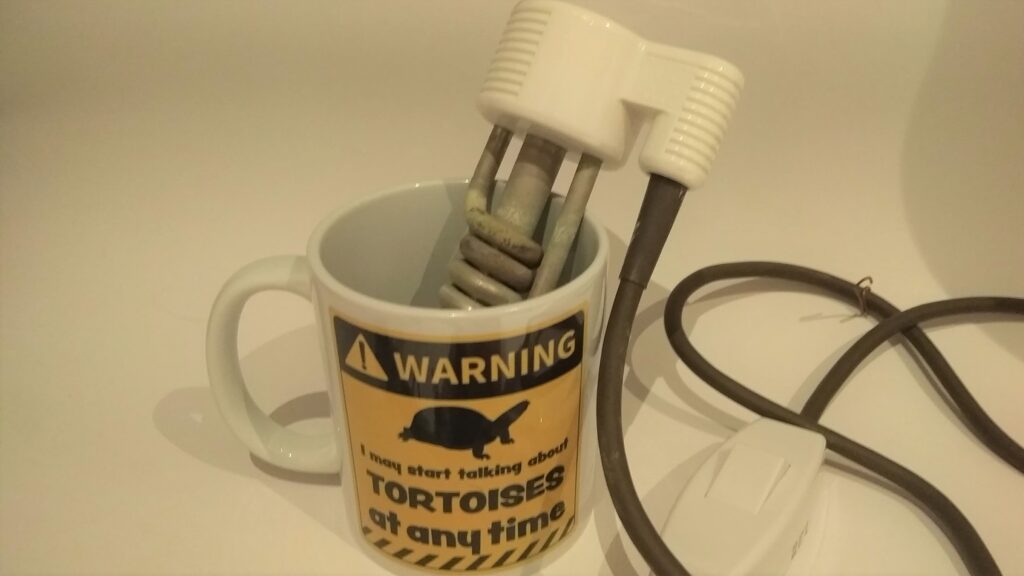
One other important thing this particular procedure does, is release all important Negative Ions into the air of your enclosure. Herp Enclosures have an over abundance of unhealthy Positive Ions in them, mainly from Electrical Equipment, which is really not healthy. The boiling of water, like a waterfall, causes water to collide with itself, releasing Negative Ions in whats known as the Lenard Effect. But, heating the water to cause Steam does this too, and too, so does the Salt also release Negative Ions. Salt is also released into the air by the rather violent boiling process, creating the Halotherapy effect. *Not that much salt is released so don’t worry about making your enclosure into a salt pan.
https://www.webmd.com/balance/features/negative-ions-create-positive-vibes
This is why being on the beach or at the sea is considered so healthy and invigorating.
https://www.allwayswell.com/blog/ionization-of-waves-near-the-beach
Celtic Salt, Himalayan salt, Dead Sea salt, Black Salt or Epsom salt can be used.
A Halogenerator or Saltifier for Halotherapy, which puts the microscopic particles of salt into the air, is also an option, in conjunction with some form of humidifier naturally. Halogenerators are pricey though.
https://charterhouse-aquatics.com/shop/exotics/humidity-and-misting/foggers UK distributor
Simple varied size water droplet humidification is easily done with a protected & ‘safe’ water boiling device or set up, such as simply placing a camping mug water heater inside a mug and covered with a protector to prevent insomniac exotics from venturing too close. Use a cut – off timer with double or even triple redundancy, as these camping boilers burn out easily. They are also not easy to come by as a result of user error safety concerns, but can be obtained online. They are safer used for this purpose than for heating a mug of water on a camping trip though. This set up will produce a wide range of droplet size (the widest in fact) which is important for a good night time misting. and if using salt for certain species, it will get some of that salt into the air too.
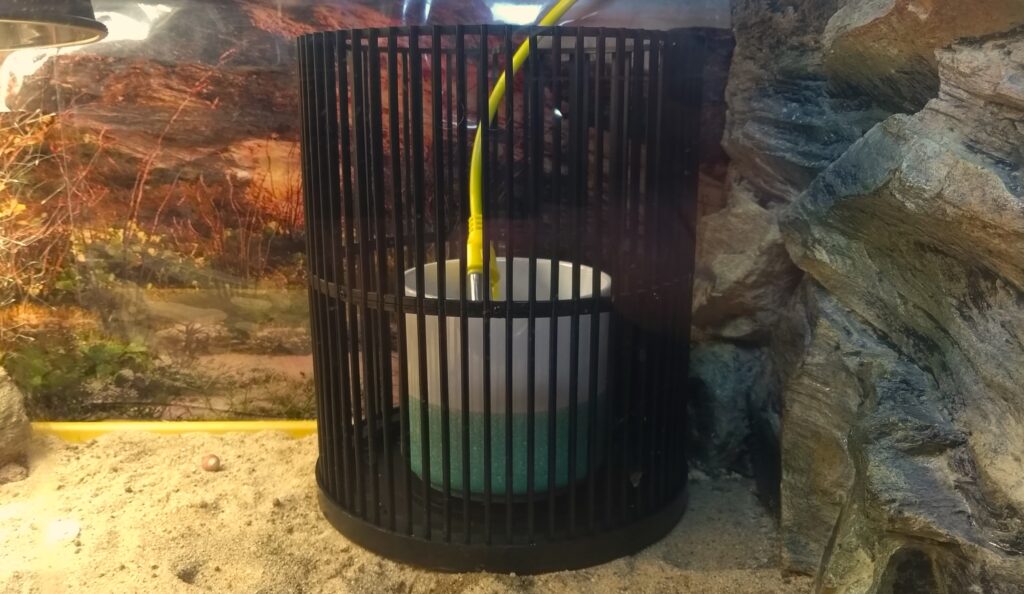
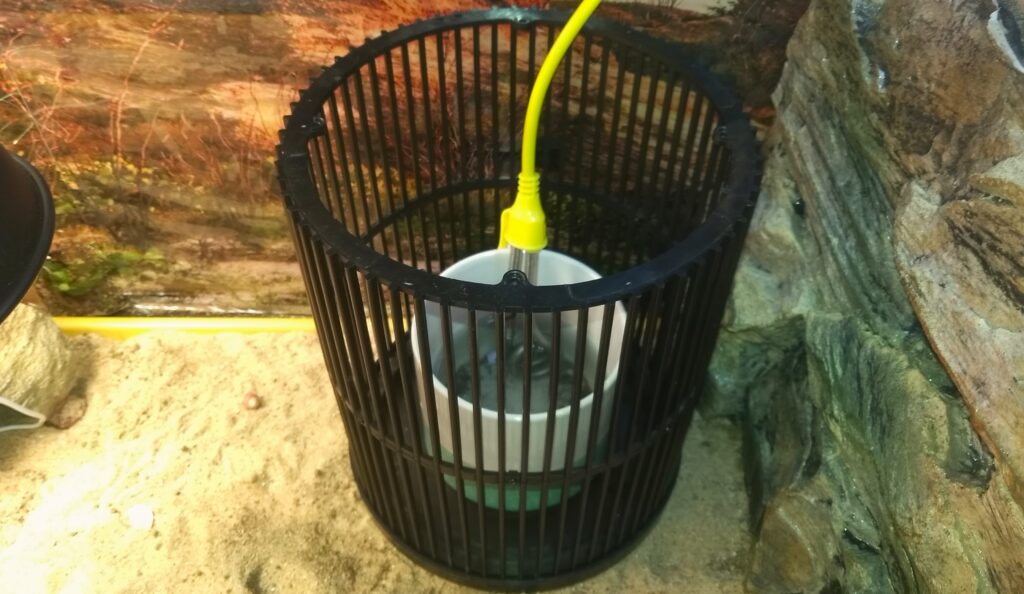
Substrate / Bedding
It is important to use the right bedding and substrate for your tortoise enclosure.
Something that will soak up Urine is ideal, Tortoises wee a lot, this can be smelly, but it is not as bad as urine from Omnivores & Carnivores. A useful substrate that is popular with many enthusiasts is Coir, coir is desiccated and milled part of the husk of Coconuts, it is a great option. It can be ingested by tortoises with relatively little potential harm. It is also great for holding onto a little moisture to keep up humidity levels- don’t dampen too much though as mould can grow in coir too . Coir can be a bit more dusty though when dry, if keeping your adult desert type tortoises free from over exposure to moisture, but it is a very good medium and just goes into your compost bin after your weekly / monthly clean out, or when soiled by you tortoise. It will nicely hold onto moisture when it eventually gets used in your plant pots or vegetable garden, and is used extensively in horticulture.
Tortoises must also have use / access to hard standing of some sort, stones, or stone slabs or concrete paving in some of the places they will roam, and eat. This is very important for wearing down claws, and beaks when eating. These parts of tortoises are always growing and need, and are designed for continual abrasion and wearing down.
Below you can see that our tame indoor Leopard tortoise has nicely worn claws, but they are not too worn, so a balance will need to be worked out in your table or run enclosure so that not too much wear is experienced.
Long claws can get caught in things like fencing and wooden barriers, and can result in an unpleasant little injury.
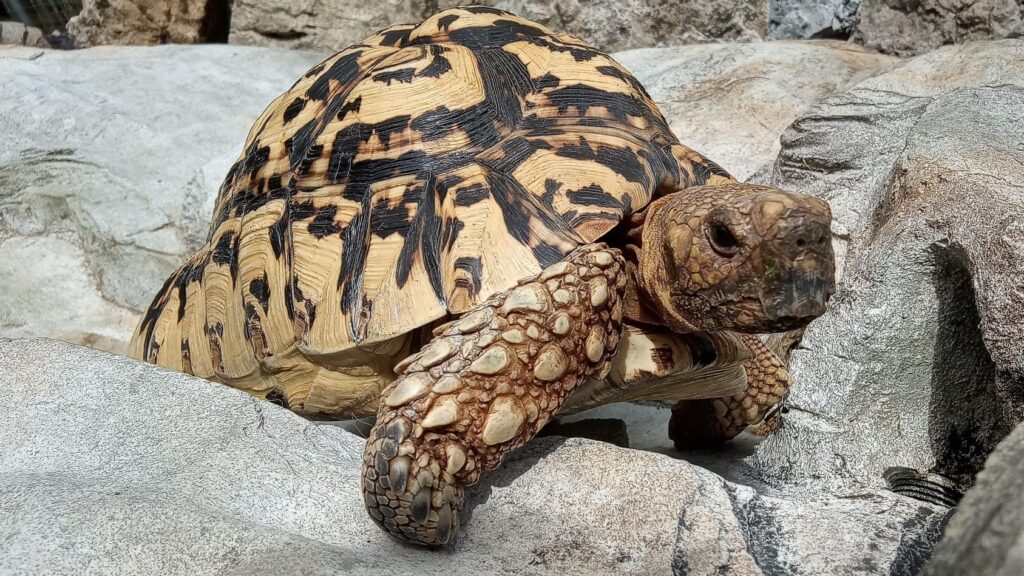
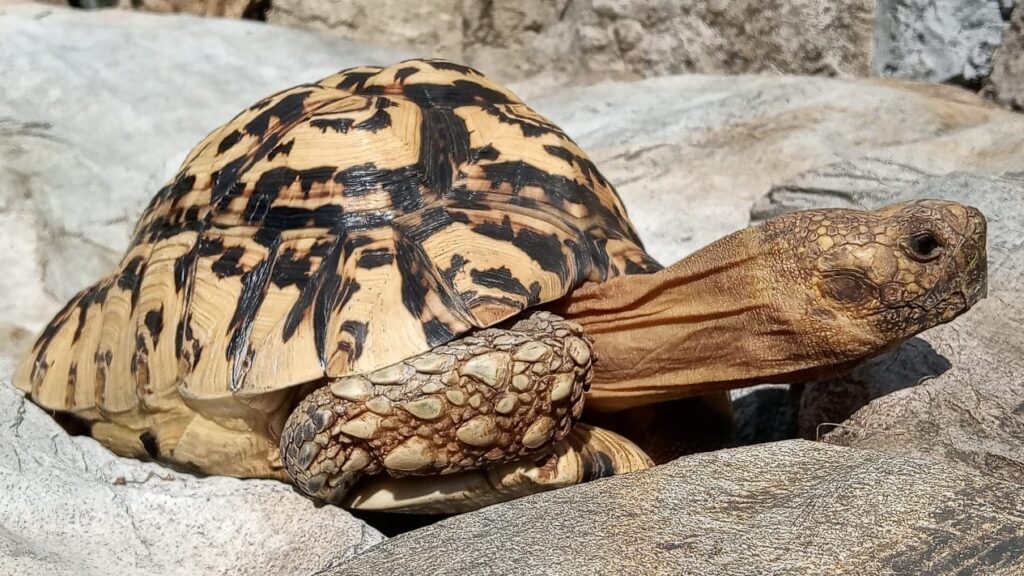
I personally use Top Soil in my Enclosures, as well as flattish rock features, and our outside adults get to roam on some of our paving to keep their claws short.

Soil can be a bit of a challenge in that it can harbour more pathogens, and can cause impaction if ingested by a thirsty, hungry or bored tortoise. But, I believe in keeping habitat as natural as possible. In the event that your Tort might go back to the wild, or be passed on to another home that is perhaps less particular – you want them as robust as possible to ensure survival, so an environment that is too clinical is also not a good idea.

Soil will also aid in a Tortoise being able to right itself if it has flipped on its back by misadventure, or been flipped on its back by a cohabitor.
Soil mixed with a bit of Coir and a bit of Activated Charcoal is a good bet. Indeed, a specialist supplier, who are also very experienced keepers, provide a commercial substrate product that is just that, with some other added material for pro Bioactive Vivs for a variety of species. Links below:
US https://leaphabitats.com/collections/substrate
UK https://charterhouse-aquatics.com/shop/exotics/bioactive/substrates-2/leap-living-earth-substrate
Food / Diet
Tortoises are essentially all omnivores, however, this does not mean you should be feeding your tortoise anything other than on a herbivorous diet. This is most especially if they are classified as non-omnivorous or herbivorous ‘only’ species. Tortoises will eat carrion from time to time, especially if food is scarce, they will eat the faeces of carnivores. They will eat baby birds, small eggs, slugs, snails, small snakes, worms and just about anything that moves or does not move. Even ‘totally’ herbivorous, ‘non-omnivorous’ species will behave like this at times. But, this is under natural conditions. In captivity things are not ideal, for this sort of ‘experimentation’ with food.
While exotics can live wonderful, very long fulfilling lives in captivity, often much longer than in the wild, and essential lives, if they are extinct or functionally extinct in the wild, captivity does not offer them the best immune system and self-help opportunity such as eating the right stones or sticks to combat parasites, that indeed may come from eating carrion, or insects for that matter (who actually harbour a lot of pathogens) as an example. Compared to the wild, captivity is no match. Apart, that is, from how utterly more dangerous the wild is, and is getting more so, for the vast majority of species.
Eggs and egg shells can carry and transmit Salmonella to your tortoise, slugs and snails could give them Lungworm – and Rat Lungworm can then go on to infect humans badly too. Faeces can pass all sorts of pathogens to your tortoise…and excreted unmetabolized medicines from other pets on medication, like dogs and horses, and that is not at all good either.
So, if your tortoise eats a dove egg fallen out a tree, eats a snail or slug one day, a worm here or there, or a baby chicken (hopefully not, so sad) or eats a little dog poo, don’t panic, its kinda normal for them, but it should not be encouraged.
My rescue African tortoises of a number of species and for a number of decades, have all been given good quality dog food on occasion to mimic what they might find in the wild from an animal protein point of view, however these tortoises have been kept wildish, in conditions very close to their natural habitat. Always ready for release, if appropriate and healthy enough, always keeping up that natural husbandry as much as possible. In a wild or natural environment, tortoises will be able to compensate for a too high protein intake from say, eating a bird, by getting much more exercise, than they can get in captivity.
Some species of animal will eat faeces from mammals and other carnivores in order to obtain essential Vitamin B12, this is produced by gut bacteria in the defecating species stomachs, scientists now believe. It is worth keeping this in mind, to ensure you supplement your tortoises’ diet with a little nutri / vitamin / mineral commercial supplement here and there, even if you are feeding natural fresh appropriate foliage or organic lettuce like Lambs Lettuce / Cos Lettuce, Baby Gem Lettuce, Carrot / Grated Carrot and Kale. Shop bought organic lettuce like Lambs Lettuce / Cos Lettuce, Baby Gem Lettuce, Carrot and Kale most certainly can be fed, but please make sure it is Organic as much as possible & on occasion as much as possible, there are copious amounts for pesticides and herbicides on this food produce normally, even Heavy Metals and Metalloids often. And, as said, they have much smaller bodies than us.
I do not rate commercial food very highly, at least not yet, for this very reason. *If you do need to feed commercial pellet or biscuits, make sure not to soak them way too much, especially for juveniles. It may seem intuitive to have as much water in their food as possible to keep all important hydration intake high, but what happens to a soft squidgy pellet when a tortoise bites down on it, it squeezes the water, and with it ,small debris of food often into the nasal passages. Sometimes called Nasal Regurgitation, this can cause rhinitis (runny nose) and or infection of the nasal passages, which can lead to Nasal Asphyxiation and suffocation and or broader infection & pneumonia. If you are however, battling with a tortoise that will not readily drink, then I would soak the food well. You should also decant about a weeks worth of your commercial tortoise food each week, and then put the rest into the freezer to keep it as fresh as possible, even the dried food will go off if not frozen. And, this stale food could very easily put a fussy / compensating or ill tortoise off eating anything, which can be devistating.
As much as possible, fresh wild picked weeds and leaves from the right weeds and trees, that are in good condition, ie not stressed plants, must be given and from the right, safe areas, and along with supermarket bought safe appropriate produce. These leaves, weeds and flowers should be grown in your own garden ideally, or the garden of a conscientious friend or family member. Public parks are another good place to pick leaves & and flowers – never take the whole plant, this is illegal in some countries, it also means the plant cannot rejuvenate and continue to provide food for your pet and someone else’s pet or wild animal. Leaving it alive also means the plant will produce more yield for food picking next time, if not picked to death. *Plants also produce noxious airborne chemicals and or toxic chemicals and proteins into their leaves when attacked by herbivorous creatures like people, insects and Tortoises. Some of these are lectins, ribosome-inactivating protein, protease inhibitors, α-amylase inhibitors, ureases, arcelins, antimicrobial peptides, and pore-forming toxins. Uprooting the whole plant makes this reaction much more acute. One should only pick a few leaves from each plant you reap at a time. In the wild you will notice Tortoises will usually only nibble a few leaves or bites from a plant before briskly moving on to the next plant or food patch, this is to avoid these plant reactions.
https://pmc.ncbi.nlm.nih.gov/articles/PMC7111729
I do not suggest picking weeds & flowers along roads and roadsides, many nasty pollutants are deposited from traffic, cars, lorries, & trains too. Weedkillers are also used by local authorities along roadsides most often.
Some of these pollutants include:
1)Benzene series compounds (BTEX) – these are toxic remnants of petrol / gasoline combustion from ICE vehicle engines. Incidentally, they are not good for humans either – one of the important reasons we need to move to electric vehicles or hydrogen vehicles. Even though electric vehicle have some of their own environmental problems to sort out, they don’t cause these sorts of toxicosis.
2)Arsenic & Arsine Heightened levels, particularly from diesel engines & Copper Arsenate pesticides.
3)Rubber residue from tyres – organic and inorganic unhealthy compounds of and used in the manufacture of tyres, PAHs (polycyclic aromatic hydrocarbons. PAHs are a component of the heavy oils used to make tyres. Are known to be mutagenic, carcinogenic, teratogenic, and immunotoxicogenic to various life forms.
https://www.ncbi.nlm.nih.gov/pmc/articles/PMC7674206/
4)Organophosphates – Herbicides, Pesticides & commercial artificial Fertilizer (which is used more than natural fertilizer) Herbicides are often used along roads and curbsides, these are not at all healthy. They are also used for pest control and boosting crop production for animal feed. The animals of which are not designed or meant to live long, as they quickly become our food, so long term health is of no importance for them. The problem is, the very same suppliers of food for relatively unimportant livestock, are likely the same suppliers of your’ favourite’ commercial Tortoise Food. I have contacted many suppliers to try to address this issue, but have not had any change or progress.
5)Mercury – mercury is still produced in significant amounts by internal combustion engine vehicles, and it is from both petrol and diesel engines that this carcinogenic toxic by-product is released.
There are many more sadly.
Ideal Foods to feed
As with most things, moderation and variation is the key point with tortoise diet. A mixture of what I call deep feeders, and surface weeds with short root systems, should be fed. Deep Feeders are plants with deep root systems like Trees obviously and, Dandelion, which also has an unusually long tap root. They are able to absorb nutrients and minerals deep under ground that might not be so readily found closer to the surface of the ground.
Buy one or two Hibiscus bushes, they are easy to grow in most climates. Their leaves are a bit leathery for baby tortoises but they love their flowers and petals, which are nutritious and high in fibre like most flowers.
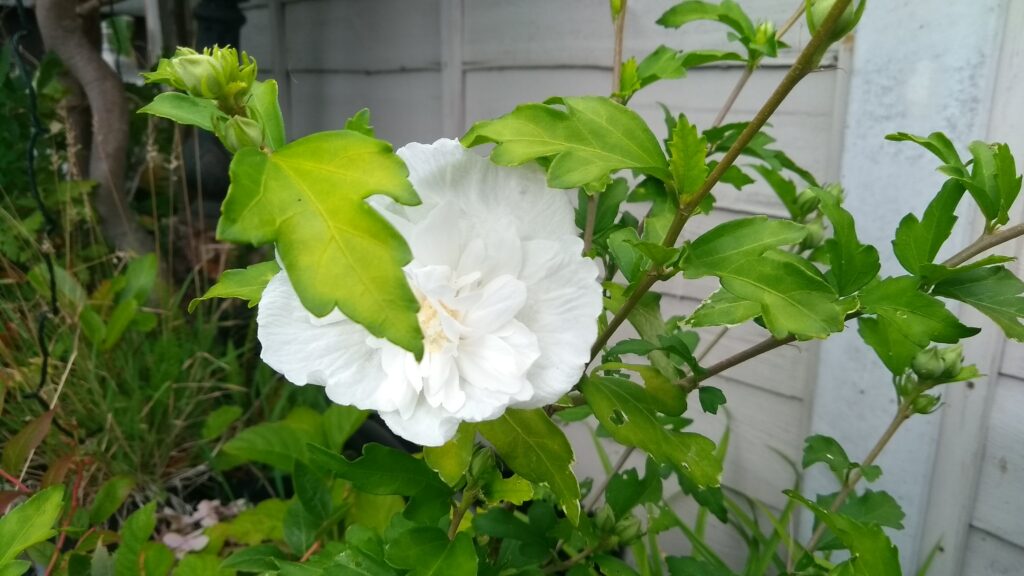
Buy a couple of Grape Vines, Grape Vine leaves are nutritious and are high in the all-important dietary fibre, so vital to a tortoises gut health, they also have tannins, which are good in small quantity. Grape vines grow easily in most regions, and are tolerant of many miss justices in one’s garden, ie – easy to keep happy. *Feed Grape Vine sparingly, and the Fruit even more sparingly.
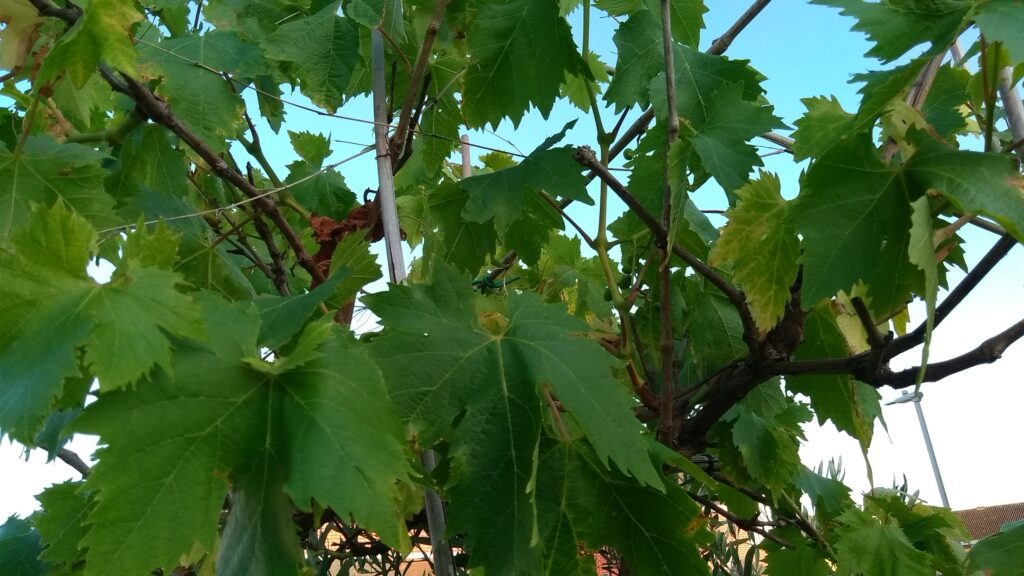
Buy an Olive tree, the leaves have some powerful medicinal attributes. The NIH considers olive leaves as a plant antimicrobial with both antimicrobial and antioxidant properties. Olives grow in ranges a number of tortoise species cohabitate, and olive leaves have been used by people for thousands of years as medicine and to boost the immune system. Tortoises will likely accept their taste, as tortoises use smell more than taste, but offer small amounts, and chopped up. *Feed Olive leaves sparingly, * don’t feed the fruit though.
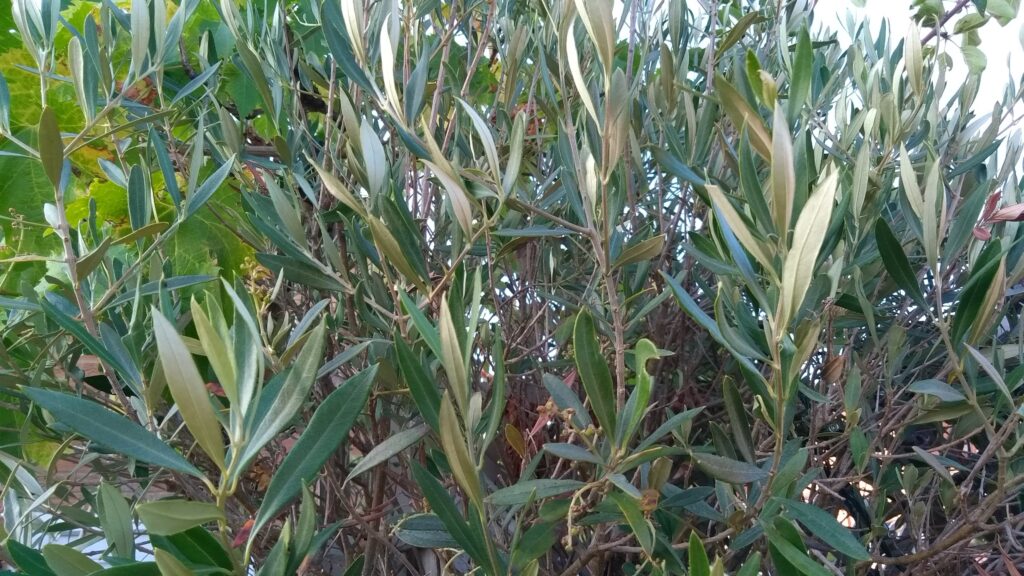
Buy a Lavatera Tree (Tree Mallow) – Lavatera Arborea Leaves and Flowers are edible and tortoises particularly like the flowers. Leaves and flowers are also edible for us humans too.
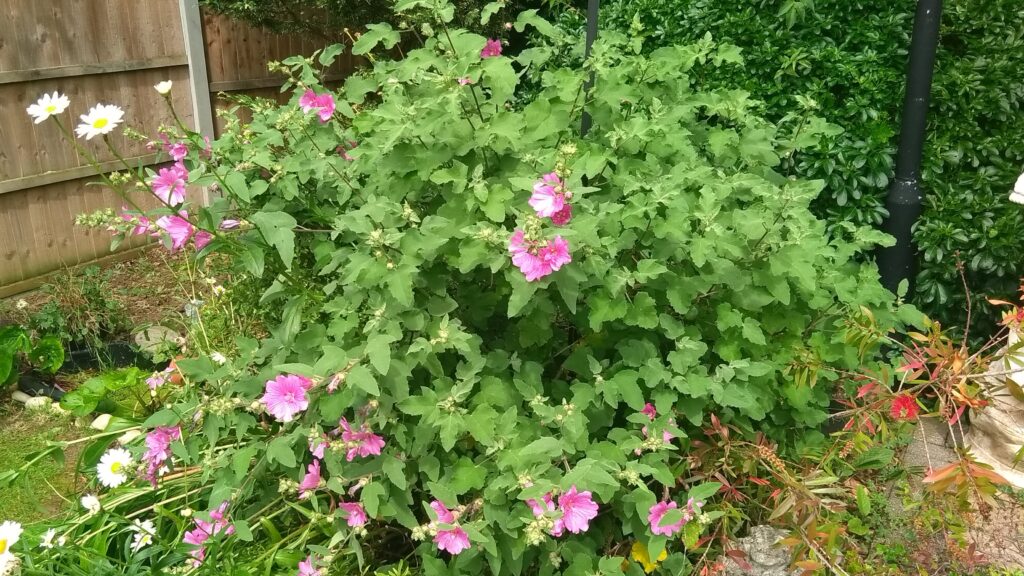
Greater Plantain, Common Broadleaf (Plantago Major; Plantago Media) apart for a host of nutrients, this common weed found in many places around the world, possesses high levels of antioxidants, anti-inflammatory properties and immune boosting properties. It also has importantly, not to high tannin content. Tannin, in not too high amounts, has been identified as reducing and combating microbial blooms, worm count excesses, fungal activity and dealing with flagellates by improving intestinal lining. All the while not completely wiping out good bacteria and gut biome / GM – Gut Microbiota, like a antibiotic most certainly would. Plantain will readily grow in gardens year after year if you allow some to go to seed. *Can be fed often and in reasonably large amounts.
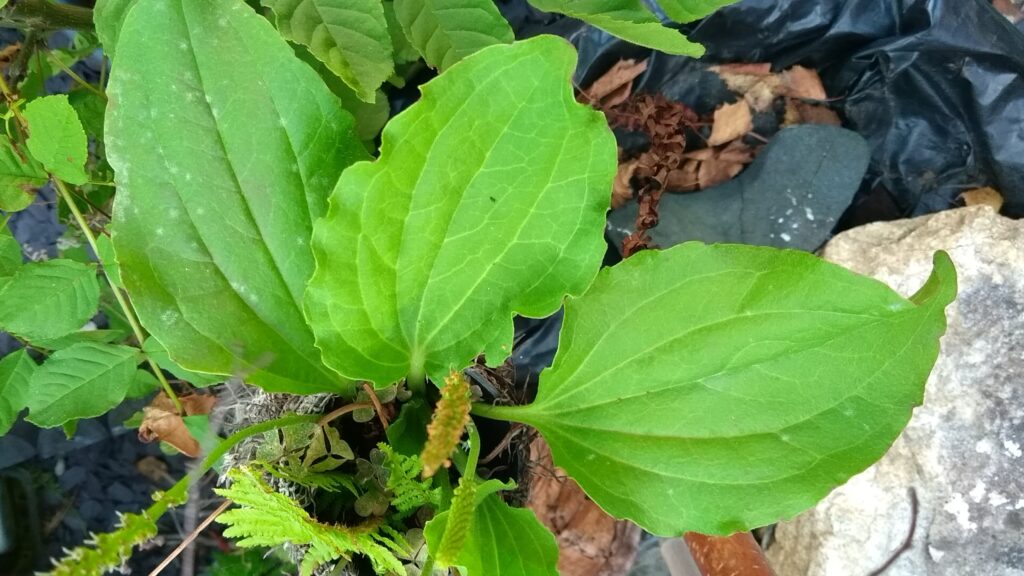
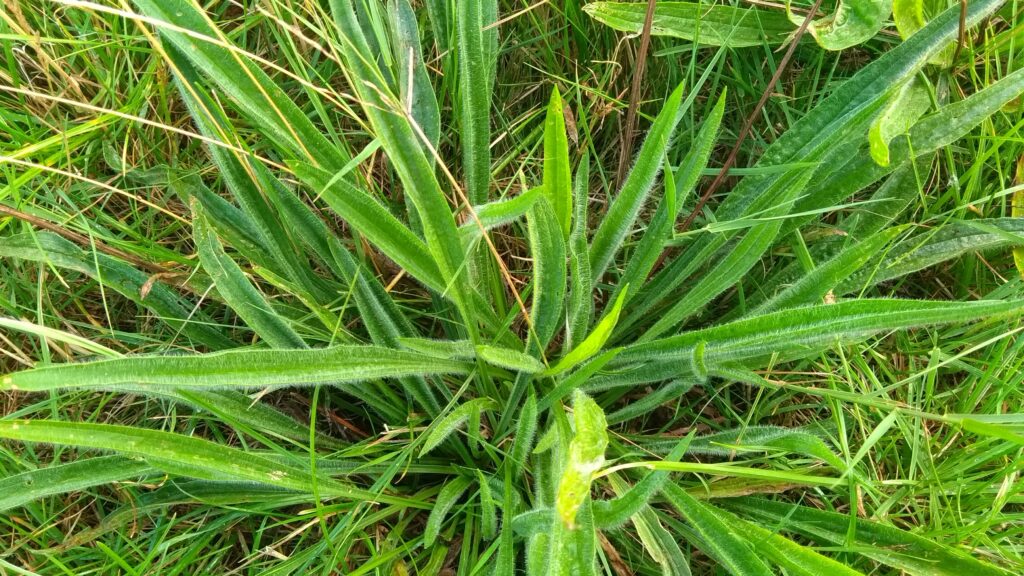
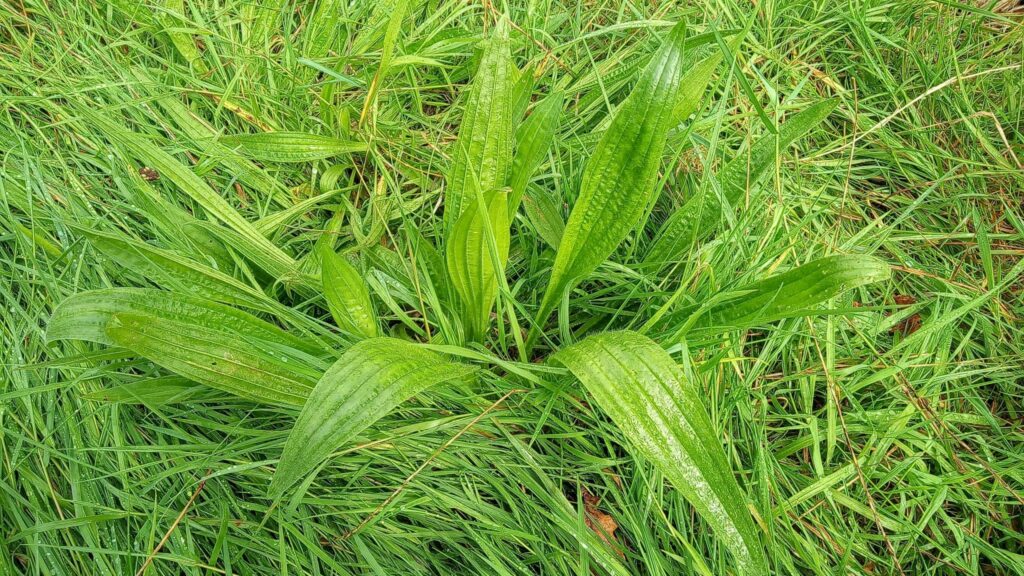
Some specialists will advise a dose of faeces from another healthy tortoise to be given to a tortoise just out of anti-microbial medicine treatment, to replace the good gut bacteria and biome as quickly as possible to ensure the recently medicated tortoise stabilizes its health through an all-important healthy gut flora & gut microbiome. Having the right fresh variety of plants to feed also helps this rebalancing of Gut Bacteria too.
Dandelion is a tortoise favourite for both hatchling / juveniles and adults. Highly nurtrit,ious, this is often a staple for tortoise keepers. Note however, that the leaves can become mouldy later in the season even on healthy Dande plants, so take care not to feed bad looking mouldy leaves.
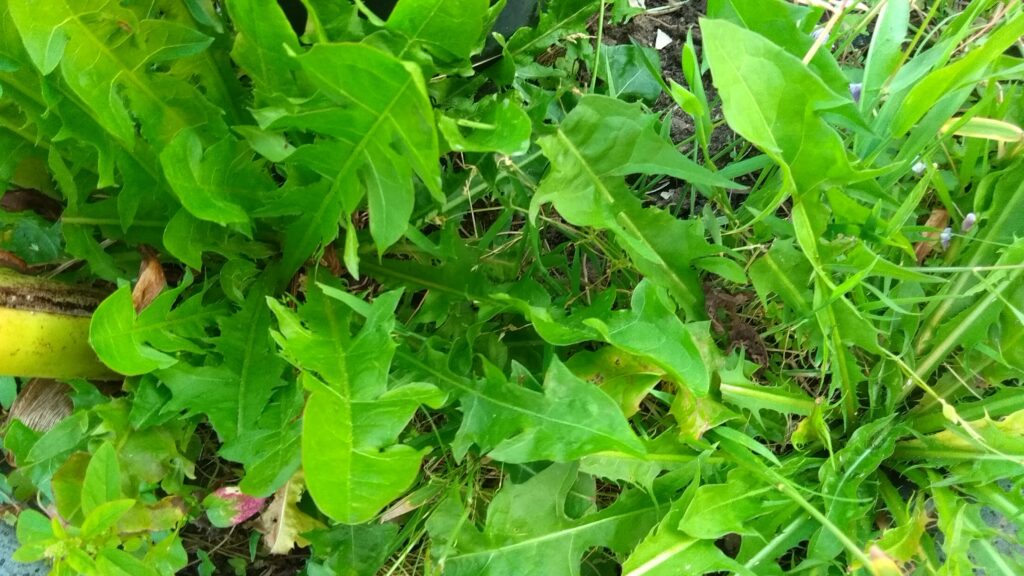
Dandelion are also high in Potassium which is a very important nutrient for preventing Bladder Stones, by facilitating Urine Citrate excretion. Tortoises are very susceptible to Bladder Stones.
Buy a varied Tortoise Feed seed mix to grow yourself – there are many available online, from reputable tortoise keepers.
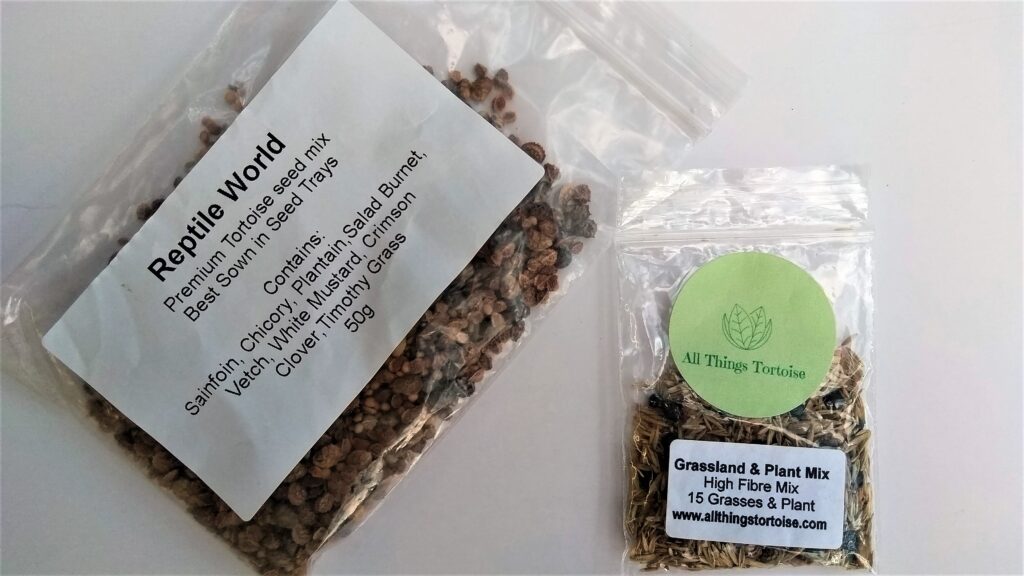
Providing a varied diet every day to your Tortoises is essential. Plants often produce nasty chemicals at certain times in the seasons and in certain weather conditions, and depending on whether they have been attacked excessively for food. Tortoises will know if these chemicals are high or not. This is why you will often see tortoises smelling leaves and shoots quite a lot, and not eating them sometimes, even if they are their favourite. They will choose what they want to eat, choose not to eat what they should’nt. Having this choice is very important.
In the video below, you will see, while they have their Seed Tray with Tortoise Weed sprouts and shoots, I still supplement the little guys with other food, such as flowers, other weeds, lettuce grown in our garden, and shop bought lettuce, and a bit of dietary supplement.
Pegs, as seen above and below, are a good way to hold leaves and flowers in a more natural way and limiting the food getting soiled, Tortoises have a habit of urinating on their food. I guess, when they feel its gotta come out, its got to come out.
Opuntia Leaves / Pads – Prickly Pear These can be fed often if your tortoise likes them. Note though, that they have a slight laxative effect if eaten in large quantities, so the risk of dehydration could be an issue if your tortoise has a particular liking for them. But they are very good for lubrication to guard against impaction, and constipation, which often afflict tortoises. *Please remove the prickles or spines before feeding, even if they look spineless or look removed already, they always have spines.
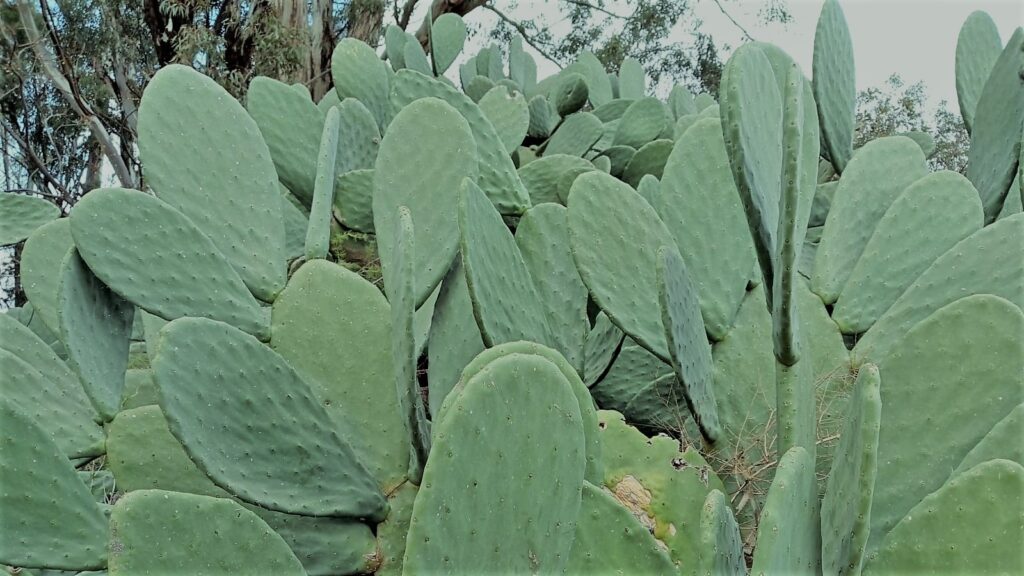
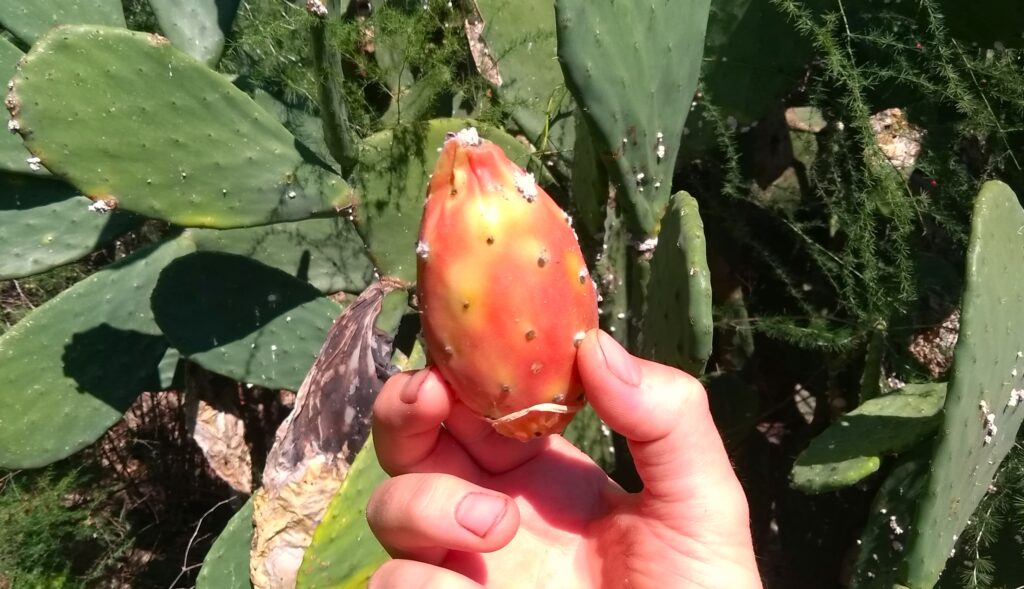
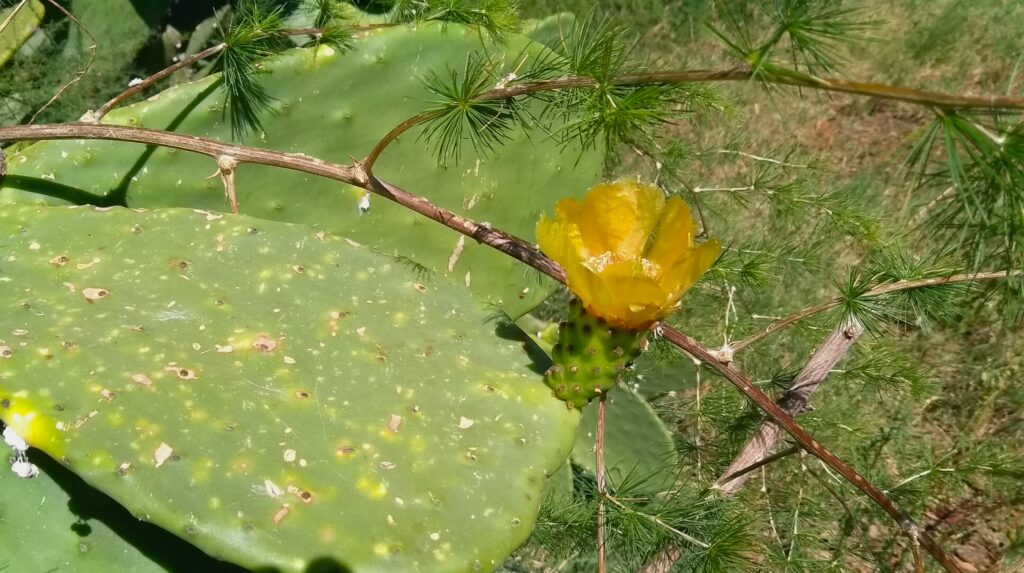
Keeping your tortoises food clean and safe from tortoises soiling their food and covering it in mud or dirt if they have just been for a little swim or bath in their drinking water, is very important. Apart from using pegs to hold Leaves & Flowers up off your enclosures bottom a bit, it is ideal to use slate pieces to feed on. Angle them at a slight slope with the highest area of the slate being the spot you would place food on – this is to ensure any urine your tortoise may expel, does not run onto the food, Tortoises love to wee a lot, especially when they are eating and drinking. You can also drill some holes in your slate pieces and poke some of the leaves / little branches and flowers into to help hold them up, as they will wilt as the day goes by.
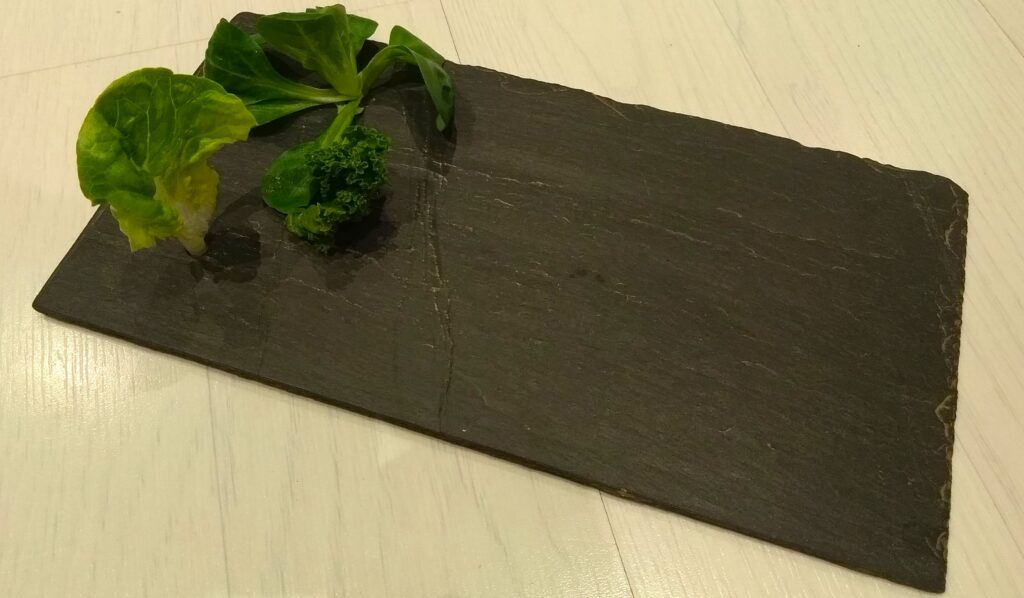
to hold the food upright
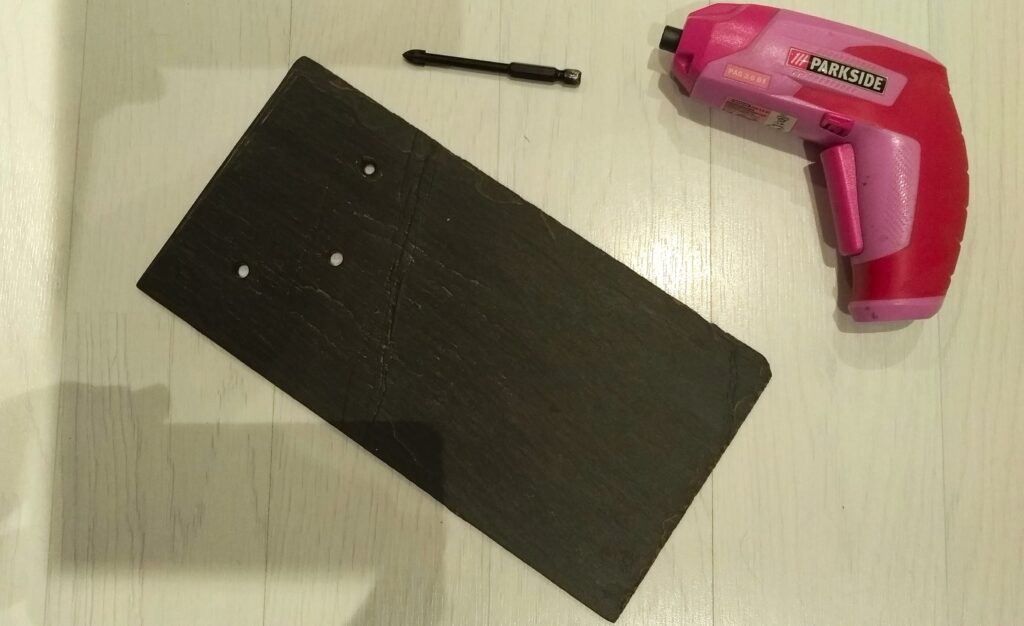
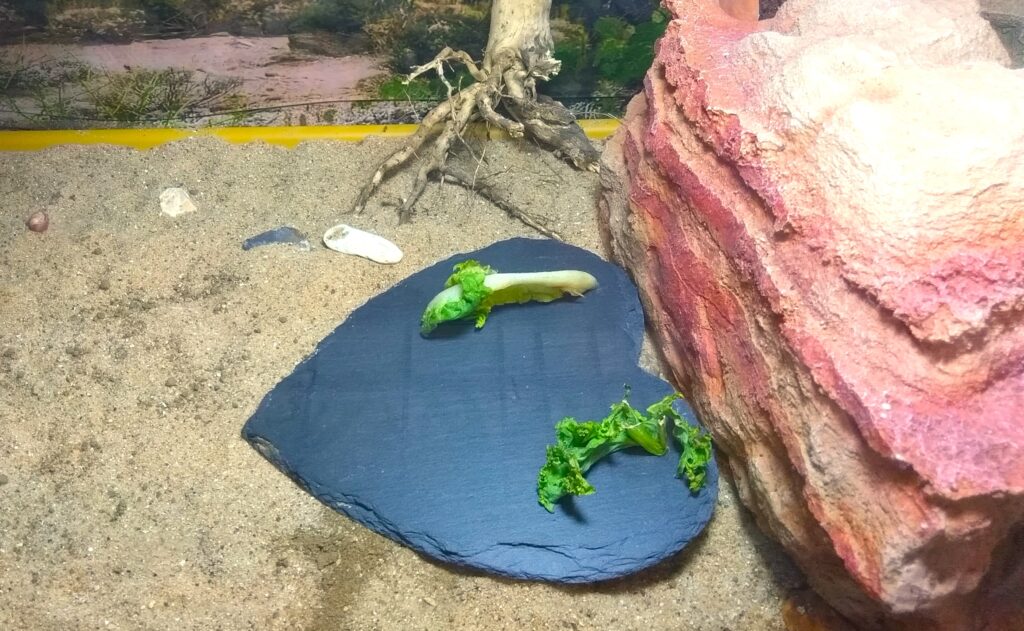

Expanding your Collection
Once you have developed a good knowledge base for keeping your chosen specie of Tortoise, apart from sharing your knowledge, you might want to take on another specie. If you are keen on keeping more than one pet exotic species, it is a very good idea to get very fussy, limit yourself to one or two species at most, maybe 3, and naturally coming from the same part of the world, this will help to prevent you from becoming a ‘collector’ cars & coins are for collectors, not animals. It will also be easier to learn the general shared environmental requirements of your chosen species, making an easier experience, and a reasonably shared environment in your chosen part of the house or garden you are keeping them in. Most importantly, it will help you keep disease at bay, as diseases from species from very different parts of the world can be deadly to other species. It is very important to keep your species apart and use very strict hygiene regimes between them, unless they found in the very same areas in nature. Even then it is not at all a good idea to mix species together, lingering disease can be tolerated in one individual, but kill another quite easily. Sticking to regional cohabitants is difficult when rescuing, I know from experience, but the principle is a good idea to work toward. Remember though – don’t mix species, or keep them in the same enclosure.
Supplements & Holistics / Alternative Medicine & Homeopathy
Prevention is better than cure
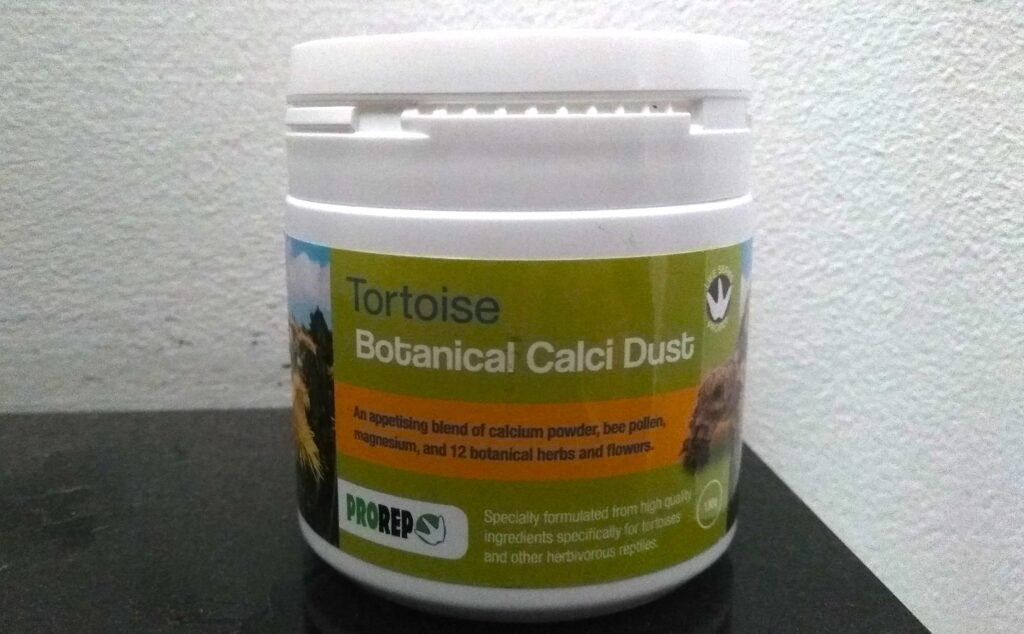
No supplement, should be fed every day, Holistic ‘medicines’ even less so, as some, in high amounts, can cause more problems than they solve. Unless, you are treating your tortoise for a specific ailment or you are unable to find suitable food for a while, daily vitamin supplementation is also not recommended. Naturally too, your tortoise would not come across the same nutrient sources every day in the wild, so providing them every day is not needed or advised, but they should feature prominently in their diet. The more diversity the better, and more likely it will resemble a natural food availability. Remember, too much Calcium in the diet could easily result in a Urolith ( Bladder Stone ) forming – causing Urolithiasis, which can be fatal. Too much Calcium, dehydration and likely a deficiency in Potassium (which most humans are deficient in too) is a recipe for a Urolith.
Now, there is a question mark next to, and cloud of controversy surrounding supplements in general, including supplements for humans. Over exposure and contamination are the main criticisms.
What is more concerning for your pets, is that on most animal supplements, it expressly states that they are not to be used for human consumption. This is not a good sign. While just conforming to health guidelines and innocently adhering to protocol may account for these warnings. It is not a good sign, and likely the result of poorer standards in the manufacture of these products because they are for ‘animals’
As with commercial Tortoise Food, this poses a rather concerning problem.
But we have to work with what we have, as such, always use human food grade products, wherever possible only use products for human consumption. Remember, we still live in a very anthropocentric, ecocidal, speciest world, where animals don’t count much generally, especially in many science fields.
Some of the ones I have faith in are:
Habistat / Monkfield Reptile
Komodo Products
Zoo Med
ProRep
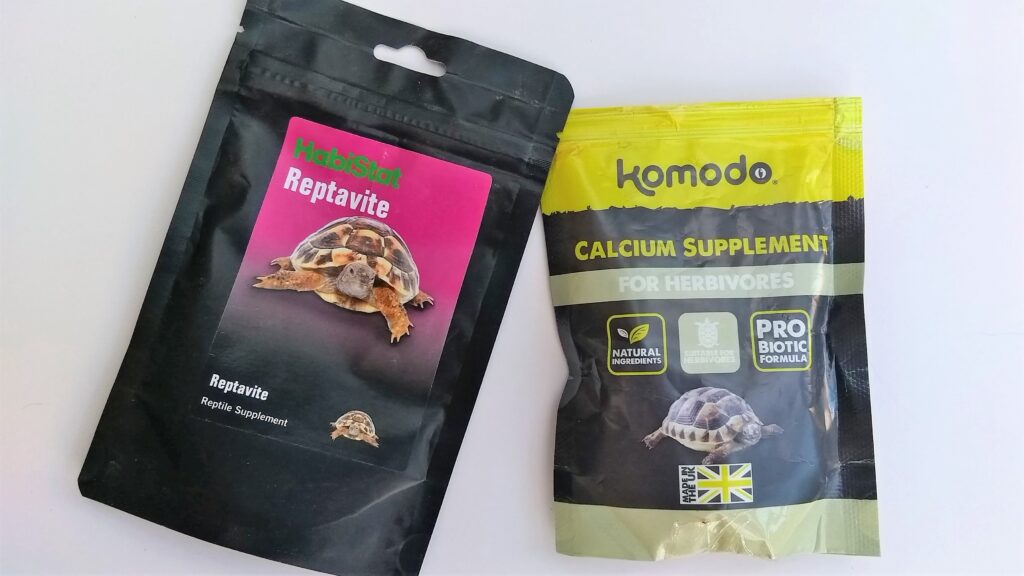
Supplements tortoise should have in their diets on occasion over and above a good provision of wild fresh weeds, leaves & flowers that are suitable for everyday feeding include:
•Diatomaceous Earth is fossilized diatoms – having a negative charge, when passing through the gut, it picks up bacteria, fungi & parasites, and some toxins released from intestinal infections and, even heavy metals with a positive charge. Thus, lowering the burden on your tortoises digestive tract. Diatomaceous Earth is used to treat constipation in many species in Phylum Chordata – the group of animals Humans and tortoises belong too. It is a good source of silica, important for healthy bones and skin, and is a source of magnesium, important for neurological and muscle health and regulating homeostasis.
It is natural and very safe in the right doses, however, it has a dehydrating effect in its dry form, which helps in one of its main properties, that of drying out external parts of parasites like fleas and ticks, killing these pests, So, when used on tortoise food or in enclosures for pest control, additional drinking / soaking / hydration should be encouraged, especially in juveniles. However, it is known to help hydrate when used in its dissolved form in drinking water
It is also said to combat constipation, by helping move faeces through the bowel
https://www.webmd.com/vitamins/ai/ingredientmono-1531/diatomaceous-earth
In industry, Diatomaceous Earth is sometimes used to remove impurities in drinking water & is often used in foods and medicines to prevent clumping, it is also found naturally in its presented form, so it is widely regarded as safe, in the right quantities.
Use only human, Food Grade Diatomaceous Earth.
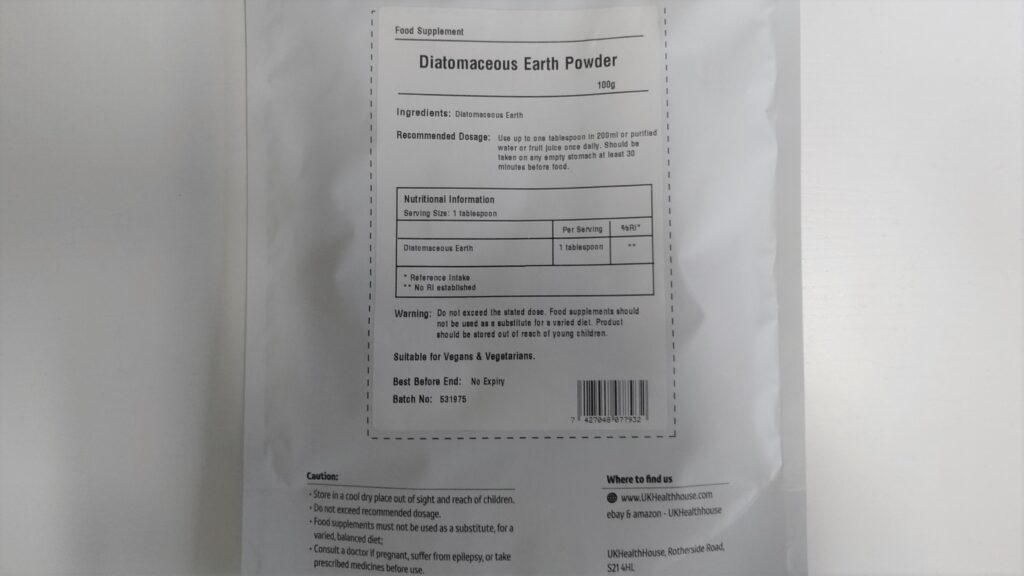
•Fresh Leaves and flowers with limited tannins – such as Meadowsweet (Filipendula ulmaria) & Ladys Mantle (Alchemilla) & young willow tree leaves & olive tree leaves, should be fed sparingly but regularly if your tortoise approves. The Tannins seem to reduce worm load. And they help with many other issues too, such as Oxidative Stress reduction and combating Fungi, Bacteria and Viruses.
https://www.frontiersin.org/articles/10.3389/fmicb.2021.625782/full
A worthy site to visit, run by Dr Emily https://www.wormadvice.com/tortoises
•Tortoise Calci stones such as ProRep Tortoise Calcium Blocks 1Kg they look just like stones and can trick a smart tortoise (which nearly all of them are smart, being around 250 million years old) who might be weary of anything you present them with, such as sprinkled powder on their leaves, but would be happy to ‘find’ something on their own, that looks more like a stone.
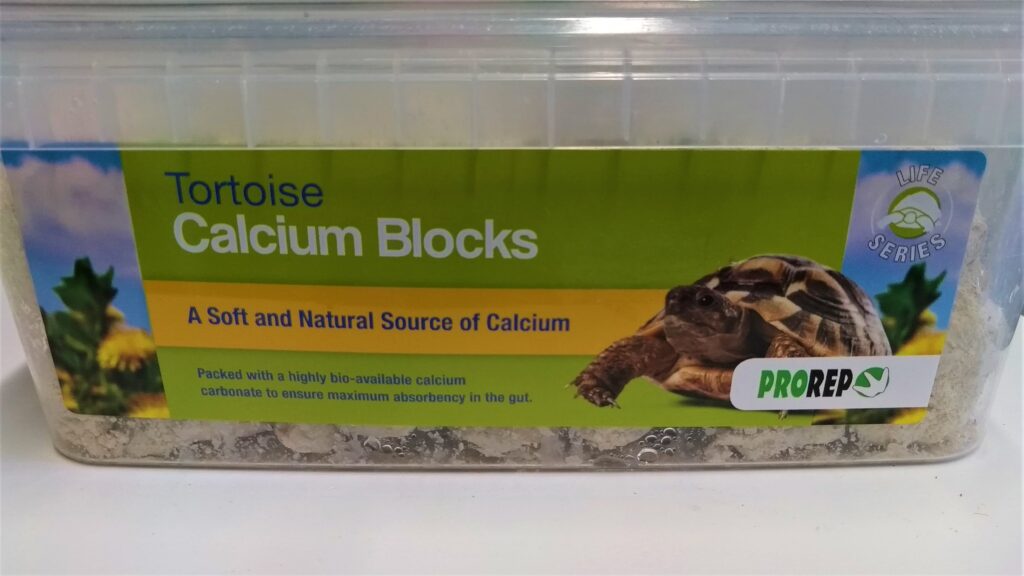
•Cuttlefish Bone will be used by most seasoned Tortoise keepers in their enclosures, for a rich in nutrients option for Tortoises to nibble on. Cuttlefish bone has important nutrients such as most notably, a significant natural source of all important Calcium, but also magnesium, phosphorous, manganese, selenium & zinc, polyunsaturated fatty acids like Omega 3 and also Iodine (iodine is lacking in many diets – Tortoise diets and human diets. Remember, just because someone does not have a goitre, does not mean they are not iodine deficient. Iodine deficiency can cause mental health deterioration in humans and would naturally, very likely cause it in Tortoises too.
But not all Tortoises know to eat Cuttlefish bone or like it for that matter, and baby Tortoises, who are in great need of good nutrition, are not yet strong enough to bite into Cuttlefish bone. So, natural, unadulterated and unfortified, Food Grade, preferably Human Food Grade Marine Calcium, Algae Calcium or Algal Lime powders, made from red ocean alga or red seaweed – usually Lithothanium Calcareum, are a good option for your enclosure. They all have the all important good Calcium to Phosphorus ratios & Calcium to Magnesium ratios, ratios which prevent MBD – Metabolic Bone Disease & Pyramiding in tortoises. The powders also contain safe amounts of Boron, which together with the above minerals included, being manganese, selenium & zinc, help to ensure good bone and shell development. But, the Marine Algae powders also contain a natural form and more bioavailable form of Vitamin D3, the super important other ingredient along with the Minerals above that support proper Calcium absorption and healthy Bone and Shell growth.
Present the powder in either a little bowl, or in a ‘Calcium Cave’ or Lime ‘Stone Cave’. These can simply be a mini hide with some of the Marine Algae Calcium pored inside of it, just a little bowl. Tortoises will go and help themselves to it, sometimes sticking their entire heads into the powder to get a good mouthful. *Do not sprinkle it on their food, they should know when they are deficient in it and will readily help themselves, you don’t want to force it on them, especially if you are already sprinkling a commercial Calci dust of some sort on their food from time to time.
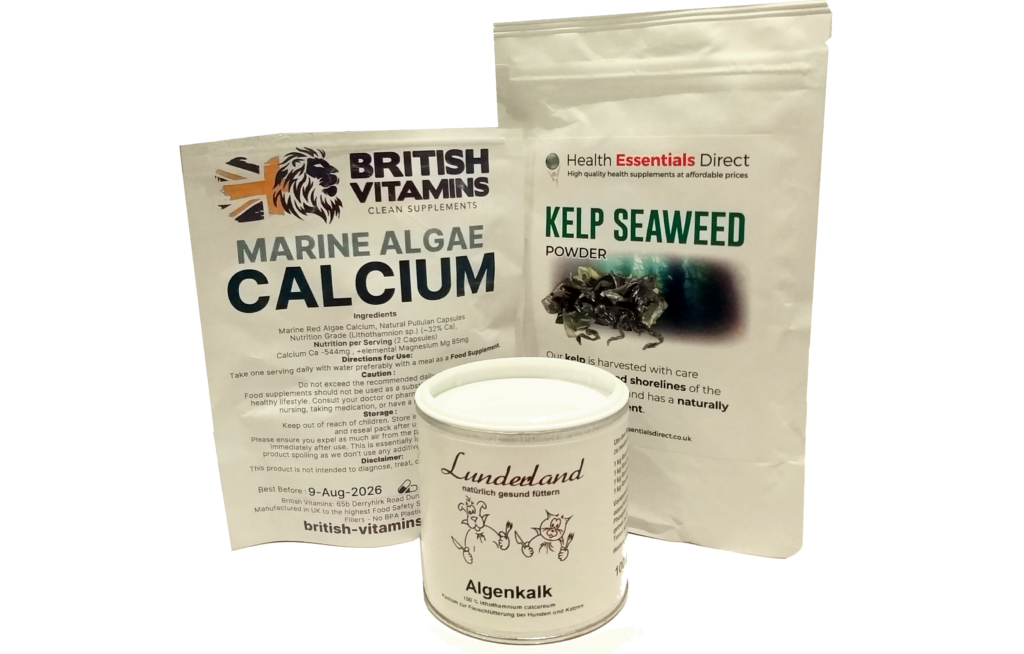
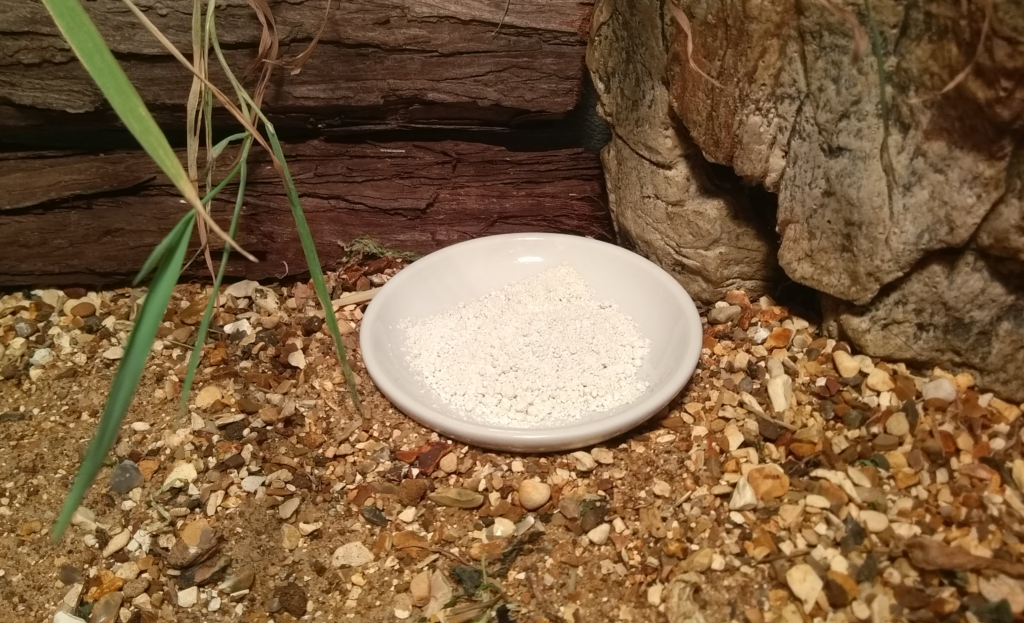
I would say though, if your Tortoise is readily eating one of these vitamin food grade Limes, you must make sure they are hydrated well – ie drinking well, and have no signs of dehydration. Excess Calcium intake can cause inappetence (not wanting to eat) and , if I hazard a guess, adipsia too(not wanting to drink) This, naturally can cause constipation and uroliths. The use of synthetic Calcium Carbonate or PCC – yes, that is a thing horrifyingly, and often it is put in many types of food – quite possibly your Commercial Tortoise Food, is strongly not advised, as this will undoubtably have worse effects for health if too much is consumed, than naturally found Calcium sources.
It is far better to offer a more rounded product and ideally more natural product than commercial supplements, that may contain standard rock Calcium rather than marine Calcium. Standard supplements will also not have much of the vast and myriad of other micronutrients and minerals that make complex organism work properly.
Arthur Haines is an academic but also an outthinker, at home in the dogma of acedemia and quite comfortable thinking outside of the ‘dog’ma box’ as well. Isolated minerals and nutrients in commercial products are not the way forward, as you will see further into my website with regard to isolated reptile lighting bands instead of full sun spectrum light. Arthur explains, with regard to food, better than I would, so I place a link to an important article of his.
http://www.arthurhaines.com/blog/2014/6/13/vitamin-c-and-ascorbic-acid-are-not-the-same-thing
Its worth mentioning, we also need to be aware of Growth Spurts, while it may be encouraging and exciting to see your tortoise suddenly start growing fast, this may not always be a good sign. It might be greed, which can be absolutely fatal, but could also be a sign of depression on rare occasions, it could be a sign of Metabolic Disease and could also be caused by an additive in their commercial food. A good example would be Ascorbic Acid mentioned in Arthur Haines’ article above. In the additive form, Ascorbic Acid is not Vitamin C, its used as ‘stabilizer’ in food… not a vitaminizer or fortifier! Stabilizer simply means preservative, it’s a simple as that. But, Ascorbic Acid is an appetent, it causes mild polyphagia or hyperphagia, (the desire to eat)
Depression can also cause polyphagia. These afflictions are common in humans and would obviously be common and very problematic in Tortoises too.
•Opuntia Leaves / Pads – Prickly Pear These can be fed as much as your tortoise likes. Note though, that they have a slight laxative effect if eaten in large quantities, so the risk of dehydration could be an issue if your tortoise has a particular liking for them. But they are very good for lubrication to guard against impaction and constipation, which often afflict tortoises.
Impaction in tortoises can be quite common and often very serious. It is caused by dehydration, or ingestion of sand, or ingestion of stones, or over burden infection of parasites, or a combination of the above.
Tortoises will eat stones, also known as lithopaghy, for a number of reasons, just being inquisitive, mineral craving, to help with control of intestinal parasites, to help grind up food in their stomachs and perhaps just shear boredom, but they seem to be able to handle this activity without many problems arising, far better in the wild, than in captivity.
Constipation & Impaction
Opuntia pads, Diatomaceous Earth, and too, Pumpkin squash in moderate amounts will help to prevent Impaction. Remember, preventing dehydration – ensuring they drink, and drink good water, give them baths & soaks, prevent boredom, feed the right natural fresh foods high in fibre, and maintain cleanliness is essential to avoid impaction. Also, Chlorine & Chloramines in drinking water have been implicated in causing constipation, nausea, diarrhea, eye irritation, kidney disease, and indeed also Colon Cancer. Our baby tortoises have always been on premium Bottled Spring water, but we are now giving our larger tortoises (who are not in the larger natural enclosure with a body of water serviced by borehole ground water & rain water) but spend time outside and indoors, we are now giving them Filtered & UV treated drinking water. Look at our Ultra Violet Filter along side our Berkefeld™ gravity fed water filter. Incidentally, I did not add the UV Filter to kill off Bacteria, Viruses, Fungi & Algae and Protozoans, but, to break down Chlorine and Chloramines. Naturally, UV filters do combat these germs too quite well, and are a must have if you are using rain water or water from a river or lake for your drinking water.
The Berkefeld™ is gravity fed, so requires no electricity, and the UV filter is 12 volt so can work off of a solar panel. Important attributes as we move into a world with, shall we say, fewer guarantees regarding utilities and services.
•Stinging Nettle & Alao Vera have Antilithic properties – They are very important in preventing the formation of calculi (stones) which can often occur in the urinary system or bladder of Tortoises, resulting in gastrointestinal tract obstruction. Use small young leaves of Stinging Nettle and Aloa Vera. Lightly blanch the Nettles to rid them of the stinging hairs, and use only young new leaves from non already flowing plants.
Runny Nose or RNS – Runny Nose Syndrome
A clear runny nose or clear fluid coming from a Tortoises nares / nostrils, is not immediately a cause for concern. If the Tortoise is otherwise happy and healthy, eating & drinking and moving around normally, than these symptoms can on occasion, go away on their own. If other bad signs are present and or the fluid is gunky or has colour or opacity to it, in other words not clear, then there is cause for concern. If the runny nose does not clear up or begin to clear up after an number of days and some therapeutic intervention, it could be serious, it could be a respiratory infection. And these can quickly become life threatening.
Runny noses can be caused by many things: irritants like a chemicals, dust, mould, pollen or simply just stress, stress from a temperature change can simply be the cause. Or, otherwise normally present bacterial or viral increase due to enclosure environmental changes like cold and dampness. RNS can also be cause by worms, which can than cause an allergic reaction leading to runny nose.
I would, almost immediately try Colloidal Silver or Nano Silver drops as an alternative medicine on their food. Colloidal Silver will have limited success on early onset and mild infection, but it is to be treated like a medicine – not abused, and not over used, as Silver overdosing does come with undesired side effects and potential harmful outcomes. It will also alter and sometimes kill off Gut Bacteria & Probiotics, as do prescription Antibiotics you would get from your vet. Because tortoises use Gut Bacteria significantly, to help digest and break down their food in their stomachs, this then becomes a problem.
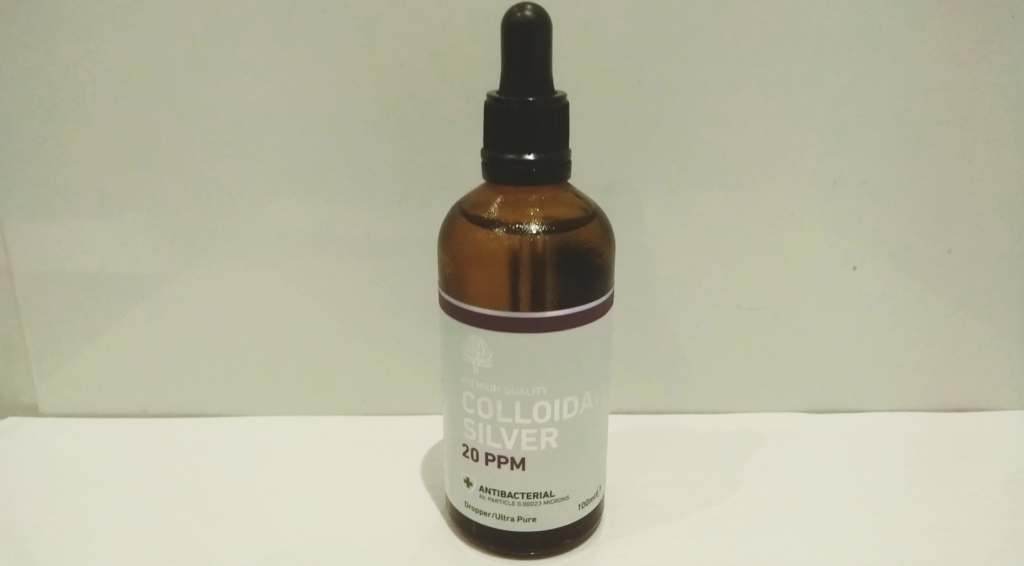
But, Silver has been used for thousands of years as a medicine for bacterial, viral and fungal intervention, and is even today still used in wound dressings and in some antibiotics. Colloidal Silver can be used orally for internal infections and topically for skin infections. Silver nanoparticles have also been shown to reduce pro-inflammatory cytokines and inflammation.
https://pmc.ncbi.nlm.nih.gov/articles/PMC7167925
Extract from paper above
“In this context, colloidal silver gained renewed interest. It was reported that colloidal silver can significantly reduce the duration and severity of many bacterial infections such as septic wounds. This suspension of submicroscopic silver particles does not attack the bacteria directly, but causes a deactivation of enzymes responsible for their respiration, multiplication, and metabolism”
If the runny nose does not begin to clear after a week of treatment, the next action I would attempt (under supervision of a suitable expert or veterinarian) is Nasal Flushing 2 to 3 times a day. This involves using a syringe filled with saline water to start, if no signs of improvement are seen, then use correctly diluted F10® SC Antiseptic Solution. Position the nozzle of the syringe to one of the nares / nostrils and discharge the syringe (squeeze it out normally) reasonably forcefully so that the jet of solution gets through the length of the nostril into the mouth. Then repeat for the other nostril. The Tortoise must be positioned with its head down / body at about a 45 degree angle. This is to ensure that the jet of water / f10 dilution does not go into the Tortoises lungs and cause even more problems, it must go no further than the mouth and it will come out of the mouth hopefully taking most of the offending nasal mucous with it. In very small tortoises this becomes rather difficult as the the syringe nozzle is very large and the resulting jet of water diameter much larger than the aperture of the nostril. The result is, the fluid just jets all over the place and not into the nostril. One fix to this problem is to use a silicone syringe nipple with bit of reinforcement – attach the soft nipple to the syringe, then place the soft nipple little end up against the nostril and dispense the syringe. This prevents the damaging of already compromised nostrils which may otherwise become infected if injured, leading to even stomatitis. The study below confirms the merit of nasal flushing.
https://bioone.org/journals/journal-of-herpetological-medicine-and-surgery/volume-35/issue-1/JHMS-D-24-00029/Effectiveness-of-Nasal-Flush-Treatments-in-Mycoplasma-PCR–or/10.5818/JHMS-D-24-00029.short
I would carry out Nasal Flushing after your tortoise has eaten, if it is still eating. Eating often gets things loosened and moving in the nasopharynx and nasal system, so flushing will likely be more successful. Your Tortoise, as with any living creature, will feel more relaxed and calm after eating, which means less stress when carrying out such a procedure. And thirdly, some food particles will likely have made their way into the nostrils, or at least into the nasopharynx which will complicate recovery or indeed even may be the cause of the runny nose in the first place. Flushing will give a bit of a clean to these areas.
A more delicate approach I would suggest for very small tortoises, but for those who are either competent, medically trained or who can be assisted by a competent person, would be the use of a flexible micro capillary attachment for Syringes. It is a soft very flexible minute tapering tube attached to a syringe that can be presented to the opening of the Tortoises little Nares or Nostrils so that when the fluid is dispensed from the syringe, it is directed more appropriately into the opening of the Nostril and gets in. But, the tube MUST NOT be inserted into the Nostril or Nare, only presented to the opening of the nostril to best direct the jet of fluid into the opening when the Syringe is dispensed.
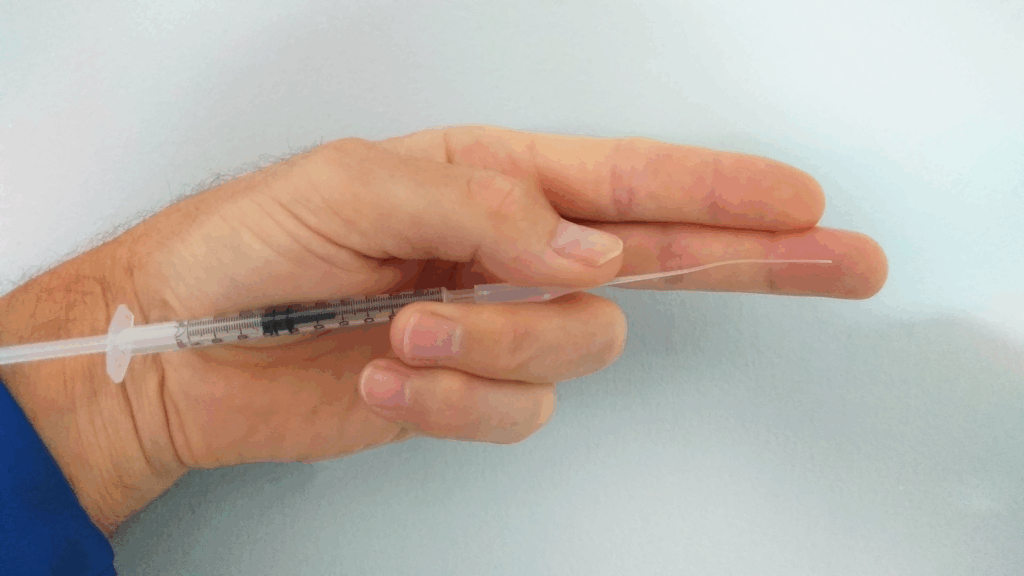
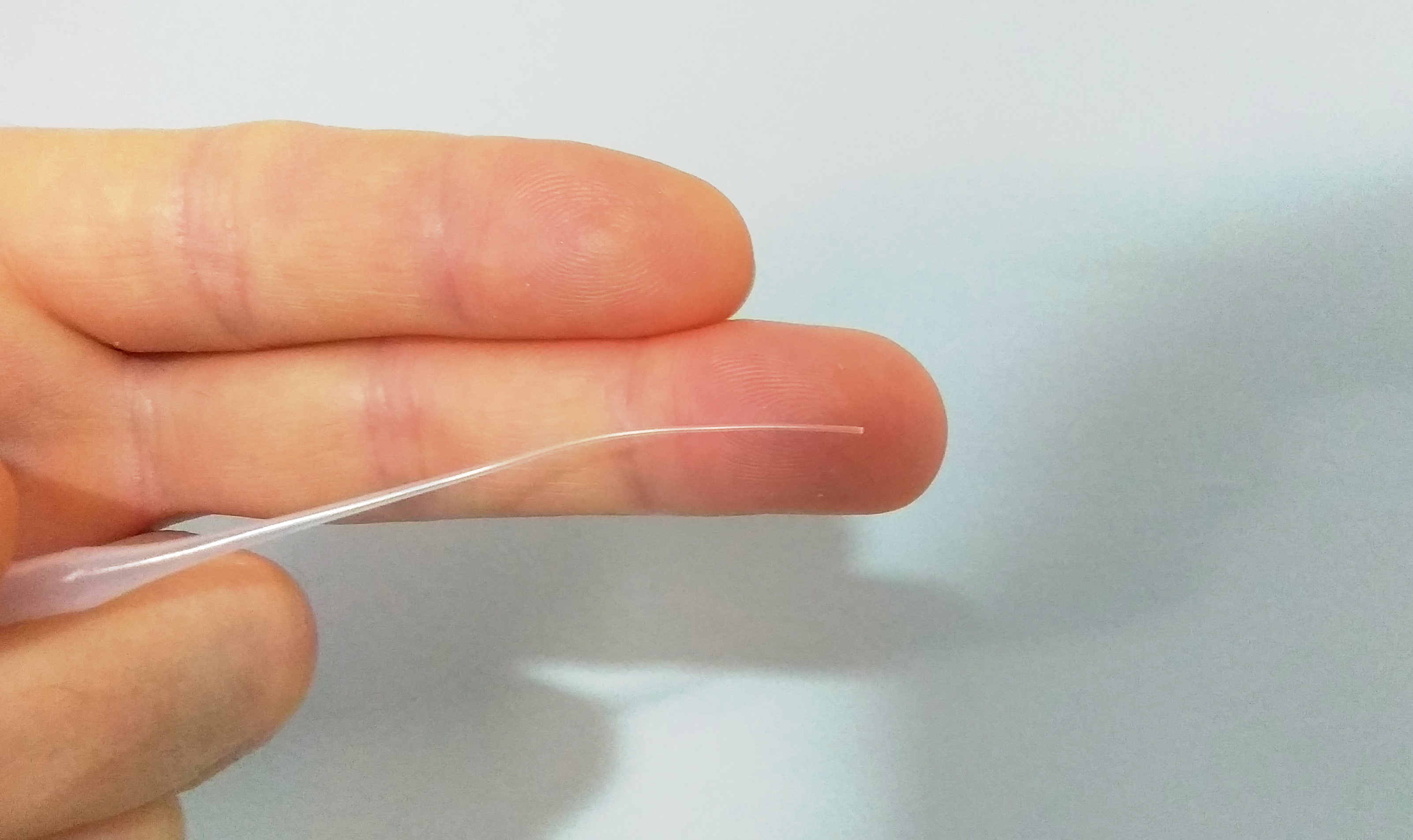
It can be cut down shorter to gain a bigger opening end
Tortoise Medical Care and Allopathy:
When your little friend gets ill.
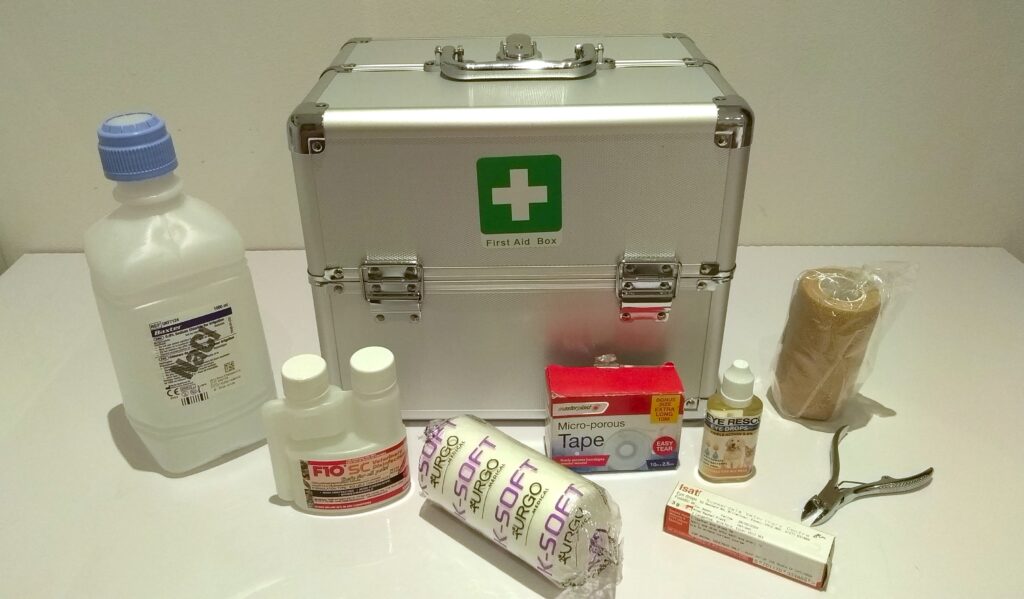
breaks in the event of an accident, general all round Antibiotics specific to your chosen Exotic, general Saline Disinfectant solution, suitable Eye Drops, Beak & Nail Clippers (if you are proficient at using them) You can add De-wormers and Vitamins too
Most people will tell you to see a vet straight away when your tortoise is under the weather & you need assistance – easier said than done, so I am not going to do that overtly. While vets are a fantastic go to when you need help, most are far from qualified to treat most exotics, even vets with experience and even specific qualifications in exotic veterinary, are sometimes in the dark as how to treat your little friend. There is a scarcity of exotic vets, especially vets that think laterally and dynamically (but they do exist) you will often also be living far from a vet with the necessary skills and knowledge to treat appropriately. Vets are also expensive, Exotic vets are often even more expensive. But, they are becoming more accessible online via online consultation, and this is also cheaper. If you have experience and knowledge keeping exotics, some vets will start off with the very basics, this can waste time, is very very good for inexperienced keepers, but can be a bit frustrating for experienced keepers who have already begun remedial or medical treatment and thus need a more advanced veterinary response from the start, which at times can be difficult to attain. However, there are some brilliant vets out there who will be fantastic, you just have to fine them.
My best advice is to learn, learn, learn all you can about treating your particular phylum / species of exotic. Keeping any animal is no joke, but most specifically this is true for exotics, so be responsible and learn all you can.
Most of the time very appropriate medication can be obtained without prescription online, and used successfully with the necessary guidance and knowledge. However, if you are starting out, or even a seasoned keeper, forming a relationship with a suitable vet is most advised. Apart from the fact that they are / should be trained professionals, two heads are better than one, and they would likely be the better head in most situations. It is good though, to be in a position to challenge their prognosis at times, they can also learn from you on occasion, and should be open to doing so. This would be a sign of a good vet, you would want to form a long lasting relationship with, a vet that is open to your ideas, but ideal that should be ‘well researched’ ideas on you pert though.
Signs of illness:
Isolate straight away, other individuals, if not at risk of contracting the illness, might exacerbate stress, discomfort, viral, bacterial or parasitic load. No one might have an answer at first as to what is causing an illness, and so triggers or pathogens, in the normal enclosure should be ruled out too, by removing the sick individual. However, many tortoises and reptiles actually like company, even when they are supposed solitary species in the wild, after all, they are sentient. This seperation, in itself, can cause stress. I have found this in trying to separate individual Pancake Tortoises (as they naturally live in groups and are social) who are greedy and eat too much so need to be kept away from the food sometimes, they can become very stressed when separated, so this too, needs to be kept in mind. Moving Tortoises from one home to another can be very stressful as well, so severely sometimes, that they stop growing, causing a form of metabolic disease. They will often resume eating and drinking after the stressful move, even put on weight, but their shell and bone will not grow again. Obesity will eventually set in, without the shell and bone growth, and the Tortoise will eventually die. Chronic or long term stress due to unsuitable enclosures, poor lighting & chaotic or unhappy environment & poor nutrition is more often the cause of growth problems / gross Linear Growth Failure, but a move can start the process off, even a ‘good’ move can.
Stress, as it does in humans, will inhibit development of proteins like Insulin-like Growth Factor-1 (IGF-I) and hormones like Somatotropin or Growth Hormone (GH) and Hormones that stimulate GH like Glucagon. This is why animals seized from Keepers who have otherwise done all their Husbandry properly, but somehow have fallen foul of the law or some extremists, then have their animals taken away from them, and the animals stop growing and breeding, sometimes become very poorly, sometimes even die.
For poor health, have the facilities in place for quarantine.
Signs of discomfort, stress and boredom that will likely lead to illness, or more illness, are:
Desperately, always trying to get out of its enclosure is often a sign that the enclosure is too small, to hot, too cold, to dry, too wet, or has stuffy stale air or toilet mess, or even, has toomuch electromagnetic radiation present in it. It could also mean something in the enclosure is irritating your tortoise, perhaps a substrate / sand / bark perhaps, or a mould infestation or parasite. And, it can simply mean your Tortoise or exotic is ill. Try to keep everything as natural as possible but maintained to prevent mould, rot and other infectious threats and imbalances.
Medical Interventions
Tortoises will sometimes stop eating for a while because of seasonal changes, or they may just feel they have eaten enough over the last number of weeks and months and want to give themselves a rest for a while, remember, tortoises can go for quite a long time without eating… but only on their terms, must this happen. To identify a problem, some other abnormal ailment or behaviour should coincide with the inappetence or loss of appetite. Some of these could be, eye problems, wheezing, head shaking (although head shaking up and down in rapid succession is a form of communication in a healthy tortoise) extreme lethargy or not moving around (if the weather is not particularly hot) limp limbs, not lifting head, runny poo, not being able to go to the toilet, skin lesions or any other unhealthy signs.
So, if you are concerned your tortoise is under the weather, or you have a confirmed sickly tortoise, the following interventions can help, to begin with. Make sure your tortoise soaks in warm water – warm spring water if it is a baby tortoise. You can warm the water in a small pan or pot on your cooker hob, make very sure it is not hot, only very lukewarm – on the warm side of lukewarm. Soaks need to be about 20 – 30 minutes long, to make sure your tortoise gets enough fluid into it – often at this point they will drink, which is a positive sign. Even if they are not drinking, this will help hydrate them. *Now, it is difficult to keep the water warm enough for 20 minutes or more, especially in winter time, or if your house is on the cold side. Your tortoise will then want to get out of the container if the water gets cold or the cold could cause more problems and may invite a respiratory illness or more. Which you don’t want – you want your patient to be very comfortable. Getting cold will likely exacerbate respiratory and other illnesses in poorly tortoises. With care, you can do what I do, by using an egg incubator.
*While it may seem prudent to darken or cover a sick tortoise while bathing or medicating it, sick tortoises, like sick people will likely want to go to sleep, this is not safe or ideal while bathing, for obvious reasons. A quiet but well lit area is best practice.
This incubator option means, that with the cover on, the unit is not only turned into a stable warm micro climate controlled environment, but also an effective nebuliser station as well, if need be, for delivery of general antiseptics like f10, if required and suggested by a vet or suitable expert. You would require the addition of Nebuliser Machine like a AirMed 1000 Nebuliser Machine or a Beurer IH21 Nebuliser Machine.
*Please be aware, nebulising is a very specific treatment and must be undertaken with the guidance of a vet, and the organism or virus causing the infection should be conclusively identified first via lab testing as much as possible.
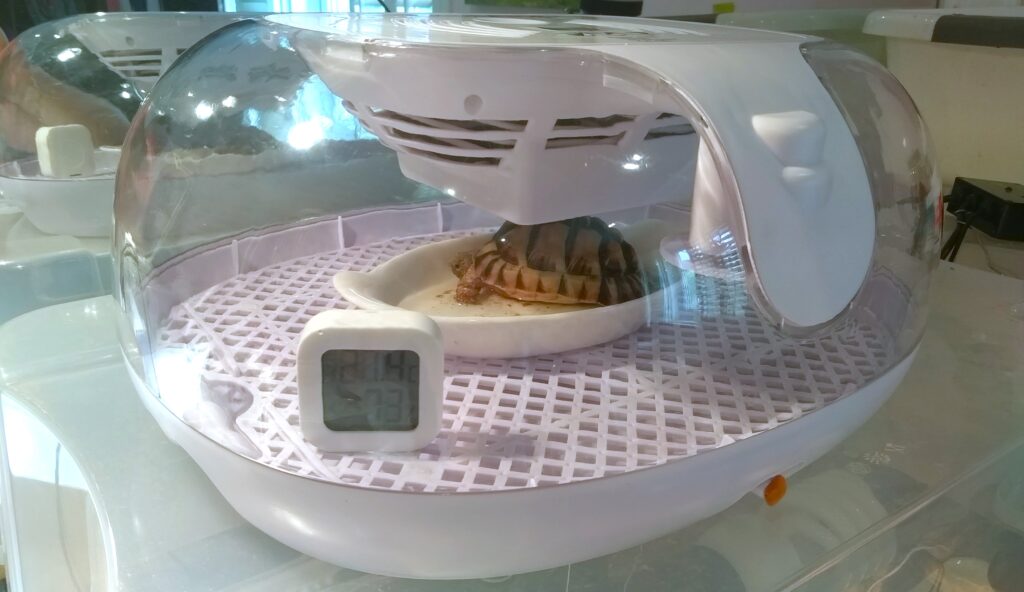
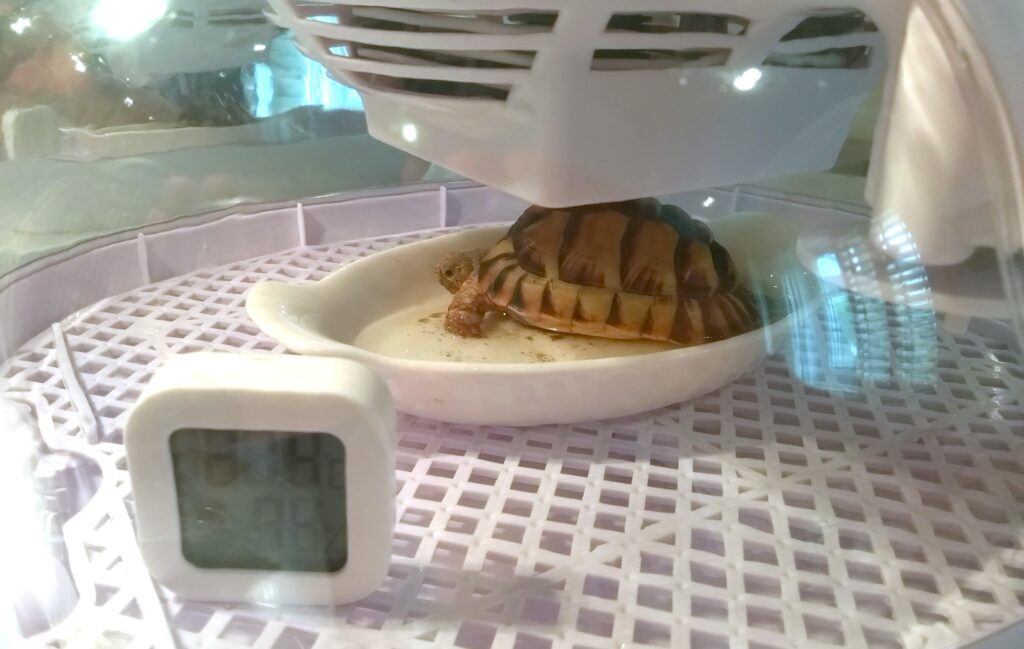
– please notice, to the bottom left is a Thermometer & Hygrometer so I can constantly watch the Temperature and Humidity and keep these suitable
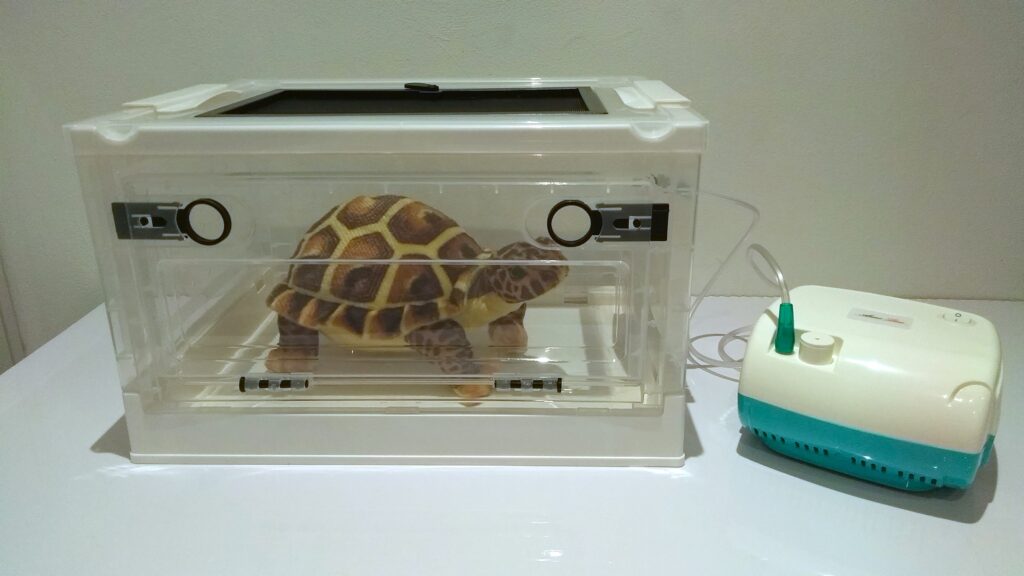
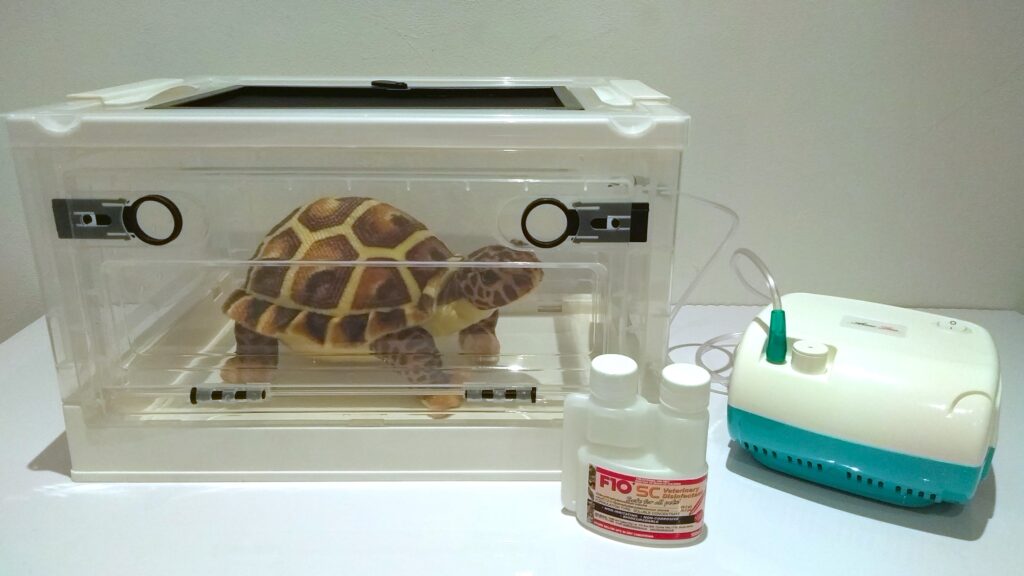
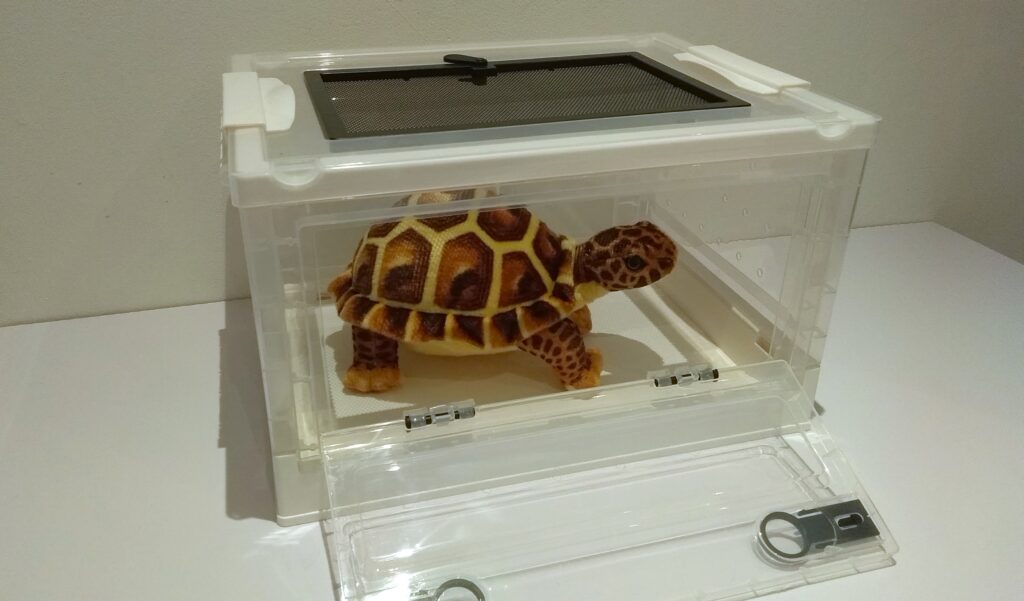
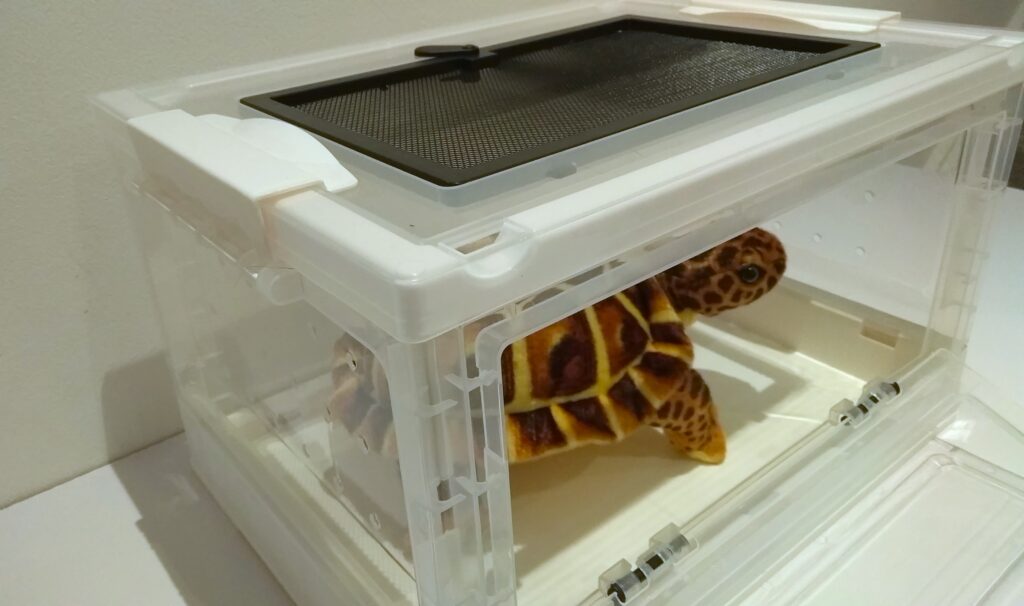
A closed chamber like the above examples also serves as a very suitable Oxygen Tent or an Ozone Tent. Oxygen and Ozone have proven to increase healing and shorten recovery times in injured animals and are being used more and more by Veterinarians and animal hospitals.
Another option for simple regular baths is to use a Brewers Pad, or Brewing Warming Base like the one below, from Love Brewing UK, i this instance. This Electric Heating Base does not get very hot, as it it is meant to just keep the Wine or Beer warm enough so the yeast can ferment, meaning its safe and suitable for a good warm bath for tortoises for the duration of their soak.
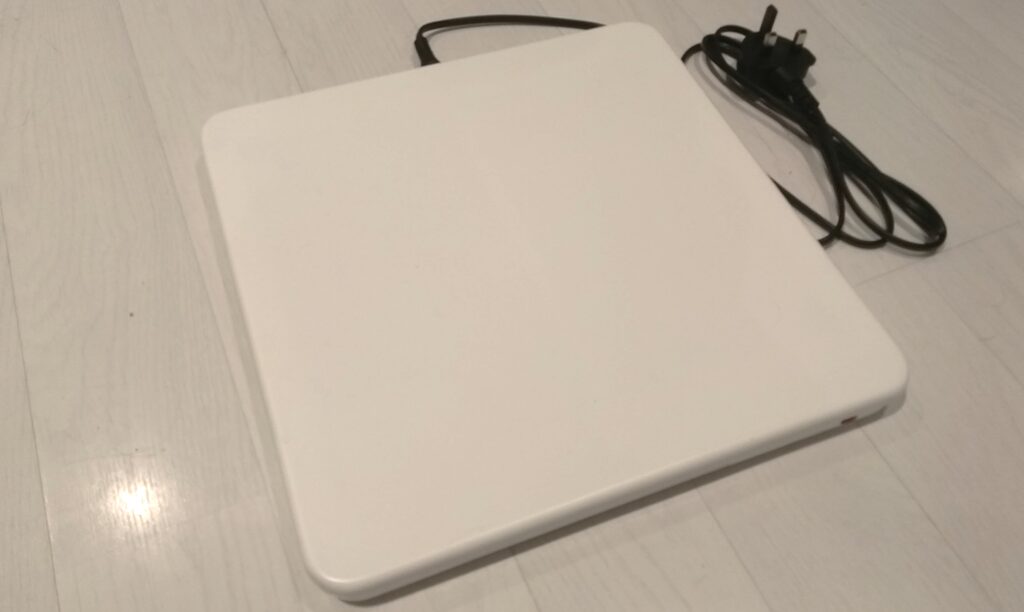
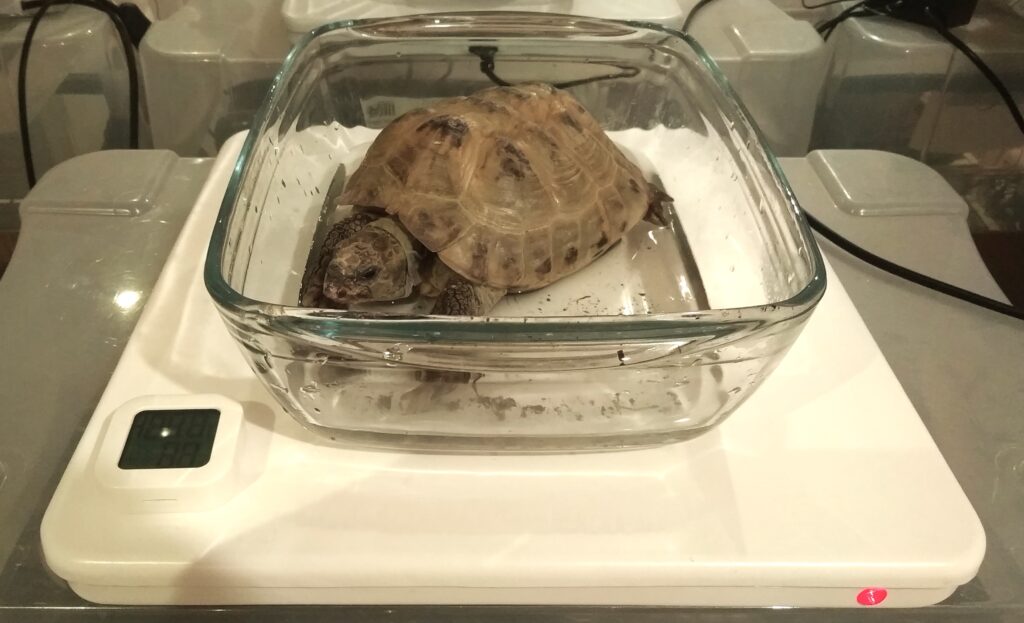
again please notice, to the bottom left is a Thermometer & Hygrometer so I can constantly watch the Temperature and Humidity and keep these suitable
You can then also add some of these tortoise specific therapeutics to the warm water your tortoise will be placed in:
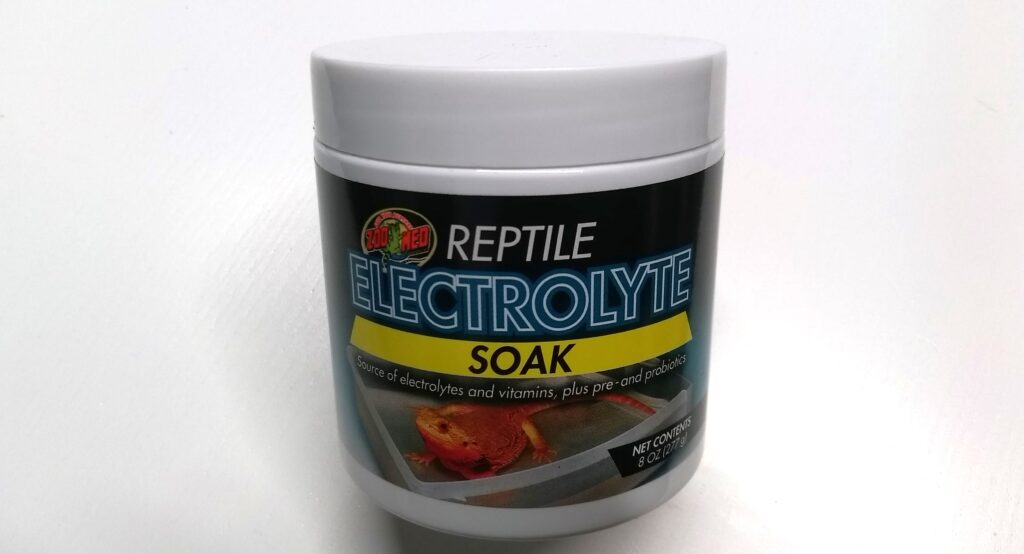
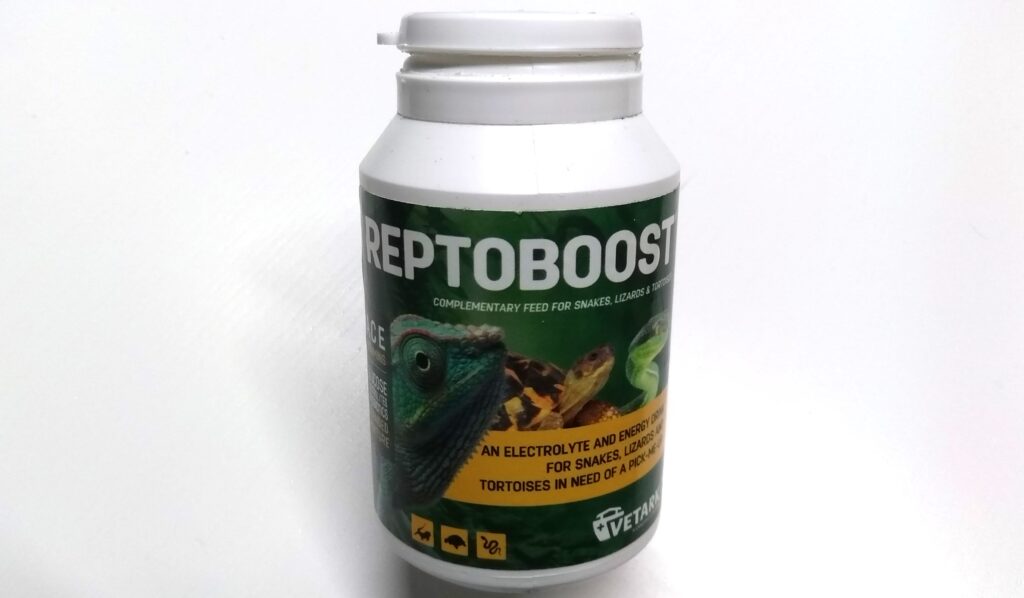
For runny eyes.
Runny eyes can be treated reasonably successfully using an over the counter eye drop treatment called Brolene. Brolene, so far, has shown reasonable effect and very limited side effects in most pets, horses, cats and dogs too. But, runny eyes need to be watched closely as they can be the start of much more serious Mycoplasma infection, which spreads to other parts of the body and then cannot be treated with Brolene, and would need in this event, a more professional treatment with something like Doxycycline.
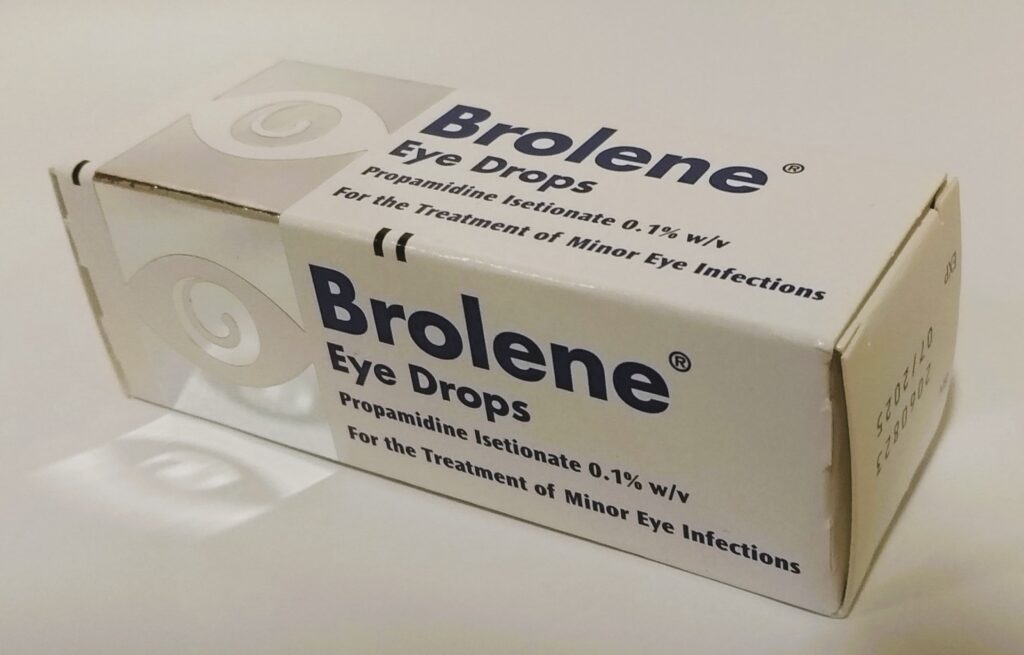
For Runny Eyes not caused by Chemical or Inorganic Irritants
Keep in mind, that Brolene is a human medicine and so strict calculation of the reduced dosage for a smaller animal is very important.
Runny eyes on their own with no nasal discharge or a runny nose, is very often caused by an irritant of some sort. Something lodged in the the eye for example, or pollen, but can also be from chemicals near by or spilt previously, or… carpets. Understand that carpets don’t rot or harbour pest easily because they are essentially treated with poison, to prevent these unwanted nasties. Tortoises should not be kept on carpets ever. Laminate Flooring is better, but even that is ‘treated’ with anti fungal, anti bacterial and anti viral properties. Some of the eye irritants and toxins found in carpets are phthalates, and (VOCs) Volatile Organic Compounds. Phthalates are endocrine-disruptors which cause hormonal changes in the body and disease. Hormonal changes can lead to runny eyes in torts and humans.
Polyvinyl Chloride, or PVC, is also often found in carpet and can also lead to eye and respiratory irritation. So don’t use PVC in enclosures. Remember, torts are right down close to the floor, and are thus much more susceptible than us humans.
For intestinal and digestive intestinal tract (GI tract) pathogenesis or disease:
Worms and Flagellates are common causes of disease in tortoises – causing ill health, lack of apatite, straining to go to the toilet, dehydration, organ failure and often death.
Flagellates are single cellular organisms that use one or more flagella to move around, a type of flagellate that many people know about, is the common sperm cell – it has one ‘tail’ of flagella. Flagellates will reside in the gut of many animals and people, they are mostly symbiotic and will cause no harm, often aiding digestion, but in unnatural captivity and general poor health, some will overburden & multiply out of control and cause disease. Often indicated by runny poo.
Two common, well known and long used drugs for Flagellate overload and intestinal worm burdens in tortoises, as well as other species including humans, are:
Metronidazole & Ronidazole. These are prescription drugs, they are such because they make money for their manufacturers and the Pharma chain downstream, including vets, but most importantly, because they are poisonous in excess amounts and need to be handled with great professional care.
If you are experienced and sensible, these drugs can be obtained without a prescription in what I call the grey medicines market, and they can be administered quite easily. But, you must have a full and broad understanding of when and how to use them. The best way to do that, in the first instance, is to develop a relationship with a vet, even if the said vet is not an exotics specialist, any vet can send samples off to a lab for diagnosis and a pathology report. This best positions you for an accurate etiology, diagnosis / prognosis, and thus a more effective regime of care and treatment for your exotic.
If you are to administer these drugs yourself, you should use your own microscope to assess parasite load, and determine whether there are too many parasites / flagellates / worms, thus requiring medication, or, whether the burden is negligible, thus indicating another cause for the abnormal pathology in your tortoise. Remembering, these are prescription drugs and cannot be administered willy-nilly.
Parasitic infections & impaction often present with the same symptoms, but require completely different interventions and medicine. Furthermore, these drugs are known to have carcinogenic properties, they should only be administered if the right pathology is discovered, and using the right dosage, and handling them with care. Ideally with the guidance of a vet.
You can too, send poo samples off to be professionally assessed by a dedicated laboratory. However, this has sometimes proven counter-productive. It is a good option though, most of the time. A quick search online will offer up some options:
https://startortoises.net/fecal-exams.html
https://www.sciencedaily.com/releases/2012/05/120523200301.htm
https://news.yale.edu/2014/05/05/study-finds-turtles-are-closer-kin-birds-crocodiles-lizards-snakes
https://www.ucl.ac.uk/museums-static/obl4he/vertebratediversity/turtles.html
One, I now will go to is Tolisan TKK Tricho Green Powder – and mixture of Metronidazole & Ronidazole and Ethacridine lactate (used against Gram-positive bacteria overload, such as Streptococci and Staphylococci and limited effectiveness on Gram negative bacteria like Mycoplasma (Mycoplasma is an odd bacterium – not a true Gram negative bacteria, so is best treated with something like Clarithromycin at the time of writing) But, a seasoned Exotics vet will advise, medicine popularity and type of medicines used change like the weather often.
Tolisan TKK Tricho Green Powder is used for Racing Pigeons, which are often very valuable, so a great deal of research and expertise have gone into this medication. Veterinarian Dr. Vincent Schroeder, the man behind Tolisan TKK Tricho Green Powder is probably the most well qualified vet in the field of veterinary drugs for birds, I will ever come across.
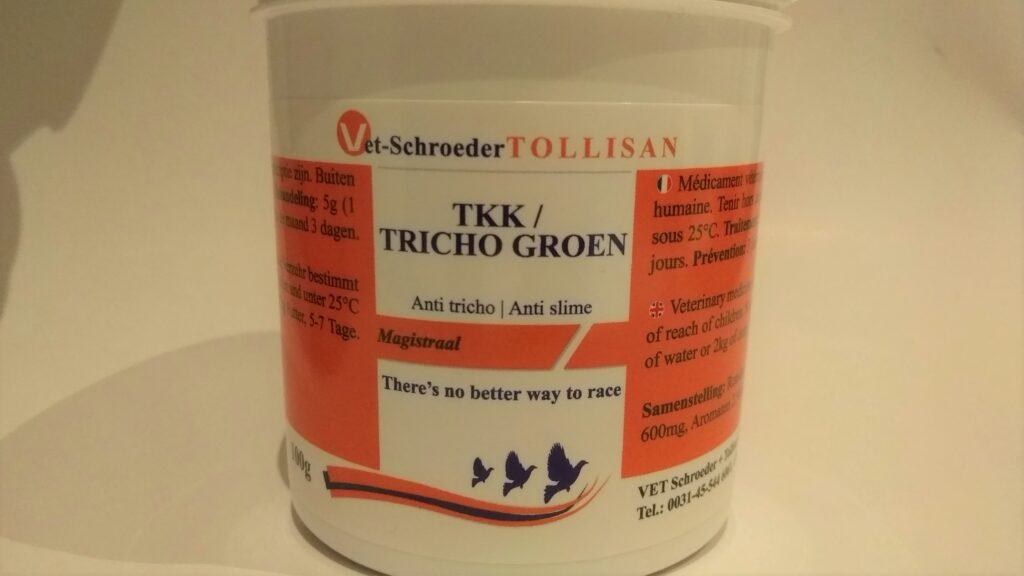
While birds are not tortoises, they share much taxonomy – here are multiple links to the same study but I include them in case some links might become unusable. Not all medicines are appropriate for use on both birds and tortoices as they vastly different metabolisms, but soome meds are suitable and all we have to work with for Tortoise treatment.
https://www.sciencedaily.com/releases/2012/05/120523200301.htm
https://news.yale.edu/2014/05/05/study-finds-turtles-are-closer-kin-birds-crocodiles-lizards-snakes
https://www.ucl.ac.uk/museums-static/obl4he/vertebratediversity/turtles.html
*A bit about the man behind Tolisan TKK Tricho Green Powder: https://www.schroeder-tollisan.com/
A bit about Ethacridine lactate as an oral medication
“Oral ethacridine lactate is effective primarily locally in the intestine at a local level, and almost none of it is absorbed. It has astringent and antibacterial effects and some spasmolytic activity (reduces abdominal pain, spasms and diarrhea)
As little of it becomes biologically available through absorption, an increased risk for malformation appears to be unlikely” – extract from Science Direct.
https://www.sciencedirect.com/topics/medicine-and-dentistry/ethacridine-lactate
Acridine, of Ethacridine lactate possesses potent antibacterial, antifungal, antiparasitic and antiviral properties.
https://www.sciencedirect.com/science/article/pii/S2405609X17301446
Anti-bacterial property is very important here, as tortoises, reptiles in general and indeed any organism will have a reduced immune capability if inflicted by an injury or infection. So, if your tortoise has a parasite overburden, taking large amounts of nutrients from the tortoises’ intestine, it will likely be very susceptible to other infections like Pneumonia. Tortoise Pneumonia is often caused by the bacteria Mycoplasma which often attacks the lungs. Anti-bacterials in medicines primarily aimed at parasites are thus beneficial in preventing secondary infections and comorbidities while your tortoise is under treatment.
Another broad’ish spectrum antibiotic, similar to Tolisan TKK, used on wide range of pets and Tortoises, is Enrofloxin / Enrofloxacin, also known as Baytril® Effective against Gram positive and the more resistant Gram negative bacteria like Mycoplasma, that causes such a problem in Tortoises often. Batril has been poorlly received by some tortoise species and is not advised for a treatment in these cases.
Benzimidazoles
The benzimidazoles, such as fenbendazole and flubendazole inhabit the spectrum between Supplements & Homeopathy, and Allopathy, they don’t require a prescription, but are medicines, they have a long history, are well understood and they seem to be well tolerated generally and are regarded as having low acute toxicity. Always still be mindful of dosages though, with medicines.
Research has also shown fenbendazole and flubendazole have anti-bacterial properties too, they are also believed to have the ability to reduce the production of inflammatory cytokines as well. Too many cytokines can lead to excess inflammation and conditions like autoimmune diseases. Autoimmune disease or disorder is when one’s own bodies defenses attack the parts of the body itself, thinking these parts of the body are actually infection and should’nt be there, it is usually an over reaction by the bodies many defenses to a threat or perceived threat.
https://my.clevelandclinic.org/health/body/24585-cytokines
“The benzimidazoles, such as fenbendazole and flubendazole, have the same mode of action”
https://pmc.ncbi.nlm.nih.gov/articles/PMC8402879
But the Benzimidazoles have also shown to have anti-viral properties, which is very encouraging, as another comorbidity or secondary infection onset in compromised tortoises, can be the viral infection Testudinid herpesvirus 3 (TeHV-3) or Tortoise Herpes, is quite common, very infectious, and almost always 100% deadly. While no studies exist with regard to Fenbendazole efficacy on Tortoise Herpes particularly, the ncbi.nlm.nih (link below) on Bovine Herpes virus-1 (BoHV-1) is very promising. However, it must be noted that herpes viruses are quite diverse and largely species specific, so correlations in treatment might be weak. But, Fenbendazole is a good bet none the less.
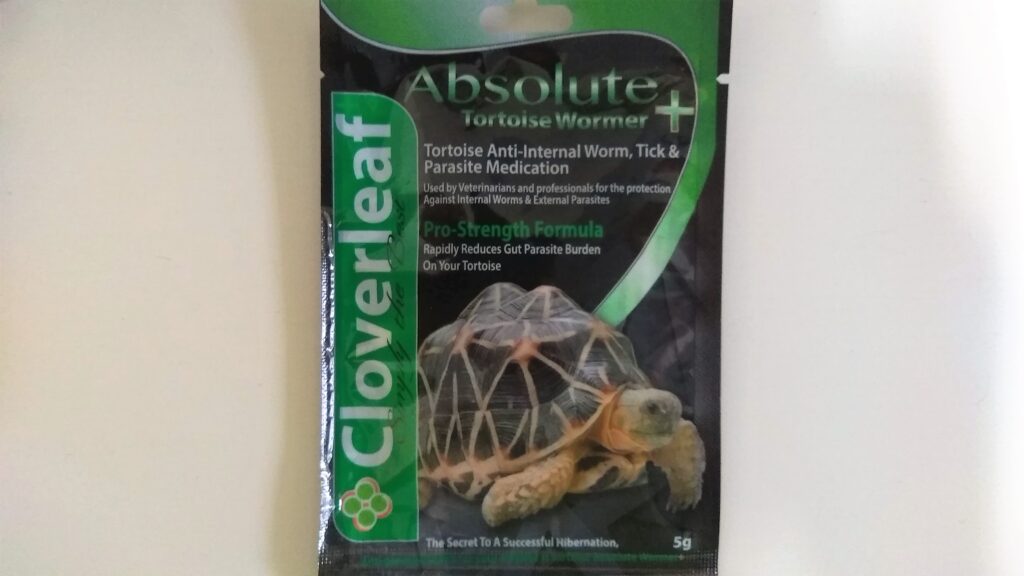
Also, the study below shows that Fenbendazole seems to have limited (insignificant) or no effect at all, on GM – Gut Microbiome (the good gut bacteria / microbiota)
https://www.ncbi.nlm.nih.gov/pmc/articles/PMC7338874/
https://www.ncbi.nlm.nih.gov/pmc/articles/PMC7533386/
DRUGS NOT TO USE FOR TORTOISES:
Don’t use any drug in combination with another, unless expressly mentored and guided by an appropriately knowledgeable person or vet. Remember, some vets have a narrow understanding of things, so, ladies, make love to lots of vets, and pick their brains.
Metronidazole & Ronidazole are of the group of broad spectrum antibiotics called nitroimidazoles. Used together in Tolisan TKK Tricho Green Powder for racing Pigeons provides confidence, as racing pigeons are very valuable and the manufacturers would need to have done their research extensively to successfully market their drug. So we regard this as an exception to the rule of not mixing drugs. Veterinarian Dr. Vincent Schroeder, the man behind Tolisan TKK Tricho Green Powder is probably the most well qualified vet in the field of veterinary drugs, especially for birds, I will likely ever come across.
Ivermectin Dont Use – while Ivermectin is a Nobel Prize winning brilliant drug with a long track record of success in animals, and also humans, for over 50 years, it has proven to be very badly received by tortoises, and has caused death. This is proof, that one should know what one is doing and have done extensive research before administering any drugs. And be close to vets. Some drugs work wonders for some organisms, while others are deadly.
Impaction.
Impaction in tortoises can be quite common and often very serious. It is caused by dehydration, or ingestion of sand, or ingestion of stones, or an over burden infection of parasites, or a combination of the above.
Tortoises will eat stones, also known as lithopaghy, for a number of reasons, just being inquisitive, mineral craving, to help with control of intestinal parasites, to help grind up food in their stomachs and perhaps just shear boredom, but they seem to be able to handle this activity without many problems arising, far better in the wild.
Unwanted objects will need to be removed or moved out of the Tortoises body (whether they be swallowed Stones, Sand, Lego or Calculi. Calculi, also called Uroliths are mineral deposits that form in the Bladder (Bladder Stones) or other parts of the urinary tract or Cloaca (Vent) They can often form because of poor diet or dehydration, but often are a part of life for wild animals too.
Surgery is often required if an Xray or MRI or CAT correctly identifies a lodged Stone or Stones, Sand build up or Urolith.
However, Xrays are not good for long lived organisms like tortoises, and so, other options should be tried in the first instance, but timeously, as Surgery should never be delayed, especially if your tortoise is showing signs of struggling. Surgery, while expensive, is usually very successful on Tortoises.
Once a correct diagnosis is confirmed, Frequent bathing, bathing in water containing a bit of Diatomaceous Earth, of which the Tortoise is likely to drink, when bathing, and Feeding Prickly Pear & pads and Aloe Vera and Pumpkin is suggested.
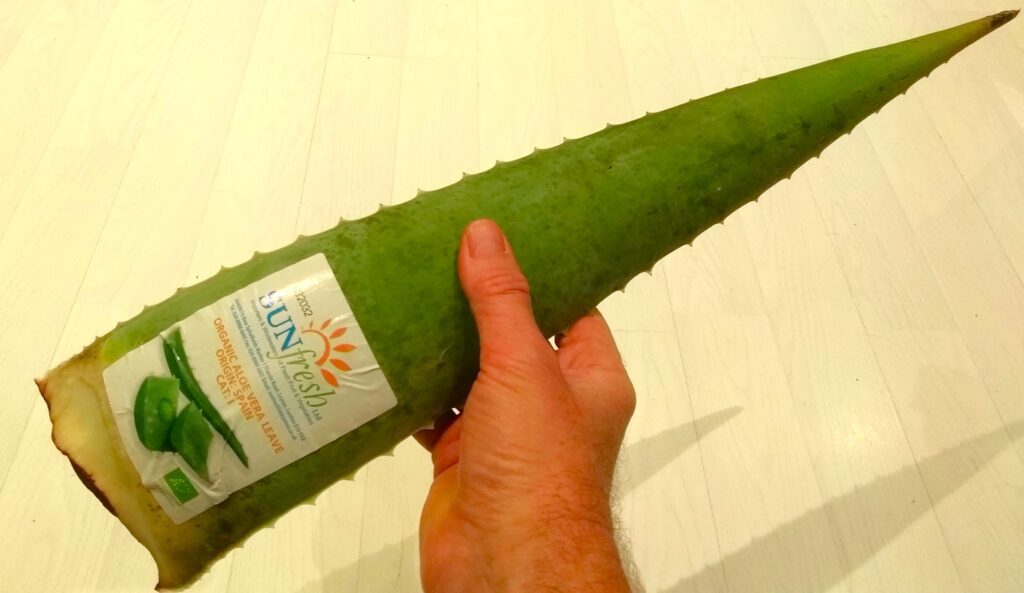
One option to dislodge objects is Vibration. A longish car drive with your tortoise can sometimes dislodge Sand impaction, Stones and even Calculi. But also using a Vibrator strapped to the tortoise under shell can help.
PIC of Vibrator
Medical Care ongoing
Increase the temperature in the mitigatory enclosure holding your sick tortoise, to above medium or normal, they are reptiles and do better in warmth generally. Temperatures are species specific, but, thay are also individual specific. In other words, how the individual Tortoise or tortoises have been raised by the previous keepers is very important as to how they will be effected by Temperature. An Egyptian Tortoise may be quite at home with an night time temperature of 10° – 15° degrees Centigrade , which is normal for on the coast of the southern mediterranean where they are from, if a keeper in say England has kept them at 27° C all their lives day and night, you suddenly acquire them, and allow their enclosure to drop to 15° C they will die! So, general temps & humidity levels may become completely irrelevant to your situation. Thus, always inquire, on acquiring an exotic, exactly what they are used to temp and humidity wise and even food wise. When ill raise their enclosure temp by between 5° and 10° to what they are used to, but never exceeding 35° C temperature.
Administering drugs & medication
Be very careful when opening the mouth, any slight injury to the inside, or even outside of the mouth can invite infection, most particularly a common tortoise infliction, namely Stomatitis. Stomatitis bacteria takes advantage of open wounds in the mouth, and the low immunity that will accompany a sick tortoise. Also make to sure to exercise very good infection control and very gentle handling. Don’t handle or do any husbandry of well tortoises while dealing with your sick tortoise or exotic, keep segregation and hand washing at the top of your list.
Get doses right: Too little and you risk not stopping the infection and facilitating drug resistance & ineffectiveness or Antibiotic Resistance. Too much and you risk lethally injuring / over dosing your tortoise.
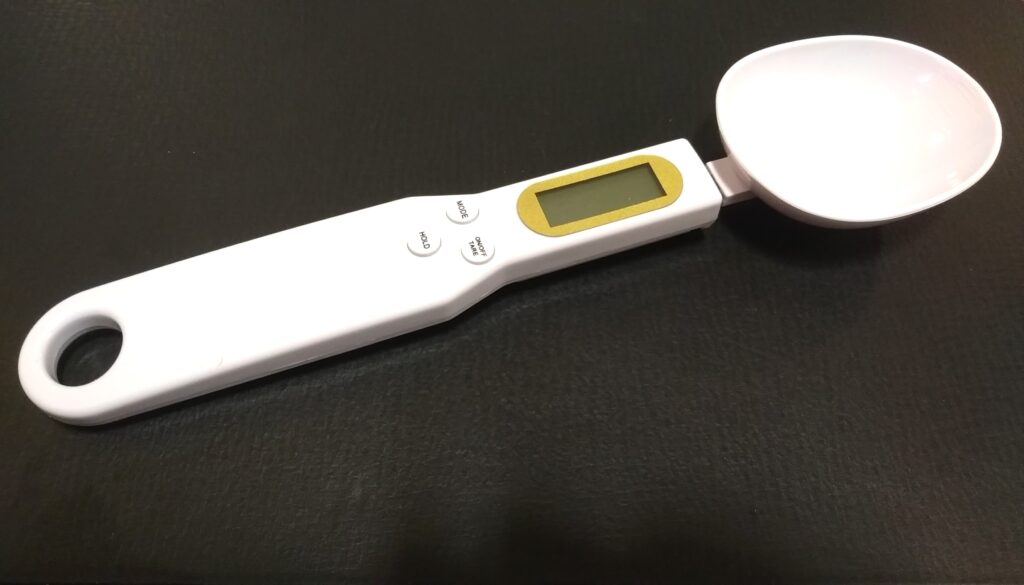
Obesity
Obesity is caused by over consumption of calories? Not so accurate.
Obesity is caused by the wrong diet, a toxic diet, and or, stress, lack of space to exercise or sometimes rarely, a genetic disease. The same as with humans. If you are, a human, try getting fat or obese by drinking organic ‘healthy’ (as opposed to unhealthy) smoothies every day, moving to a strictly vegetarian or vegan diet & working out or walking to work. You will have a very hard time, getting to be overweight. If you acquire an obese tortoise, or your tortoise becomes obese, it has a metabolic disease, is not able to exercise, because of lack of space, injury, disability, or your UV light is too close or too intense, or, it is being literally poisoned by its food or water or something else, just like humans. Remember, toxins are very often stored / dealt with by adipose tissue / body fat tissue, the more toxins or inappropriate substances consumed – the more likelihood of fat and obesity. Genetic disease can also cause shell malformation or cause obesity, but this looks to be very rare as a cause.
https://www.sciencedaily.com/releases/2017/01/170111184102.htm
https://www.epa.gov/international-cooperation/persistent-organic-pollutants-global-issue-global-response
Adipose Tissue (fat) as a Site of Toxin Accumulation
https://www.ncbi.nlm.nih.gov/pmc/articles/PMC6101675/
Common Serious Diseases of Tortoises
Metabolic bone disease or MBD
MBD is the malformation of bone, and thus shell as a result.
It presents as unnatural shapes of the shell – often called pyramiding, or soft shells, weakness – inability to walk properly, constipation or general bad health.
A number of factors assist in causing MBD, but most specifically, it is caused by not enough humidity and water uptake, followed by incorrect diet – not enough calcium, not enough UVB exposure – UVB assists in metabolizing calcium using Vitamin D3 derived from the correct light exposure and food. Vitamin D3 can be supplemented in food additive form, but getting the right real sunlight is best. Real sunlight also boosts mood in tortoises as it does in humans. Real sunlight body produced Vitamin D cannot cause an ovedose, while synthetic (and they are synthetic) human made Vitamin D creations like alfacalcidol, calcitriol, calcipotriene and doxercalciferol can, and their make up is different too.
If caught early enough, the deformity itself is not of great importance to living a good life, but likely reduces life expectancy by impacting normal organ functioning.
Now, slight deformity or pyramiding can be a good sign – why? because it shows that the tortoise you have acquired or are getting, is a captive bred specimen – and well bred captive bred tortoises, are better suited to being pets in captivity.
Below is Tommy Four Fingers, our adorable Russian Gangster rescue – unlike most other tortoise species, Horsefield’s have 4 toes instead of 5. Four Fingers did not have the best start to life as can be seen by his shell and the presence of Lordosis or abnormal curvature of the spine, but his personality sure makes up for it now.
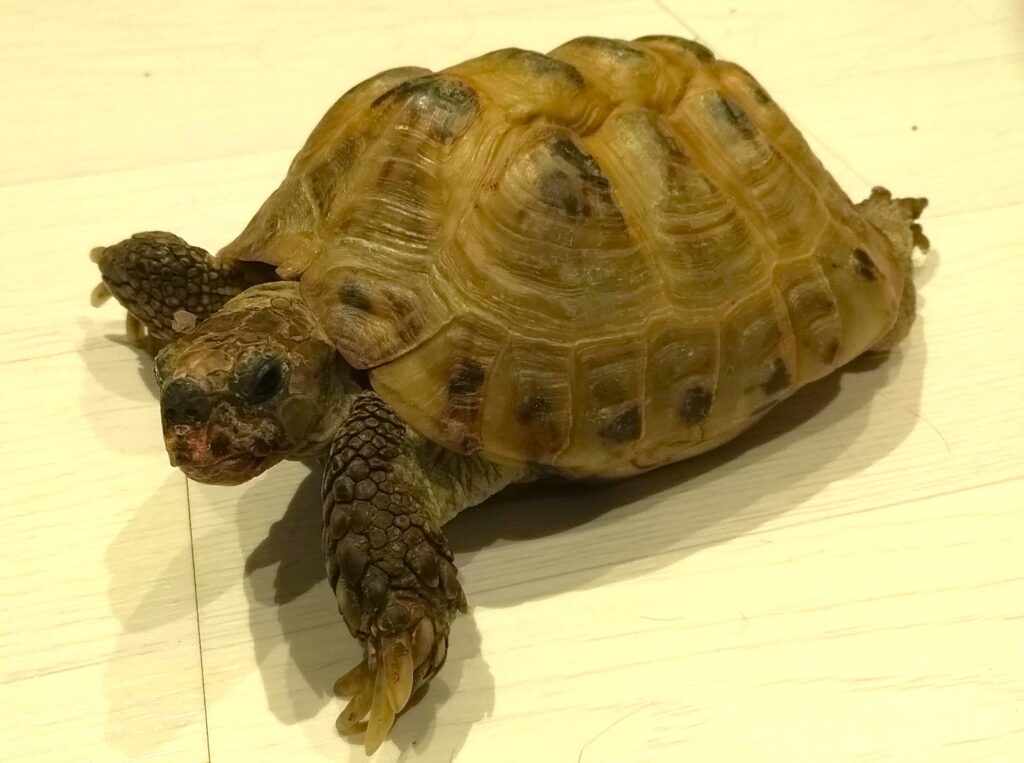
Mycoplasma Infection
This is a bacterial infection that primarily infects the respiratory system of tortoises.
Presents commonly as: rhinitis – constant runny nose, conjunctivitis– infected eyes, ocular discharge – bubbly eyes like soap bubbles, runny pussy eyes, or palpebral edema – permanently swollen eyes. Similar to Herpes infection, and often a comorbidity.
https://journals.sagepub.com/doi/full/10.1177/1040638717722387
Herpes Type Viruses
The most common of these seem to be Testudinid herpesvirus genotypes (TeHV)1 2 but also 3 & 4 exist. They often are dormant in healthy tortoises -asymptomatic carriers, and only inflict symptoms via Immunodeficiency caused by another infection, sudden poor diet, injury, stress from change or a move or, the introduction of another specie that has been more or, less robust and carrying the virus.
https://www.ncbi.nlm.nih.gov/pmc/articles/PMC8549816/
They present commonly, among other things, as mouth sores – stomatitis (mouth colour changes, puss and not wanting to open mouth or eat) permanently swollen eyes, respiratory illness – Bronchiolitis or pneumonia, wheezing, mouth gaping trying to breath, runny nose. Some of these may be present but likely not all at once until maybe close to death.
Identification and diagnosis of TeHV in Tortoises is best done via Viral Culture by a lab, PCR is not the most accurate assay.
Other less common diseases include: Picornaviruses, Paramyxoviruses Reovirus & Ranavirus
Where to acquire tortoises
Rescues or pass ons would be your best first option for a first time owner, they will often be adults, who are already acclimated, more robust, as their immune systems will be better developed, and thus survivability more insured because, well, they have already reached adulthood. They will be used to being a pet, and past that crucial juvenile high death rate phase.
Baby tortoises can be a challenge to raise, so this is best left to experienced keepers. Most tortoises will lay quite a number of eggs / have quite a number of babies – this is an indication that the species has evolved to loose high numbers in mortality. Unfortunately, not to the extent for current environmental challenges and poor husbandry from keepers – way too many individuals die, needlessly, in the wild now, and particularly in captivity.
Also, make very sure your Tortoise you intend to acquire is not stolen, buying a stolen Tortoise is much like taking one from the wild, they will have been very stressed out and shocked by new surroundings, and not looked after properly by the criminals, and likely offered unusual food, incorrect lighting, likely just stuck in a box or sack. This may very well mean your new pet will die, unless you are very experienced with tortoise care and rehabilitation.
In the UK, there are some sites with much availability of tortoises needing new homes *be careful though, as with anything online, there will be many scammers about.
These sites are:
www.preloved.co.uk
www.pets4homes.co.uk/sale/reptiles/tortoise
www.freeads.co.uk/uk/buy-sell/pets/reptiles/tortoises
Advanced Keeping
Advanced Keeping of Exotics involves the use of sophisticated Lighting, Dimming, Heating, Cooling and Humidity Regimes to automatically simulate Circadian & Diurnal Cycles and Seasonal Cycles to better accommodate a realistic natural experience for your exotic, to facilitate better health, enrichment and breeding. It would ideally also involve seasonal adjustments to diet. And, must involve the use for extra Fire Safety. It also involves other environmental and enhancement factors which we will discuss further, down the page.
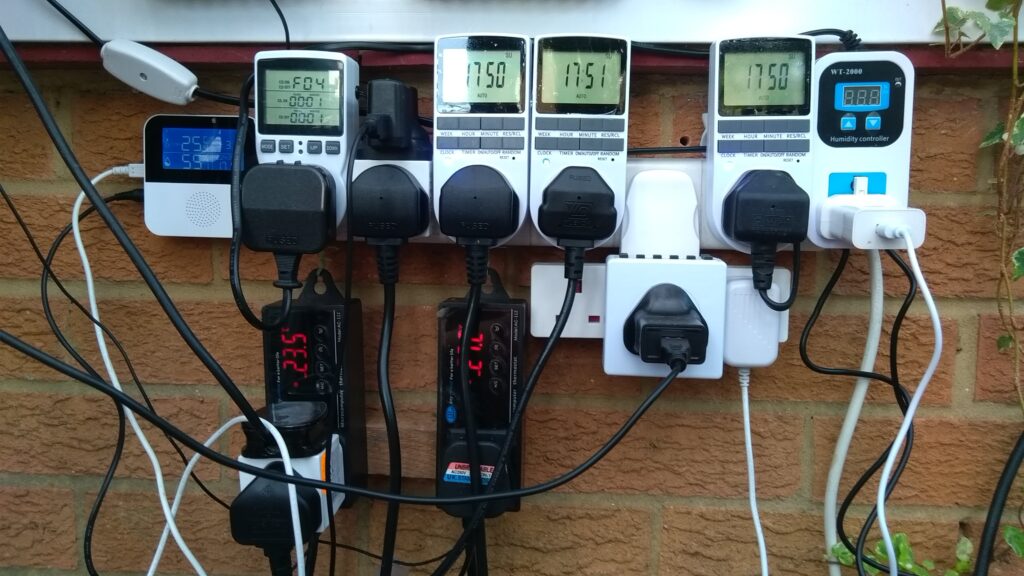
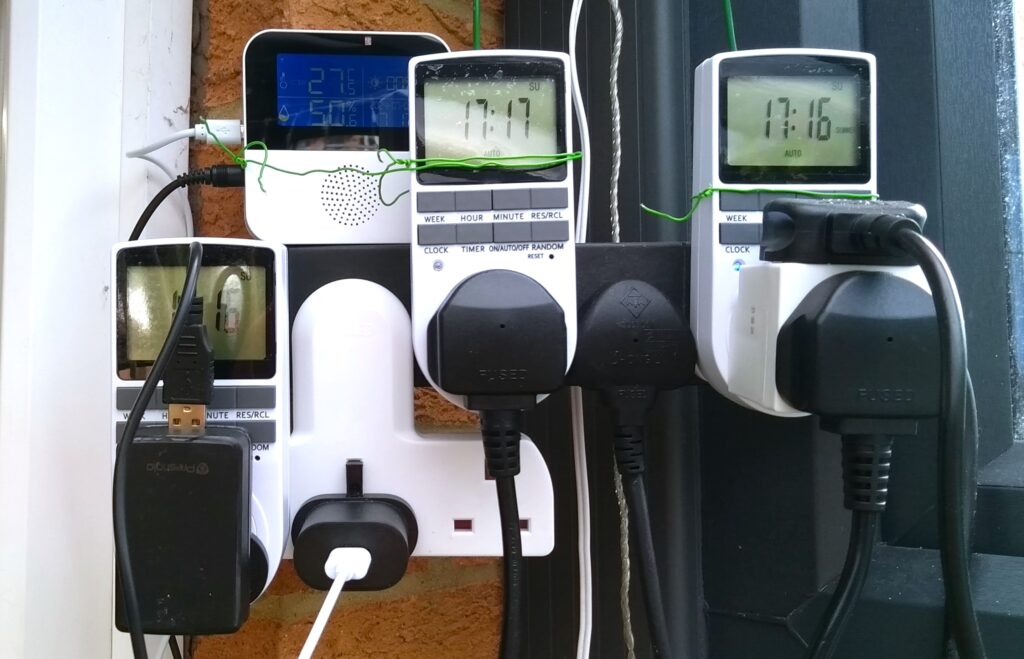
With the Added Electronics, comes a need for added Safety Controls. I always use at lease 3 totally separate Safety entities ( triple redundancy ) This approach ensures, your animals, you, and your neighbours are as safe as possible. In this instance, I am using ‘Double Redundancy‘ on the Plug Timers to control staged / stepped lighting, and ensure this particular enclosure does not become to hot, or too cold, this also reduces the chance of a fire by failure of the electronics. Included are timed controlled Sprayers to control Humidity, and very small fans to control airflow, running off of a very small solar panel, and ensure stale air is removed from the enclosure, but removed rather slowly to avoid ‘cold draughts’ or excessive drying out. Included too, is a timed UV light for a very limited period each day – usually only a few hours (more about UV… and the problems with UV, further down in this section)
Safety and Monitoring
Also required are Fire Safety Regimes, such as appropriate Fire Extinguishers for Electric Fires, and Smoke Alarms, Our home is also naturally fitted with new up to date residual current devices RCDs and Miniature Circuit Breakers MBCs on our circuits.
You should also use Temperature, Camera and Fire alert APPs. The tragic case of Gary Priddle and the death of his collection of precious Aldabra giant tortoises from cold while he was away for Christmas when his electrics failed, will remain all to vivid in our minds.
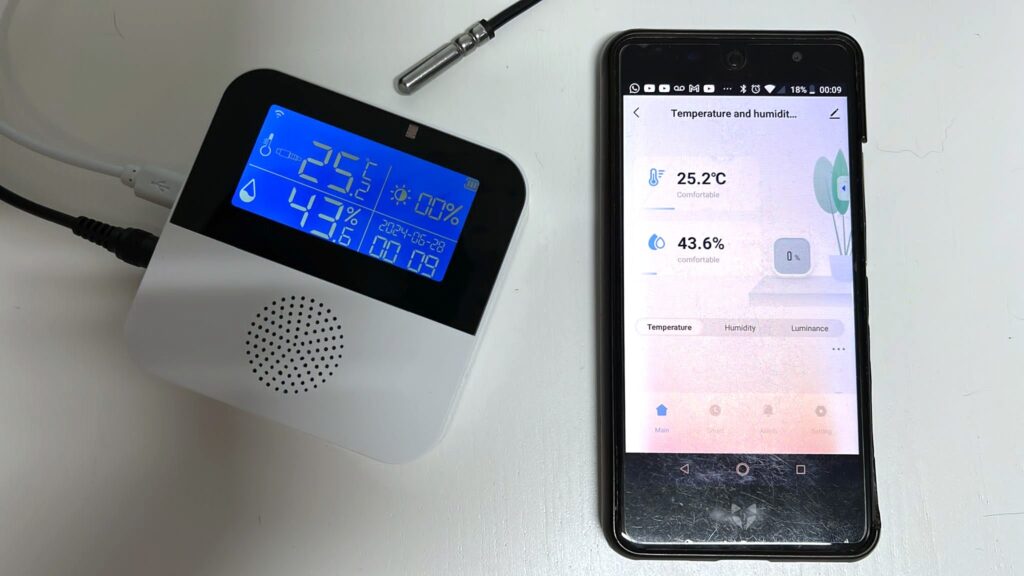
Loading monitoring Apps on your phone, and using them when you are not home, can mean the difference between life and death. Knowing if a fire has started at home, or if your enclosures have become too hot or too cold, and also being able to see what is going on in your enclosures for interest and security, should be a priority when keeping exotic animals, or indeed any pet. Warmth is vital, Tortoises and reptiles in general, can survive without light for pretty long periods, they can survive without water for long periods, and without food for even longer. But, a sudden significant drop in temperature for most species, will result in death reasonably fast. So, after your central heating / gas heating, or reliable solid fuel heating, and electrical heating, you should have another third backup ready. Remember the “at least 3 unrelated safety and control features” Rule. I have a diesel heater ready for winter time, but, which also requires a safety regimen. It will become clear in the future, how important this third backup will be.
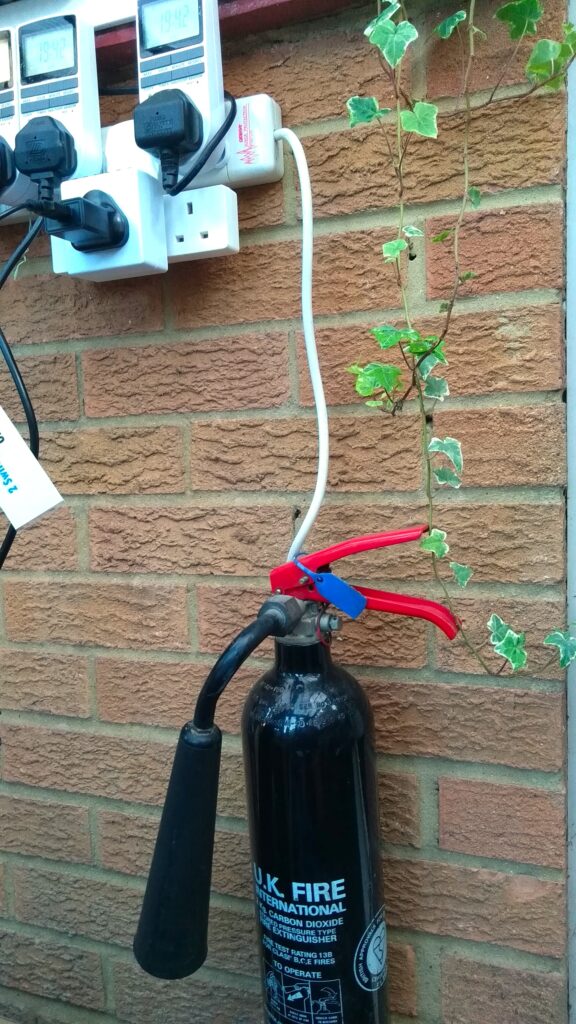
-Halon Extinguishers or other Clean Agent Extinguishers are not at all advised-
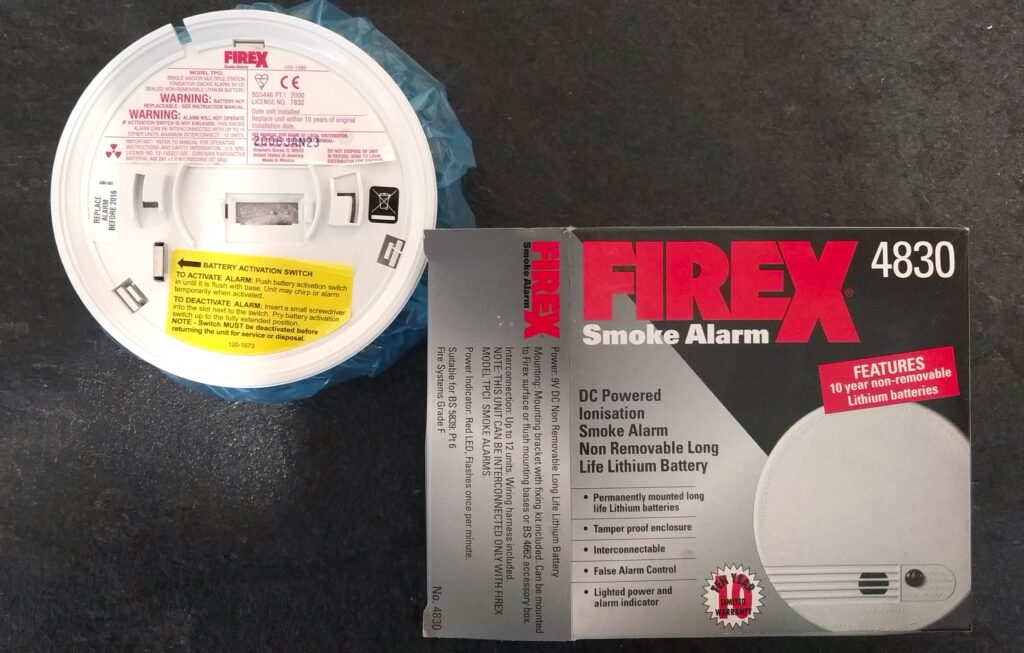
Lighting: Advanced Lighting Regimes
We are still learning a great deal about light / lighting and its effect on ourselves and life on earth in general, in the wild, and in captivity. The natural suns influence on Flora and Fauna, its influence on physical health, mental well-being, and reproduction is complex and significant.
But, we already know a significant amount about Light / the Suns importance on the health of our pets & us. We are familiar now with UV Light radiation and its importance for healthy physiology, bone and shell growth. Advanced lighting setups should be incorporated into your enclosures, and husbandry, from the start, and with great detail and ongoing adjustments and modification, and with lifetime learning. Using Timer Plugs, Thermostats, Dimmers & Double / Triple Redundancy for Safety. With an array of different lights, with good timing management, you can get close to replicating the sun in your indoor enclosures. Timers and controllers are not at all expensive these days either, so you don’t need to worry too much about cost.
The Sun emits a wide spectrum of Radiation, called the Electromagnetic Radiation Spectrum. From Radio & Microwaves, to Xray & Gamma Rays, and Infrared, UV & Visible Light in the middle. Visible Light, or should we say, the Light of the Spectrum that allows us to see things, is just a small part of the Radiation that comes from the sun. All the Spectrum is likely having an important effect on all life, so all waves of Light are important to your Tortoise or exotic, not just visible light, UV light and your CHE (Ceramic Heat Emitter) which is too, a form of Light Radiation, namely IR (Infra Red) or more specifically IR B (Infrared B) Deep Heat Projector Lamps produce mainly IR B (Infrared B) and I use these lamps in respite and while administering medical care to sick or under the weather individuals. I’m not sure at this stage if they are all that useful being used all of the time.
Infrared A and Infrared C are not what you want too much of in your enclosure (there might be some controversy regarding Infrared A because of its deep penetration, it might be better then IR B, maybe) You also don’t want any dreaded UVC in your enclosure, even though, the Sun is delivering, eventually, small amounts of this into our lower and upper atmosphere, UVC is not encountered on the ground to any measurable extent, so terrestrial life forms are not used to it and cannot deal with it. This is why it is used as a powerful disinfectant to kill everything from viruses and bacteria to algae and mould.
But, not only will your reptile be using likely almost all of the Spectrum of the Sun, but they will be using different parts of the Spectrum at different times of the day and too, to varying degrees, so there is a lot to think about here. We at the Fauna Chain Project & African Tortoise Resource have reduced our use of UV lighting in our enclosures significantly, especially in summer time when natural sunlight in regions like the UK is adequate and utilized, until, we are able to assemble & create a true representation of what the real sun delivers. No one is currently doing that in any significant way. The lighting we are all using in our enclosures is all mixed up and wrong still, to put it bluntly. We also supplement with ingestible Vit D3.
Here, we will quickly look at the underrated problem of incorrect UV lighting.
UV Lamps are not all made equal, and are not made with the correct knowledge of the varying Types of UV Lighting and varying Intensities, in my opinion. Of course, it is important to stress here, that UV lighting for your reptile is super neccesary and cannot be left out completely. There are 3 general wavelengths of UV Light:
UVC or Short Wave UV – which, artificially, is used in industrial disinfectant light sanitizers, it is dangerous, and life on earth has little defense against it, very very little, if any of it from the sun gets through the atmosphere to reach us. So this Type of UV light is of little interest to us, other than, don’t ever use it in your enclosures!
UVB or Middle Wave UV – this is part of the Spectrum that is the part most useful to bone, shell and scale development physiology of your exotic, and the all important synthesis of vitamin D, and is the one, Exotics specialists go on about. Only 5 – 10% of total UV radiation is UVB once it reaches the Earth Surface.
UVA or Long Wave UV – this is the part of the UV Spectrum that is most noticeable as warmth, along with the Infra Red B part of light. Its most useful attributes are its importance on mental well being of an organism, behavioural and anotomical regulation, and, needless to say, a host of other important effects, I am sure. That’s because, these Long Waves penetrate deep into the anatomy of organisms. But, it is this deep penetration that also causes the damage that causes collagen break down or wrinkles, and DNA damage and cancer in humans. So over exposure (and over exposure to any part of the UVA range is not good, and it is why you will find few wild animals out in the midday sun ever. 90 – 95 % of Total UV radiation is UVA, once it reaches the Earth Surface.
The problem with UV meters & UV cards currently most often used, is that they measure UVA/B together. But, given that the lamps we use are man made with all the inconsistency that often accompanies and, natural sunlight reaching the earth is roughly 95% UVA & only 5 – 10% UVB, how do we actually know what part of the reading is UVA or UVB weighted primarily, in basic metering. How do we know how much UVA1 there is, or UVA2. Its like having a scanner that tells you, you have apples and pears in your shopping basket, but does not tell you how many pears or apples, or the ratio you have, or what sizes or types they are. When in fact, its this information you need, more than a general reading. What if your UV lighting is giving off 85% UVB and only 15% UVA at very high strengths – where is the rest of essential UVA coming from, if at all? from your basking lamp at the other end of the enclosure? when they should be together – this just cannot be healthy. So I am using 2 / 3 UV meters here – a dedicated UVB meter & two dedicated UVA meters of different brands.
1) The Extech UV510 UV Light Meter that measures UVA wavelength range of 320 to 390nm The receptor lens of this brand is cosine corrected, so you don’t need to put much thought into angling it perpendicular to the sun, or looking to see where the sun is in the sky, just place it on any surface.
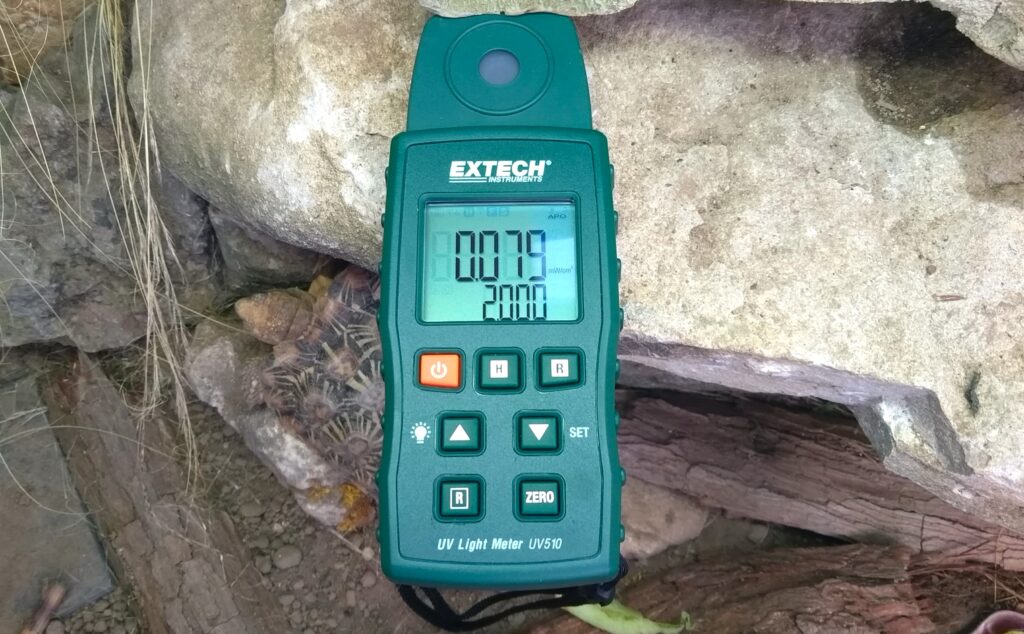
or The RGM-UVA UV Light Meter which also measures just UVA of the range 320 to 400nm
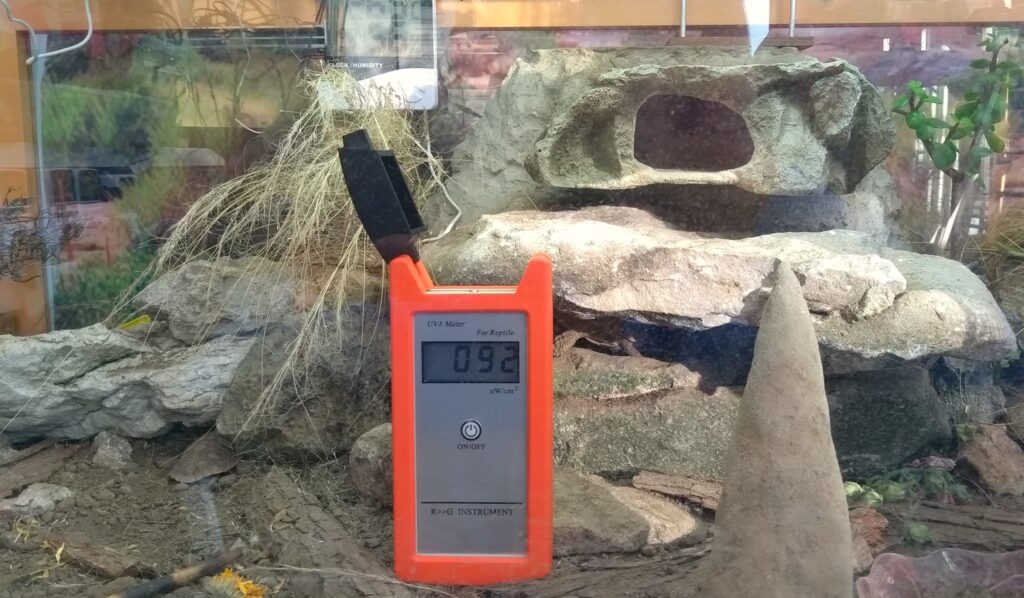
2) The RGM-UVB UV Light Meter that measures UVB wavelength range of 280 to 320nm
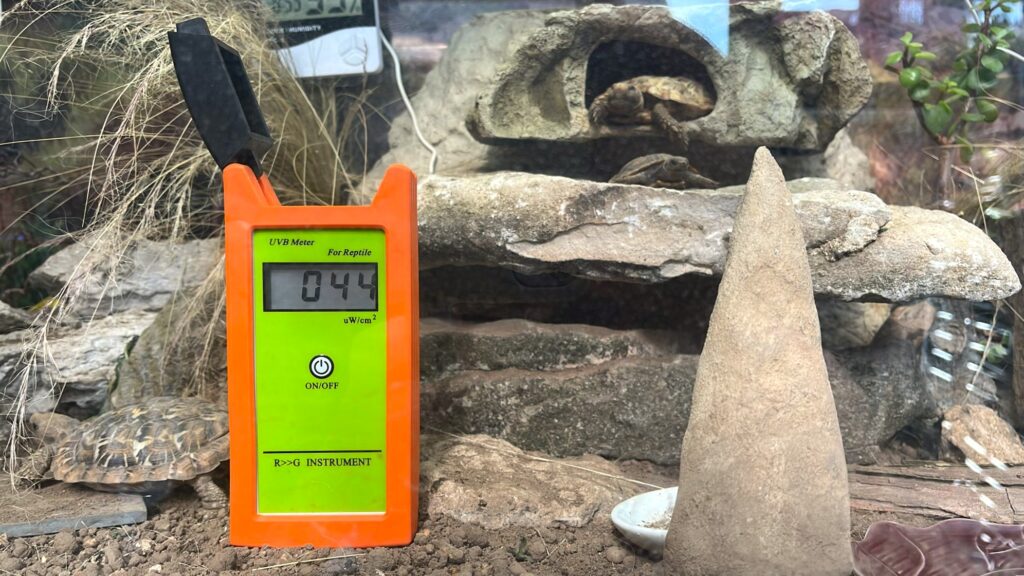
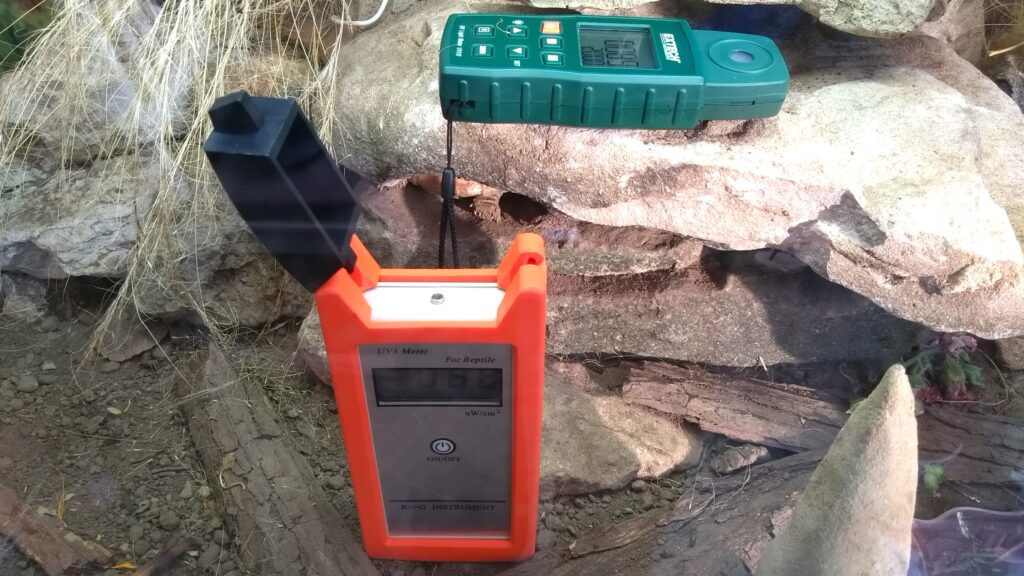
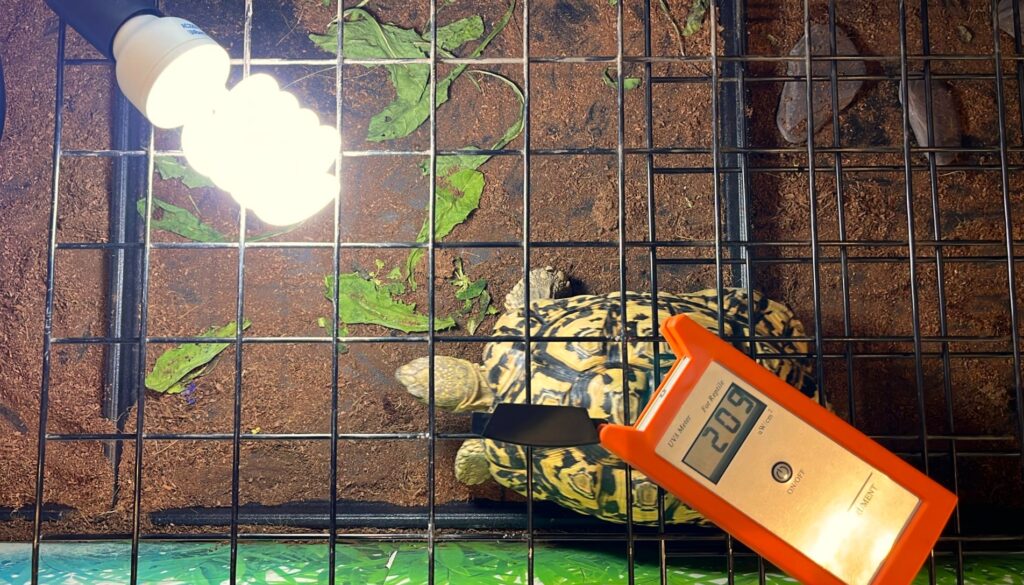
*Its worth noting, all these above readings were done on new lamps, their output will naturally fade over time. So reasonably regular readings should be taken, and lamps adjusted in height accordingly as they emit less UVB and have UVB & UVA ratio changes with age.
Basic calibration, or comparison of natural light verses enclosure artificial light, only involves going outside into sunlight and taking a reading with each meter, then taking readings the same way inside under your UV Lamps to make sure they are not too far different from the readings you are getting from the actual direct sun. Naturally, no generally available (until now) hand held meters are sensitive enough to record the smaller ranges of the Nanometers or bands of light, they are not as good as industrial spectrometers, and thus cannot tell us the ranges of part of the UVA or UVB spectrum to another part of the UVA1, UVA2 or UVB spectrum. But, it is a good guide to aim for, and all we have to work with at the moment without extreme financial outlay, but, is light years ahead of where we were 15 years ago.
Roman Muryn is a down to earth engineer with some notable experience in data collation and collection in the military avionics industry, and has significant experience in keeping Turtles and Lizards, and spent much time experimenting with Lighting. He explains lighting in a friendly, easy to understand, not to complicated way. A simple Google Search of his name will provide some of his documented and filmed work.
More about Ferguson Zones as a guide to getting the right UV lamp strength and height in your enclosure:
https://exo-terra.com/explore/academy/lighting/understanding-ferguson-zones
More on where your particular exotics sits in the Ferguson Zone Chart:
https://www.reptilecentre.com/blogs/reptile-blog/which-ferguson-zone-is-my-reptile-in
The links below show and chart very simply, the difference in irradiance and nanometer wavelength range for different artificial light sources. We can easily see that Halogen, or more specifically, Tungsten Halogen lamps are the closest match to actual sunlight.
Know Your Lights: Tungsten
And below, shows nm irradiance of light bulbs, verses the sun, at different times of day
Coupled with a UV Light source, specifically UVB, your warm visible light source (both basking heat lighting and visible light to lighten up enclosures such as Metal Halides & LEDs) will give the most natural lighting achievable. A halogen linear Flood Light bulb is actually the best, to spread the irradiance as wide as possible, to mitigate too much focus of heat in one spot, which can burn animals or specific parts of an animals body and cause desiccation, or excessive drying of body or shell. Halogen Flood light Bulbs emit a small amount of UVB in the correct range for vitamin D synthesis, they are also fully Dimmable, so you can mimic Sunrise and Sunset with standard dimming electronics, they are protected by a thick face of glass for protection should the bulb explode for any reason. They are waterproof. They are also traditionally used as security lights with PIR activation from movement, so are quite long lasting when being turned on and off a great deal. And finally, for what they are – incandescent heat immiting lighting, they are quite energy efficient. For small to medium sized enclosures, and or, that have closable tops to keep warmth / moisture in, a maximum of 48 Watts is obligatory. If you have an open top Tortoise Table or Tables, a higher wattage can be used, but please remember, these lamps get really hot (as do all incandescent or heat emitting lights)
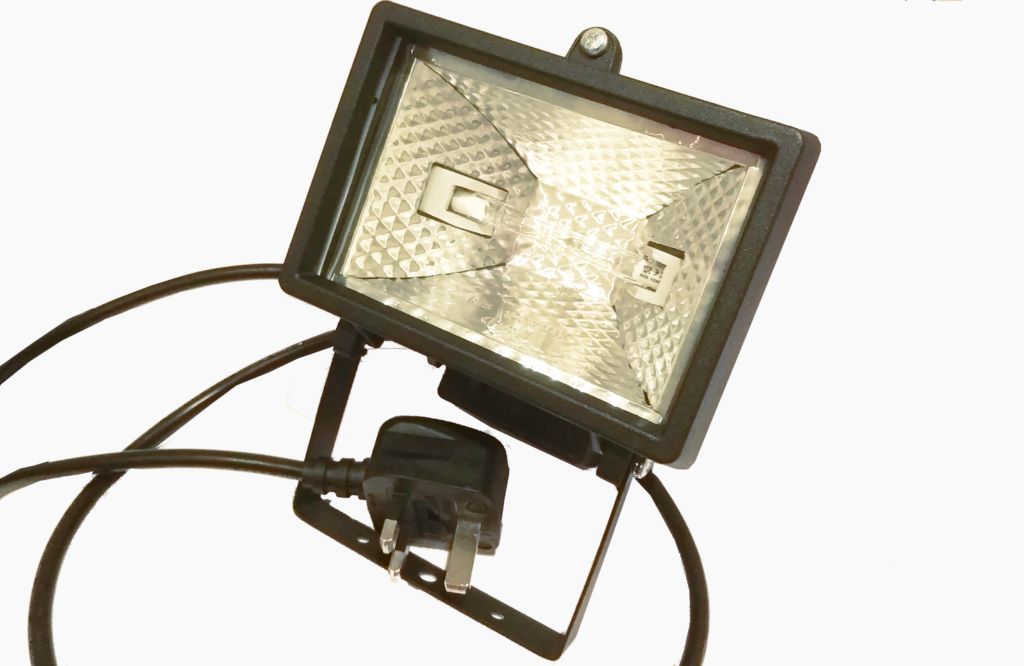
Traditionally used as a security outside light
For a very professional and responsible set up, Sodium Lamps (High Pressure Sodium Lights or HPSs) and Metal Halide MH HIDs (either CMH – Ceramic Metal Halides or MH – standard Metal Halides) (These are for the daylight range of lighting) HID stands for High Intensity Discharge. And too, Gold Halogen Infra Red lamps. Which are especially good for sick tortoises and deeply cold winter weeks (Gold HIRs are for the Infra Red range of the suns wavelengths) These HPSs & MHs and the Gold HIRs are actually the closest to the suns light you can get in advanced traditional lighting, so they are used often in commercial green houses for good plant growth. They are preferable in their elongated Double Ended form (MH HIDs) as this spreads the light more, and covers a bigger area. the RX7s Double Ended Ceramic Metal Halide lamp and special housing is a good example. Dont use anything higher than 70watt… unless you are housing adult Sulcatas, Aldabra’s or Galapago’s Giant Tortoises. Gold HIRs can be a slightly higher wattage though. These lights are also relatively energy efficient. They are perfect for a larger bio-active enclosure. However, they can get very very hot, so need to be protected from being bumped or burning anything near to them, they should also be at least 800mm away from anything. They emit UV at unhealthy levels, but this is mitigated under normal safe operating conditions by the glass they are contained in. They also contain mercury, which is toxic, so they need to be protected from damage, and disposed of safely, when no longer usable. They are being phased out as standard lighting and will become harder to acquire in the future. For a broader spectrum of Infra Red ( IR ) primarily IR A & IR B the use of a Gold Lamp, usually found as a Double Ended r7s bulb like the ideal Tungston Halogen bulbs. Gold lamps are also a form of Tungsten Halogen, but for the gold coating they have on them.
Remember, tortoises require good bright full spectrum, high kelvin visible light, to identify food properly, be interested in different foods and to navigate terrain effectively. You will often find that putting an indoor tortoise outside in real sunlight will prompt them to eat plants they would not ordinarily touch inside, this is likely, at least in part, due to a more vivid rendition of the plants colour being experienced because the real sunlight.


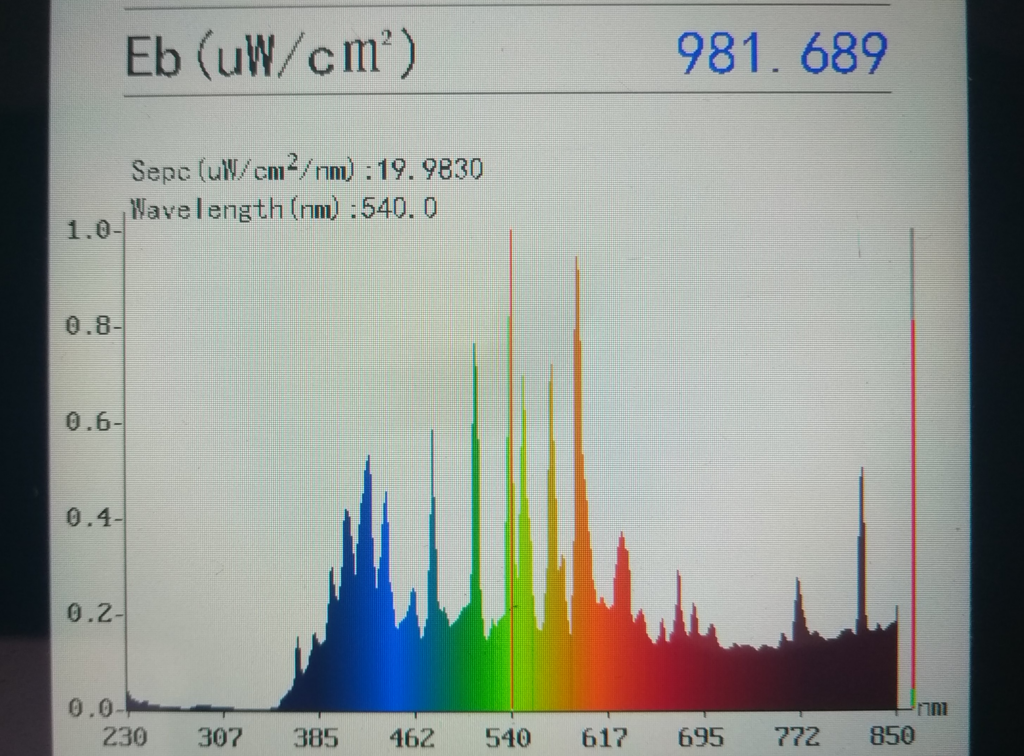
Here we see some good spikes in the visible light nm range 380 to 700 nm, which is what the Metal Halide is for. Tortoises require good bright full spectrum, high kelvin visible light, to identify food properly, be interested in different foods and to navigate terrain. The bulb used is a 70 watt Metal Halide 6000 kelvin. The reading is choppy with many peaks & troughs unlike actual sun light, but it is a good enough start.
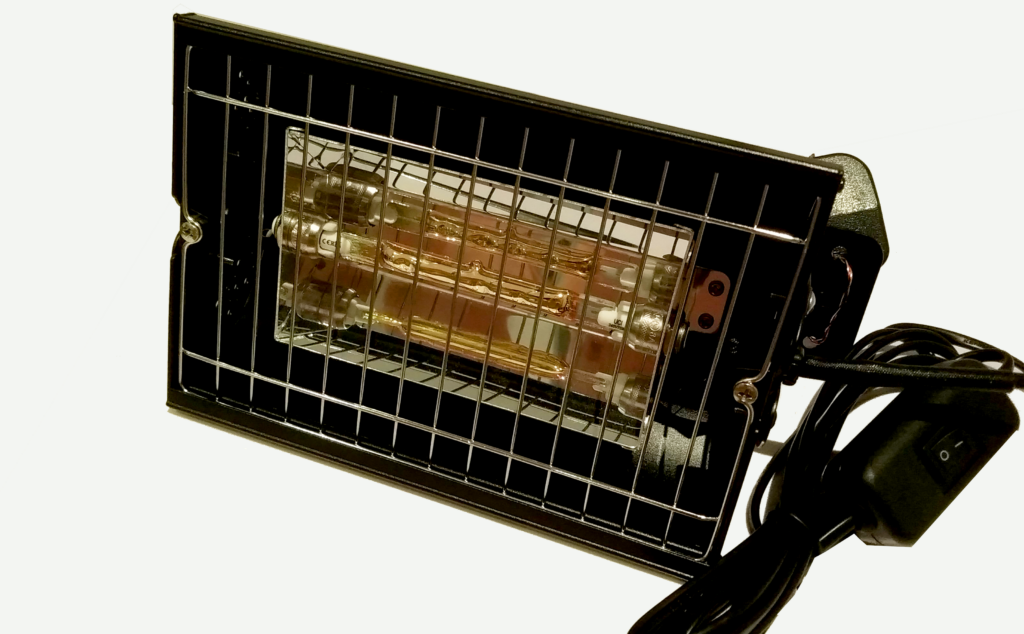
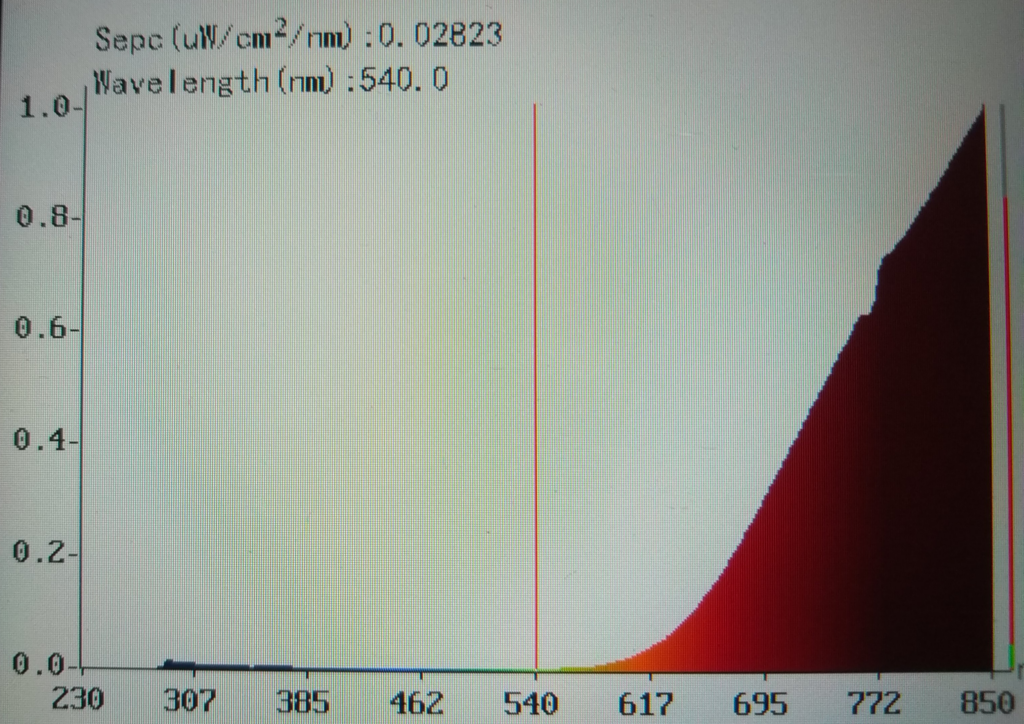
Reading taken with just the Gold Halogen Infrared lamp on, notice the graph rising high on the right where the nm begin to range in the Infrared spectrum

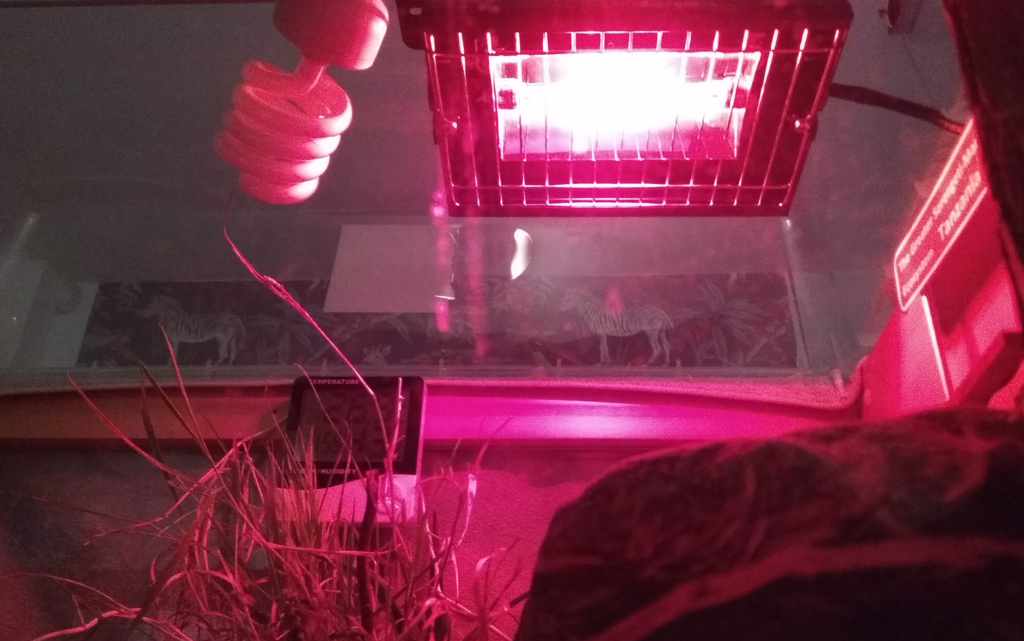
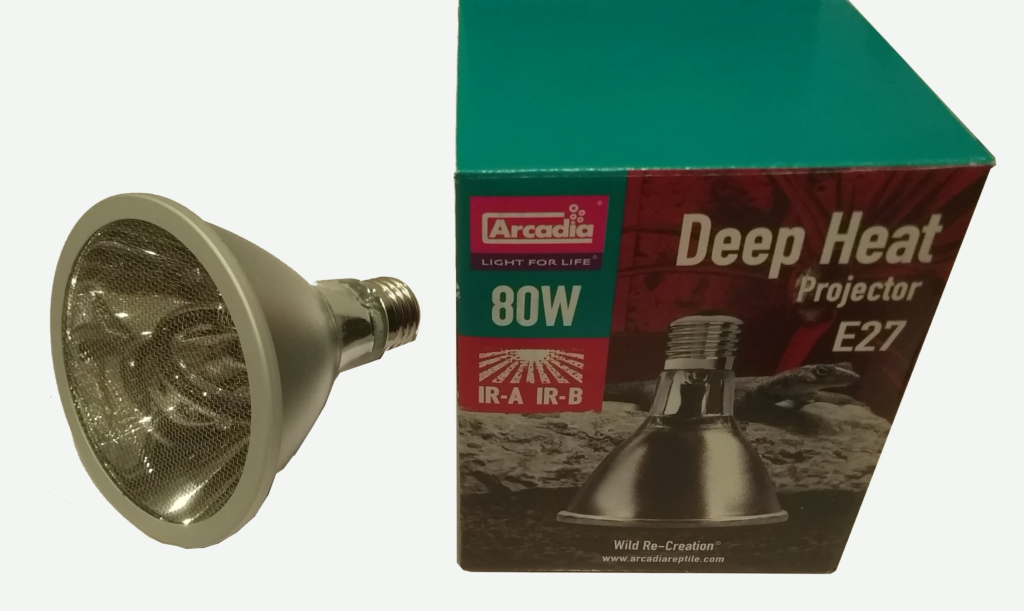
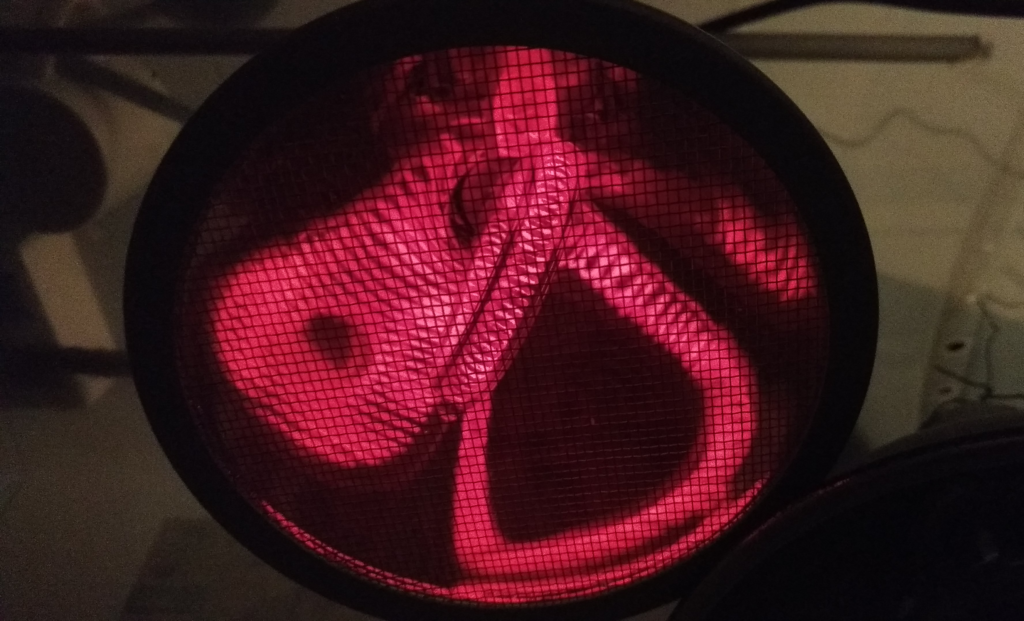
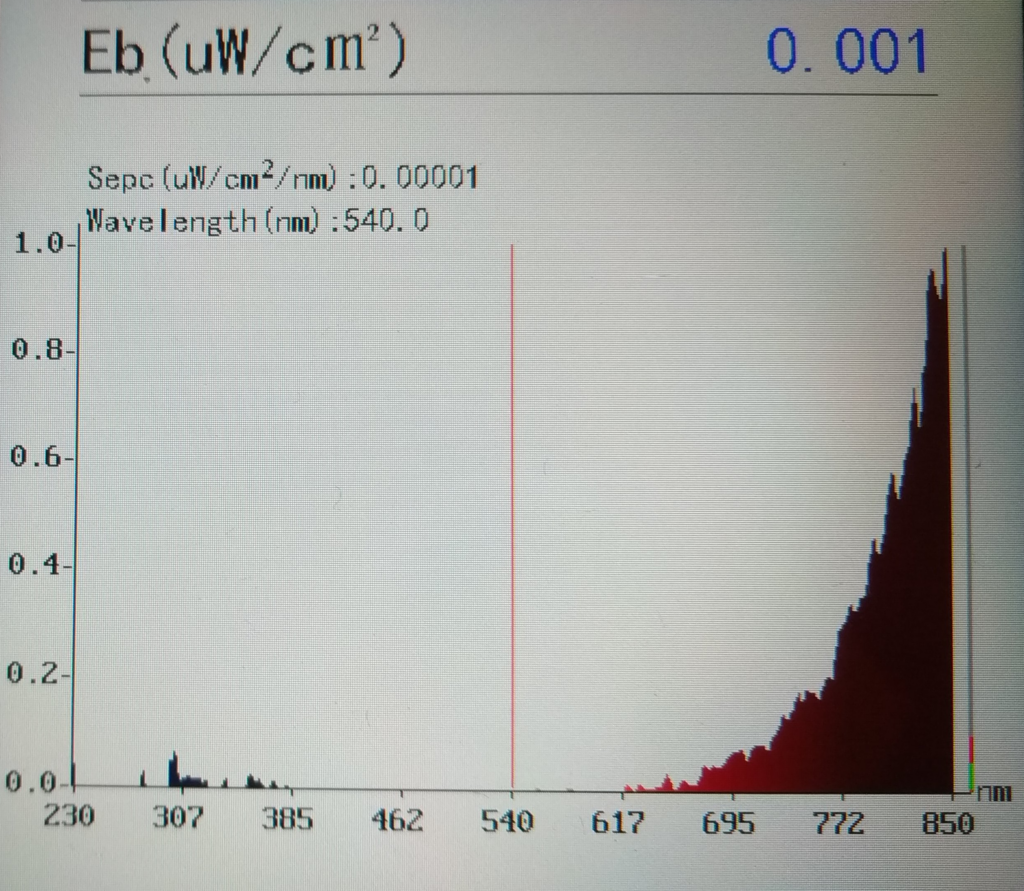
Reading taken with just the Deep Heat Projector lamp on and at night, notice the graph rising high on the right where the nm begin to range in the Infrared spectrum, as with the Reptile Systems ™ Gold Infrared Lamp Unit
What is very interesting and reasuring, is that we are getting a noticable reading of UVB at around 295nm – that special part of the UV spectrum so important for Tortoises, now it has to said, this reading was taken at no more than 15cm from the lamp, so quite close. But, as I really only use the Deep Heat Projectors for under the the weather or sick tortoises, this is not a problem, lamps too, can be lowered to reasonably close proximity to sleeping torts
Now, if we take readings of only the UV lamps on, at night, so there is no other light interfering with the Electrophotometer, this is what we get.

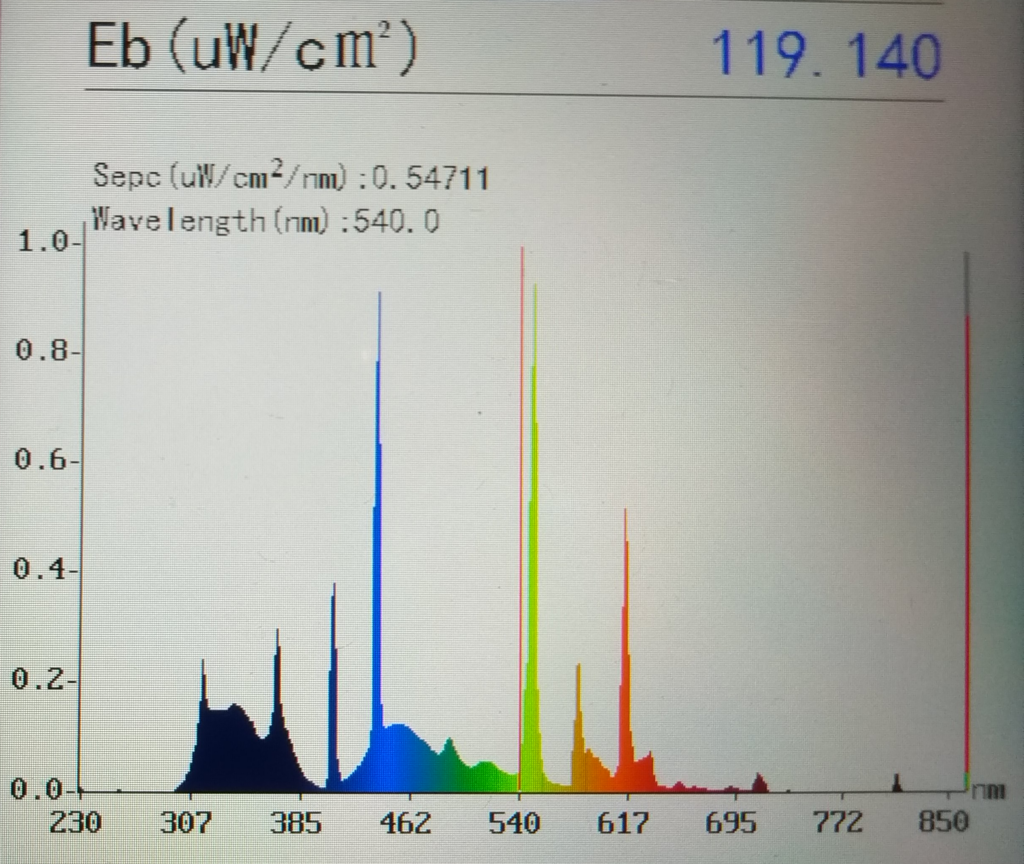
The spikes in the UV range are’nt high because we never want too much UV. And, we getting a little visible light because fluorescents are originally designed for illumination light. But, we are not getting nearly enough Visible Light in the 380 – 700 nm range from the UV fluorescent

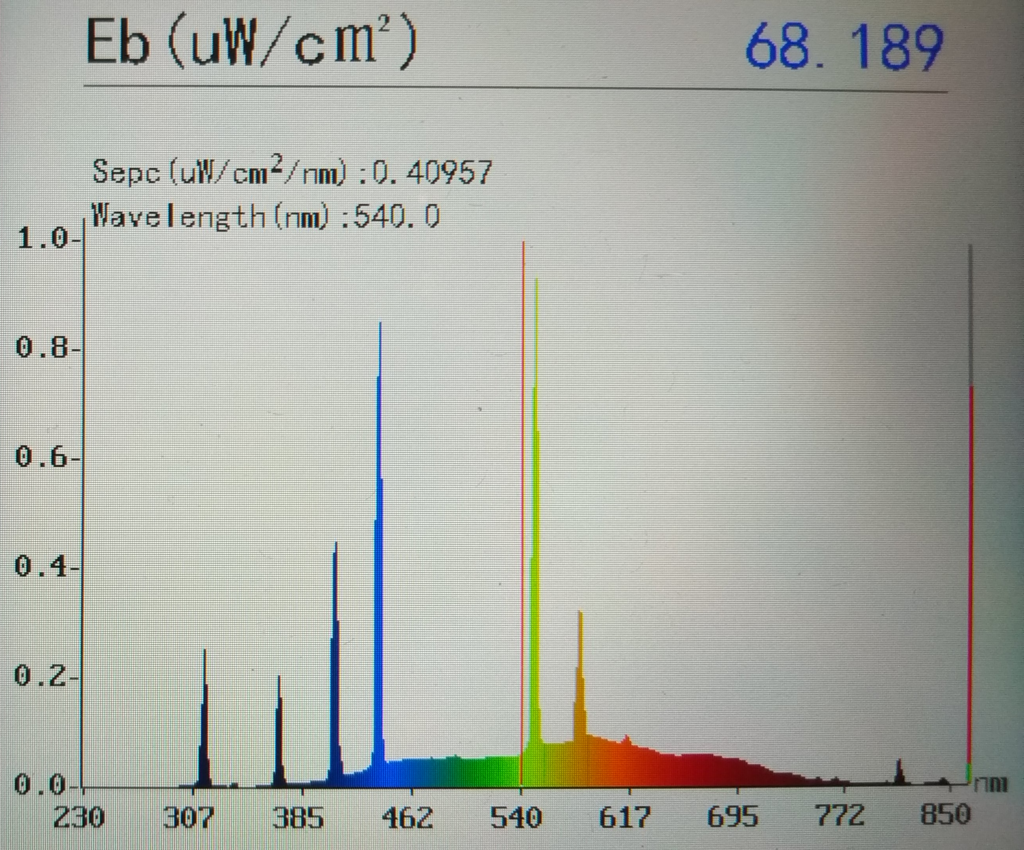
And again, we see a less then lackluster performance in the Visible Light 380 – 600 nm range. And, overall, the intensity is really low at only 0.409 uW Microwatts per Square Centirmeter.
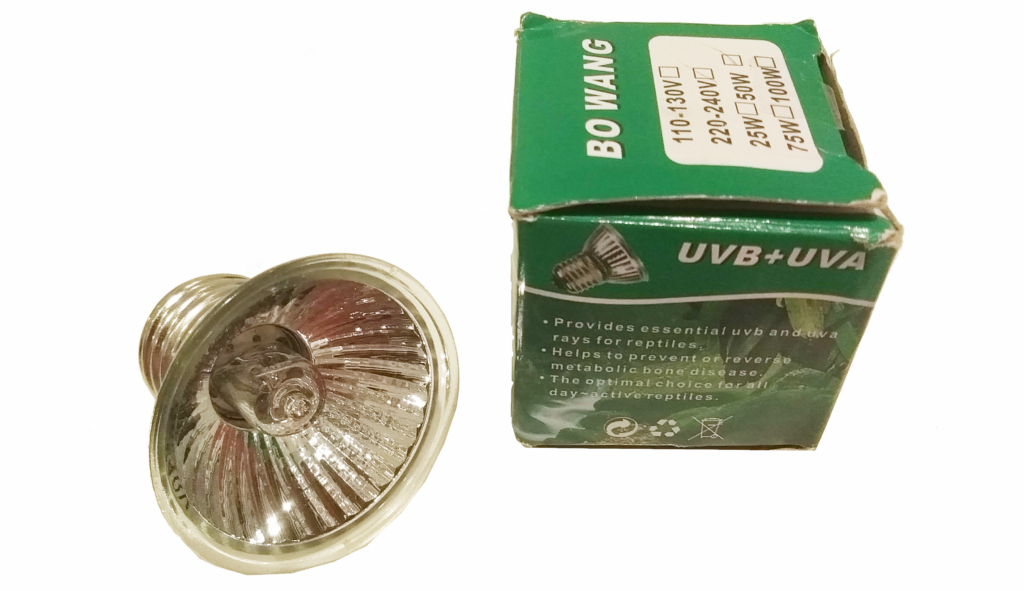
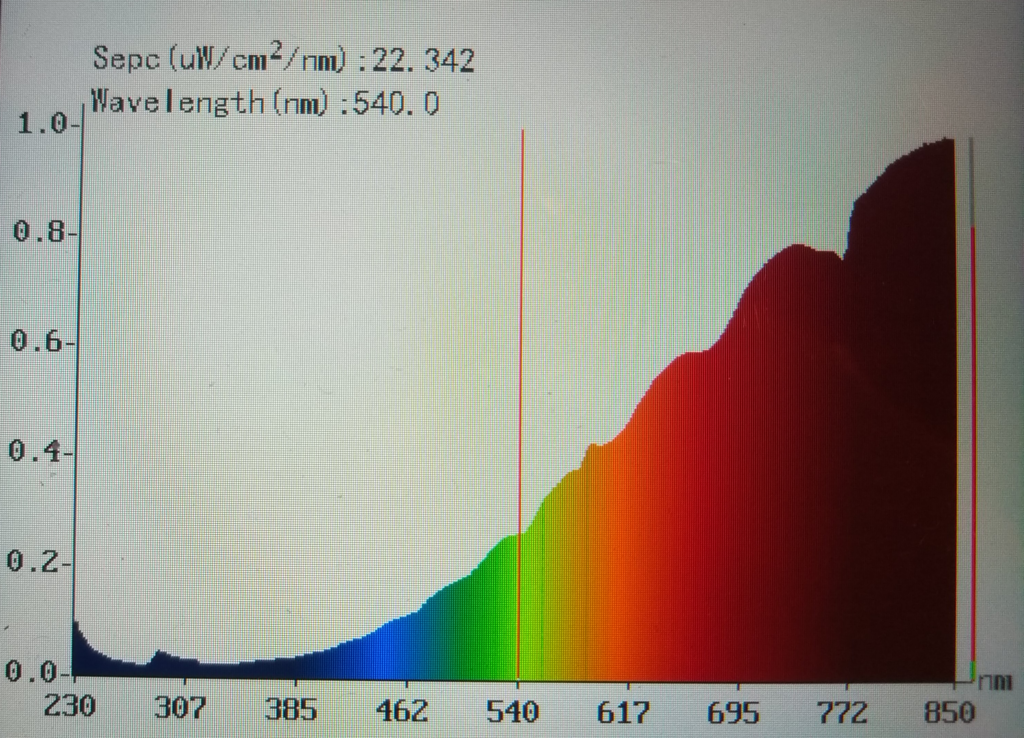
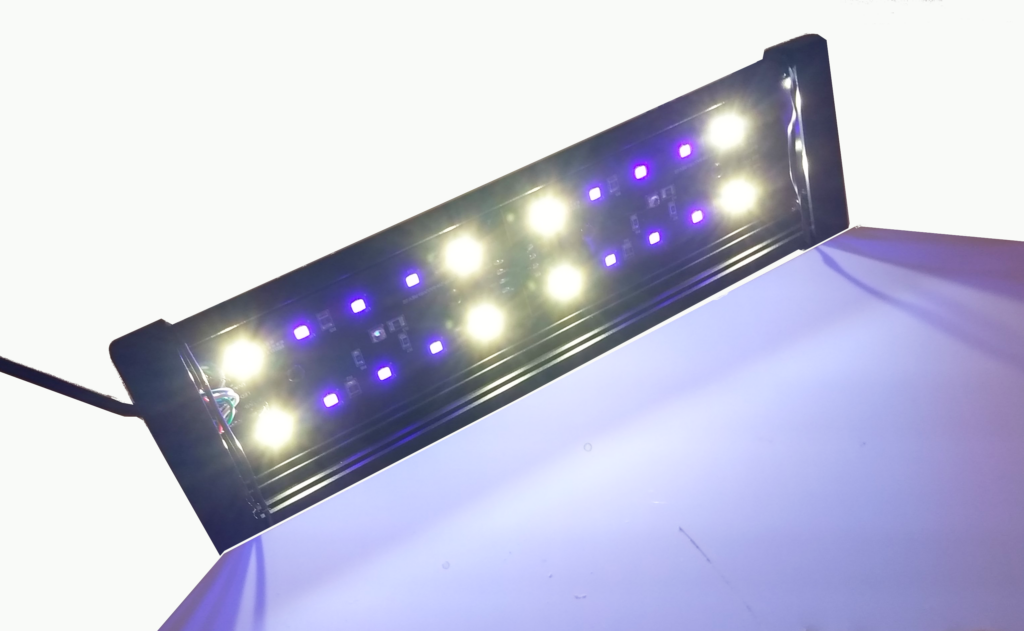
LED Reptile UVBs are still in their infancy as a technology for Reptile Lighting but they are developing slowly into what I believe will be reasonably suitable eventually
Our Spectrometer or Electrophotometer show the reading below
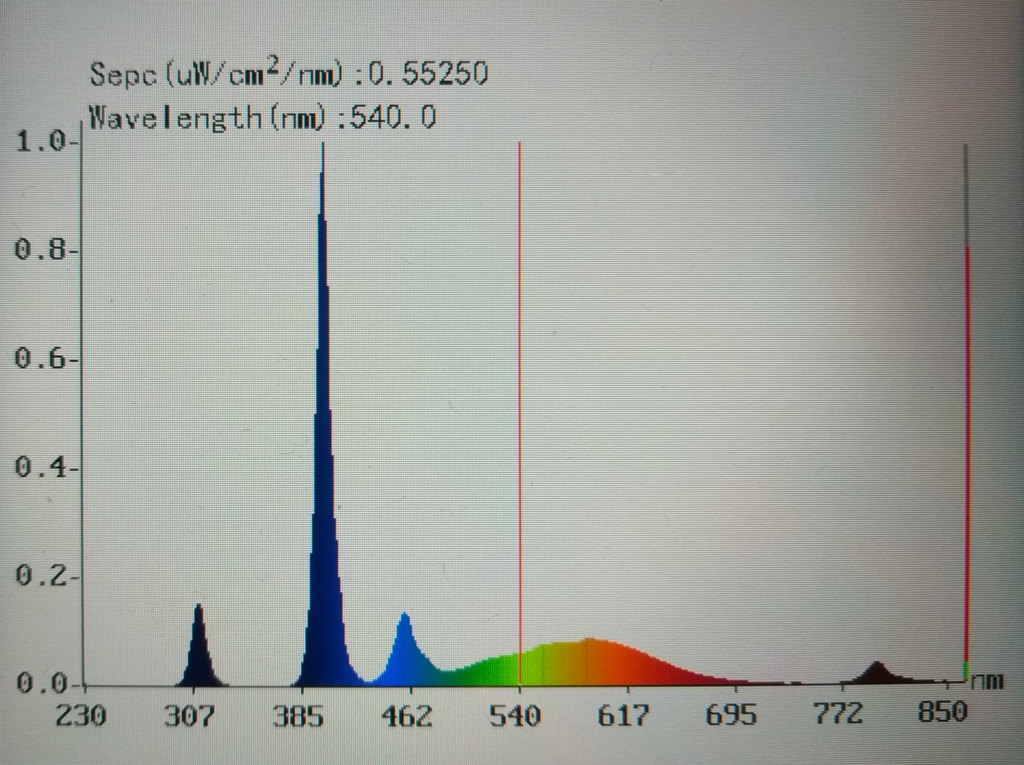
We have a little spike around the 307 nm mark which would mean there is some presence of UVB in the 295 nm range, thats good, overall intensity at 0.55250 uW/cm2 is not disimilar to the readings we got off of the dedicated Reptile, widely used, Fluorescent UVB strip and curly lights
Outside Light readings on a winter day (UK) look something like the reading below, and is what we are aiming for, for a diverse natural light rendition for indoor enclosures.
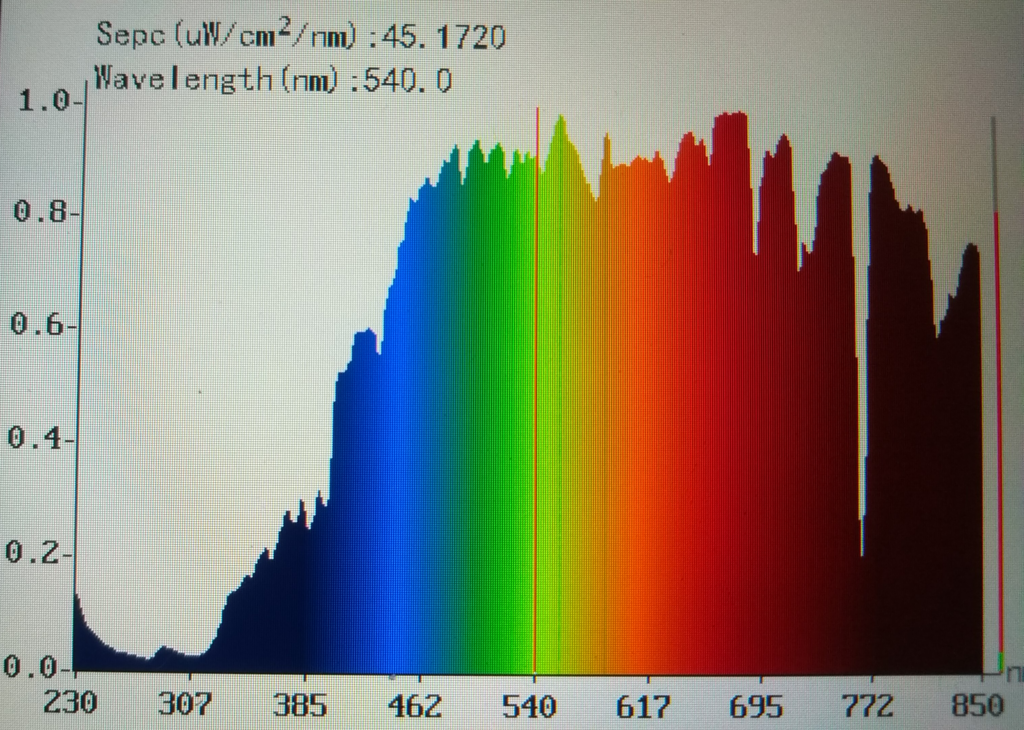
Lets start mixing some of the different types of lights to see if we can get to something like the above natural daylight reading.
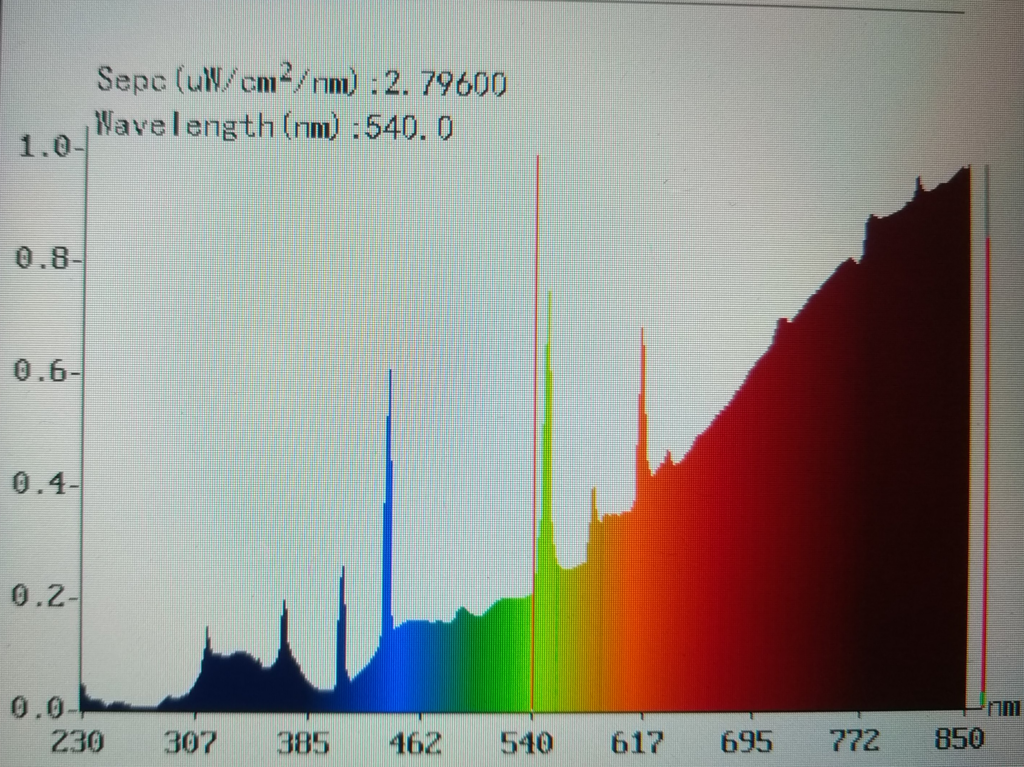
notice we have a really good amount of IR – Infrared increasing significantly as we near 850 nm. We have an ok bit of UVB around the 307 nm mark, but not a great or satisfactory amount of visible light from
380 – 700 nm
Now, armed with what we know the different lights do, lets head into the studio, build a lighting rig incorporating all of them brand new, tweek the set up, and see what the reading is.
Incidently, I took one of my old powerful Photographic Studio lights, a 2000 watt Unomat, housing 2 x 1000 watt Halogen gx6.35 bulbs. *Not at all suggested for Reptile lighting or animal husbandry in general. The reading below is pretty standard for a Halogen lamp, apart from the heat, they can near enough cook a roast from a foot away.
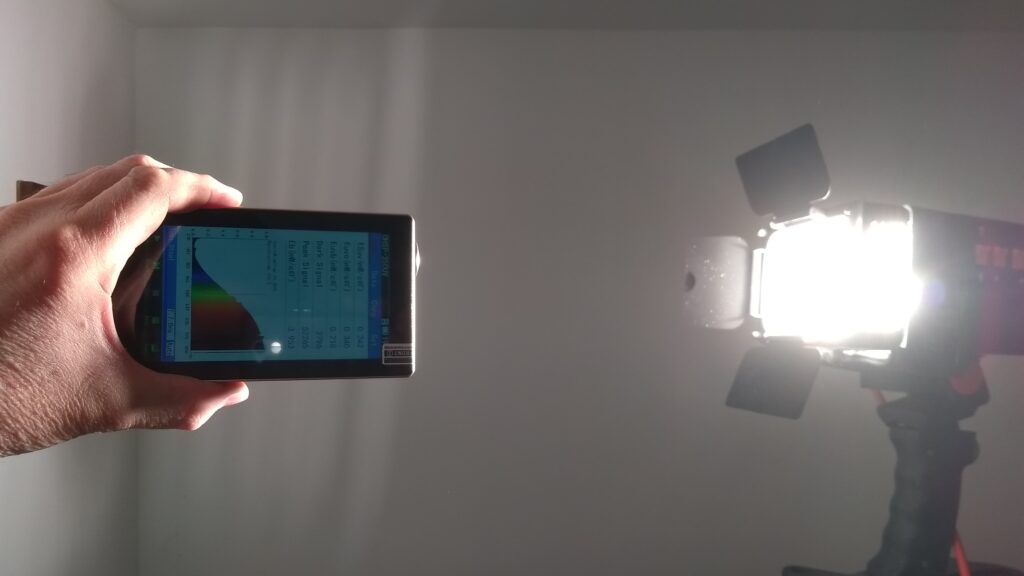
*Not for exotics lighting
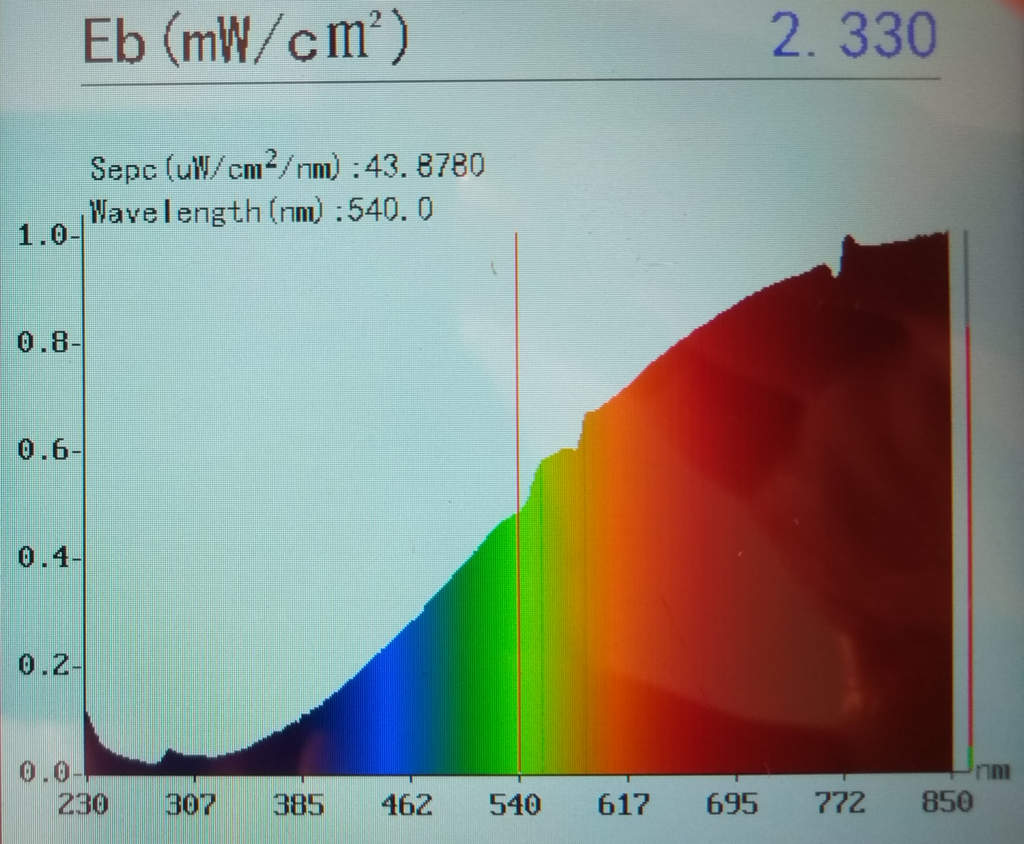
Although, notice the gradient is a great deal smoother, because of the intensity of the this Photographic light. This is especially visible around the UV band, which we just dont get with dedicated Reptile UV lights, and it is a more natural emittance with a very good and similar profile, much like the real sun
Be aware, that we hav’nt even begun to look at the light exposure intensity of each light type yet, we have just only looked at Nanometer range . This intensity is the amount of, and intensity of, light falling per centimeter squared or uW/Cm2 or Microwatts per Centimeter squared, and is another whole metric to consider (comparison again, with the outside sunlight reading)
The above reading of the 2000 watt Halogen interestingly shows a reading of intensity of 43.87 uW / cm2 which is near enough the same as the the reading in the UK on a winters day which was 45.17 uW / cm2
The below reading was taken in Egypt along the northern South Sinai coast late afternoon. Interestingly again, the reading is almost identical to the the UK reading midday on a winters day with a difference of only 2 microwatts (uW) per Cm2
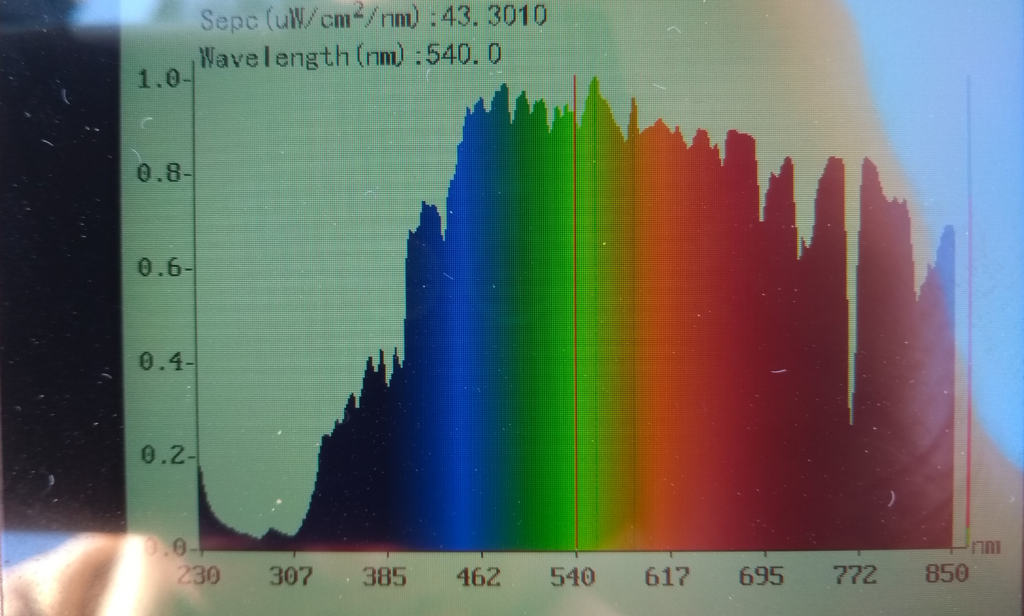
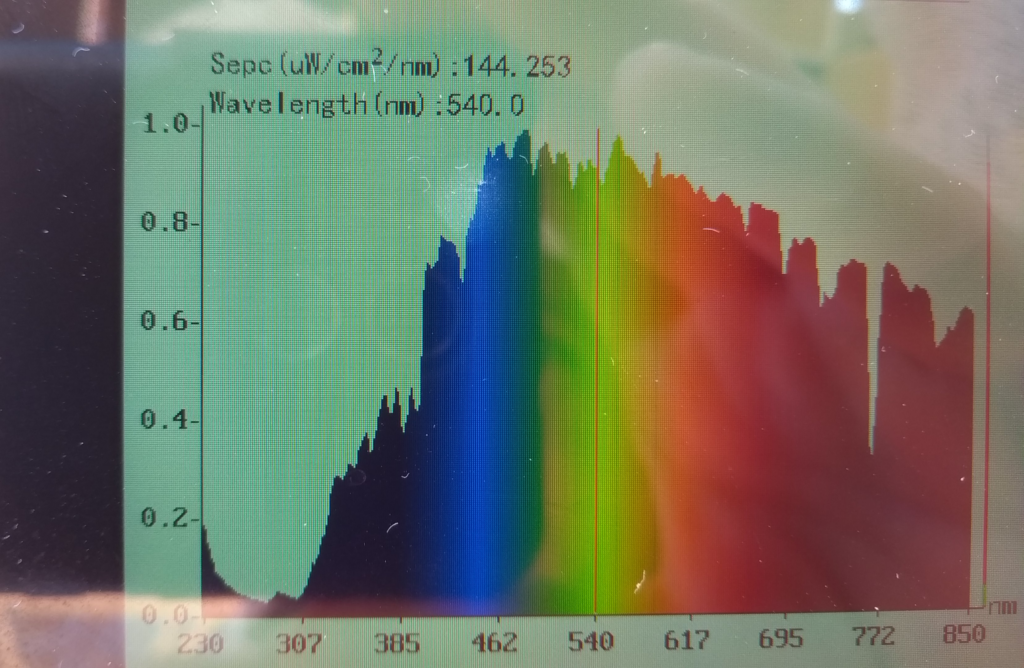
So, with my Supreme Gaffer T-shirt firmly on, lets build that full spectrum Lighting rig…….
But, light does not exist in a vaccum of other stimuli and effects, we have humidity, which can make sunlight effect on the body and landscape quite different from one moment to the next, even if we have the same Cloud Cover or indeed no cloud cover from one data point to the next. We also have the Wind Chill Factor, and the Heat Index in contrast to that, and reflective natural features and absorption features. So, we need to keep these dynamics in mind when thinking of Full Spectrum light in our enclosures.
And, then there is a much bigger issue, as previously stated, By buying a RF / EMF sensor/ RF Field emission detector and testing your enclosure areas, you will be shocked to see how much nasty RF / EMF bleed, and wasted electricity is actually emitted from lights and other electrical support features.
Excess of water, too much food, too much stress, too much light, too dark, too wet, too dry,too hot, too cold, too noisy will cause adverse effects on exotics, and often will result in death. So, why oh why, would we assume an excess of EMF would some how be ok?
So, is all this lighting really necessary, well, we dont know if we can get away with providing our exotics with just certain bands of the light spectrum and completely leaving out others and providing limited light intensity. We should work toward erring on the side of caution, providing all of the spectrum until we truly know if we can leave some bands out and have much lower intensity. I dont think we ever will be sure we can leave some out.
There is also the fact, as with any subject matter, of the ontological complexity of the our universe. As Aristotle is attributed with saying, “The whole is greater than the sum of the parts.” In other words, there is far more going on that we can or may ever be aware of, or more than we can ever ‘science’ out of any subject.
While the sophisticated light meters we use give us a good picture of what the effects the light might have on our exotics and indoor enclosures, there are even more unseen, unknown things going on that we are not aware of, may never be aware of, and, even, not be allowed to be aware of. There are women, usually women, usually retired women out there, who can perform literal miracles with animal husbandry, rehabilitation and care. They are sometimes able to care for and save the most severe, injured and ill animals, bring them back from deaths door. They are seldom trained clinicians, and very very few have degrees or any real qualifications often, but their innate knowledge and advanced intuition is second to none. I have seen this right before my eyes many times. That is why, the disdain many so called ‘professionals’ have for ‘common’ good keepers and ordinary good rescuers of wild animals is very telling of their utter stupidity and iniquitousness.
Advanced Keeping also ideally involves large dynamic enclosures, with an abundance of natural direct sunlight, running water features, and a complex topography for enrichment. Advanced Keeping must however, include, very sensible, well planned, and well researched design, safety and constraints.
Running water, ie a small waterfall or stream running through the lower end of the enclosure is a good idea. Running water is oxygenated from the air more easily and oxygen kills pathogens, so it is best that running water is the preference. Many tortoise species are adept at dealing with water, they have been around longer than we have as a species, and they were around when the world was a wetter place. Most can swim well, and would appreciate a shallow body of water which helps them thermo regulate when they are hot, allows plenty of opportunity to hydrate, and, there is also opportunity for a more diverse array of food plants in their enclosure. Remember, all of today’s Totoises’ evolved from Sea Turtles types, once came from the sea, and so their physiology is, by design, is accustomed to water. Oddly enough, it is more likely, that a tortoise will drown in a small slippery bowl of water, than in a small shallow pond or even a lake, they are more likely to be able to right themselves in a larger and deeper body of water, if flipped on their backs, or fall into the water, than if having never known water as a hatchling, or land up in a small slippery drinking bowl upside down.
Mud is also another form of thermoregulation used by many species of animal, and, it is also eaten by them. The eating of mud and even sand is not, by itself, a problem for tortoises or exotics. Many species will eat mud and soil to extract useful minerals and create Probiotics they are lacking in their diet, and is very seldom a problem with regard to impaction, if their hydration is good, ie they have drunk enough, they have eaten the right diet, and have sufficient humidity in their enclosures, have right Infrared Lighting which helps bowel movements, and they have space and topography for enrichment – remember, physical activity enhances bowel movements too, and keeps ‘things’ moving. One very important Trace Element lacking in so many diets, including Human diets, is Selenium, most often found naturally, in Soil or Mud. The study below is merit to the provision of mud in enclosures.
https://pubmed.ncbi.nlm.nih.gov/36335804
It is best practice to have 2 or 3 or even 4 enclosures per species for a number of reasons. There is the fact that in many countries keepers reside in, winters are not fit for Tortoise survival, so they need 1, preferably 2 indoor enclosures, as you might need to separate individuals, and it is a whole lot easier to have the set up in place should you need to. Outdoors, the same goes, unprading and repairs are also facilitated by having another enclosure for your exotics to go into. Another really good reason to have multiple enclosures is that your tortoises will get used to things being changed up quite substantially from time to time. Light, temperature, humidity and environment will be different outdoors compared to indoors. This mimicks migratory changes and seasonal changes, but most importantly, it gets your individuals used to change, and that is super important should your Tortoises need to move home, or even just go to the vets. These sorts of changes can be very stressful and detrimental for animals, so few keepers realise this… and especially authorities, but not so much of a problem if the animals are use to changes.
Advanced Monitoring of indoor enclosures & Field Work monitoring for comparison.
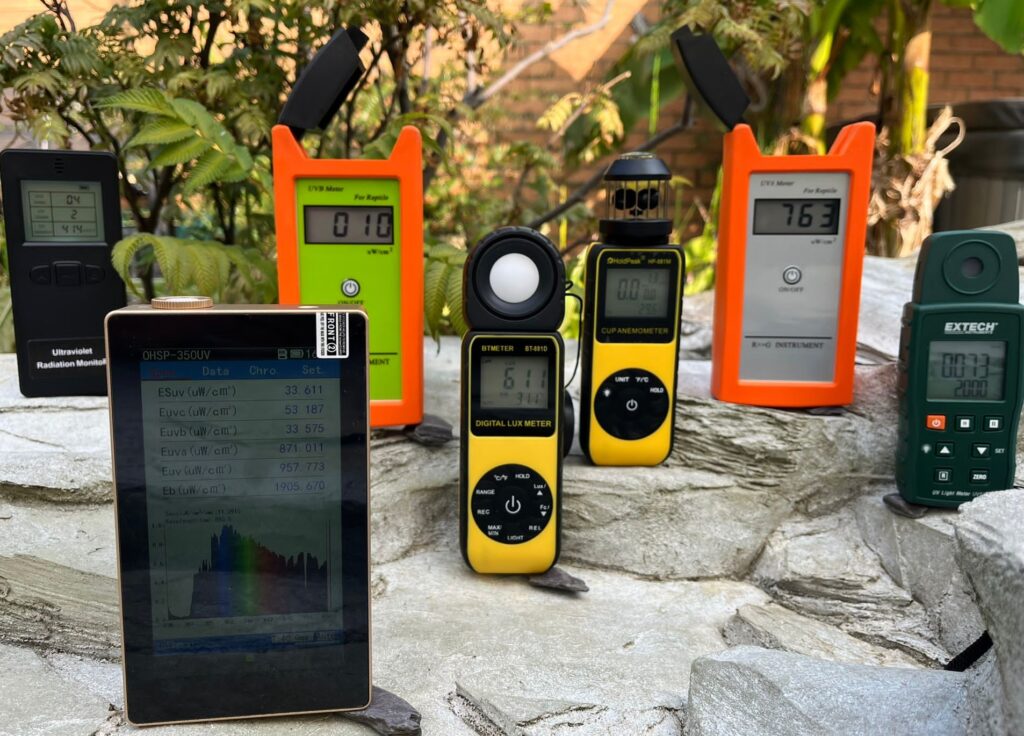
this section is on its way
How to fund your passion for your chosen exotic:
*I’m not in favour of selling exotics, but, given the fact that true breeders make absolutely nowhere near the money back that they spend out in keeping and breeding the animals, selling to recoup some costs and ensuring that buyers are financially viable by being able to pay for the animal in the first place, is totally acceptable, and probably the best option, all things considered.
Charities
Trusts
Benevolent friend or family member
Investments
Crowd Funding
Keeping working in your job or profession
Resources and Links
https://www.thetortoisetable.org.uk/
https://www.wormadvice.com/tortoises
http://www.austinsturtlepage.com/Care/medshell.htm
http://www.chelonia.org/Articles/shellrot.htm
Points: for a perfect enclosure
Habitat 54321
5 hides or more
4 essential natural elements per enclosure
- Hides
- Water
- plants
- Substrate / Topography
3 types of lighting
- Basking Heat Lamp
- UV
- Board Spectrum Grow Light
2 sources of clean water
1 enclosure for inside, 1 for outside
Conditions: avoid 2222 (The dreaded too’s)
2 hot – too much lighting, heating / on too long
2 cold – no lighting / heating agents in enclosure, drafts, close to windows, no tops on enclosures
2 open – predators able to get in, things able to fall in
2 dry or wet – too much misting / dampening or too dry
Points: for a perfect setup
Magic 8
1 Do you have the correct Enclosure/s?
2 Do you have a suitable Vet or at least a good exotics Mentor?
3 Do you have back up plans for Power Failures (ie home Diesel heater, or plans for your own Medical Emergencies or Emergency Travel?
4 Have you done your homework on your species?
5 Do you have some basic Medicines at home for injury or illness of your exotic, and do you have the skills to administer these?
6 Do you have the time to dedicate to your pets?
7 Do you have Security – both Home Security & Financial Security?
8 Do you have a big heart, are you capable of dedicated unconditional care for your exotic no matter the cost?
Points: for perfect observation
C.H.A.R.A.C.T.E.R. for your tortoise
Changes Hides regularly – will they sleep in different hides at night?
Healthy Looking – no signs of sudden abnormality?
Active during the day – do they walk round some of the day, explore?
Reactive to Stimuli – touch, loud noises, vibrations?
Assertive – are they stubborn, if enclosure is cleaned do they strop?
Curious & Inquisitive – are they interested in stuff in their enclosure?
Tenacious – do they like climbing over things or try to get to places?
Eating regularly and enjoying their food?
Reproductive – are they interested in Copulation & Courtship?
If any of the above are not observed in your Tortoise it can be a sign that your Tortoise is medically or emotionally ‘compensating‘ meaning they are not holistically well, this only leads to deterioration, disease and eventually death, if not counteracted.
The Bone Chilling array of threats facing Tortoises and all Wild Life in the wild
Fires – Manmade & natural water droplet magnification fires
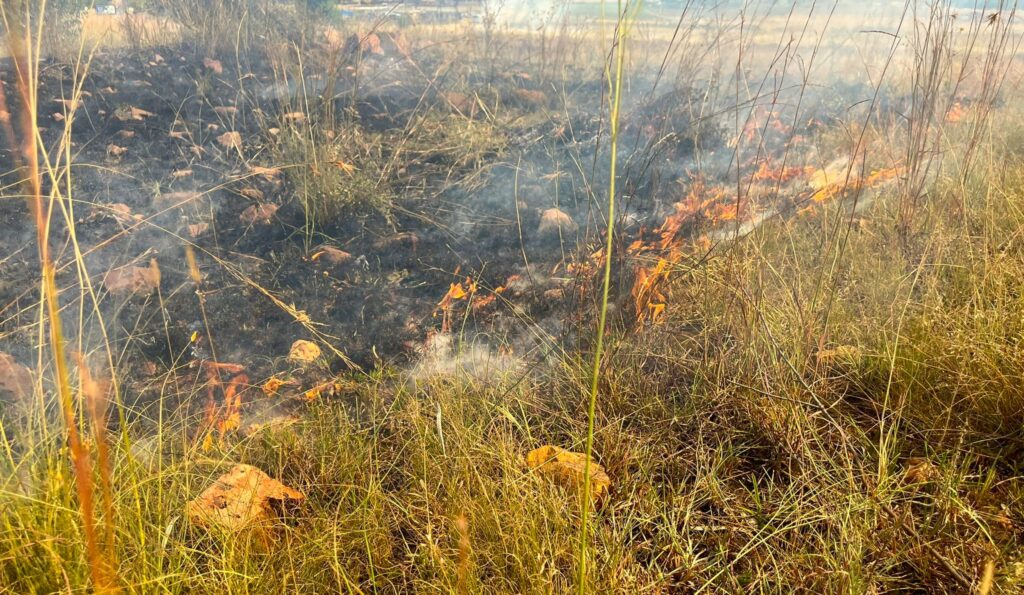
Trains, Train Tracks – blunt force hit kills and injuries
Roads – blunt force hit kills and injuries, toxic effects of tar and internal combustion engine emissions – like benzine and POP’s – Persistent Organic Pollutants – Some of which are:
aldrin ¹
chlordane ¹
dichlorodiphenyl trichloroethane (DDT)¹
dieldrin¹
endrin¹
heptachlor¹
hexachlorobenzene ¹,²
mirex¹
toxaphene¹
polychlorinated biphenyls (PCBs) ¹,²
polychlorinated dibenzo-p-dioxins²(dioxins)
polychlorinated dibenzofurans² (furans)
1-Intentionally Produced.
2-Unintentionally Produced – Result from some industrial processes and combustion.
Electrocution from Electric Fences, poor electricity distribution lines & Railway Lines ground power, Targeted Electrocution by Farmers and other hostile land owners
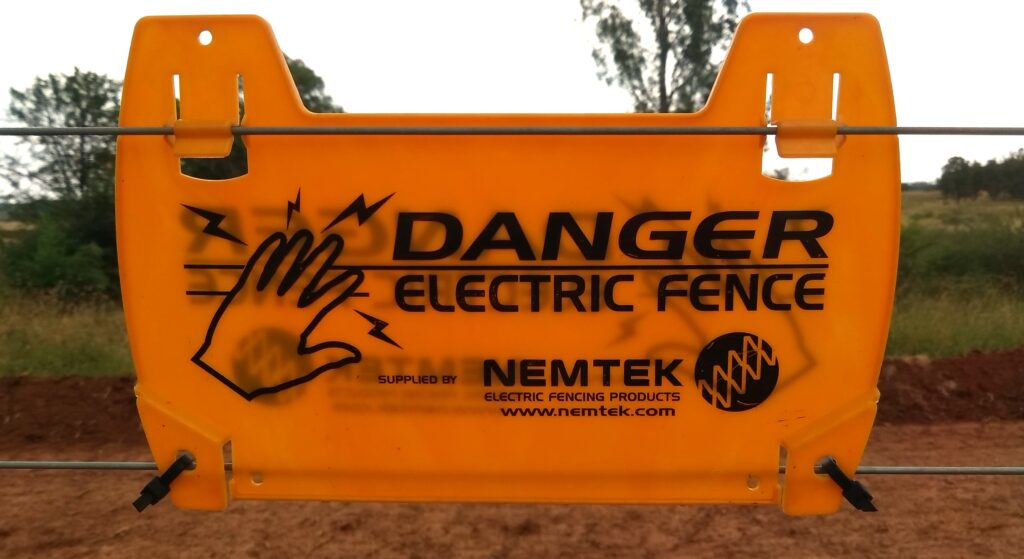
Drains & Storm Water Drains – once animals go down these, their death is a surety
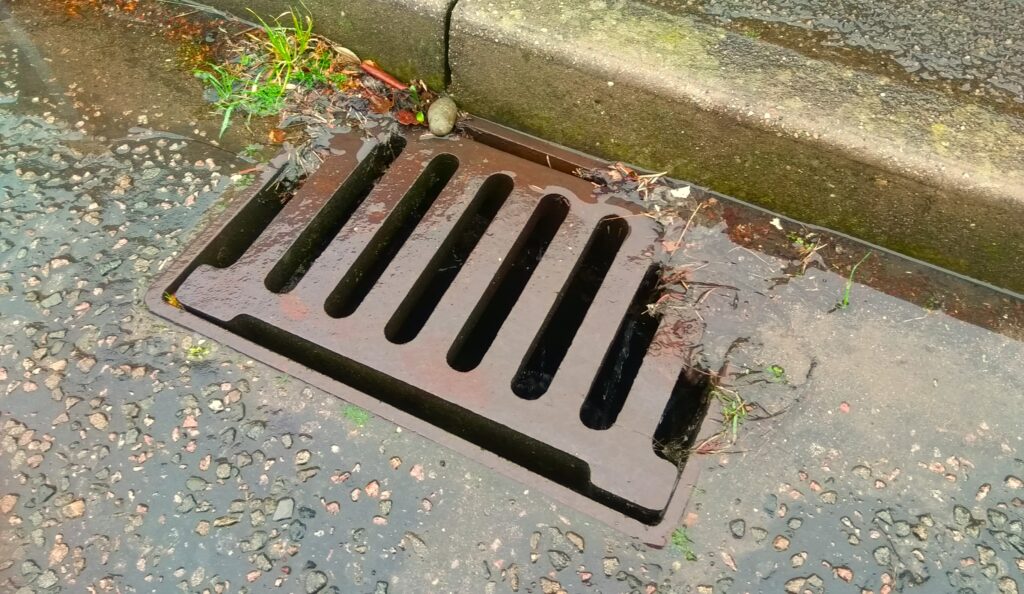
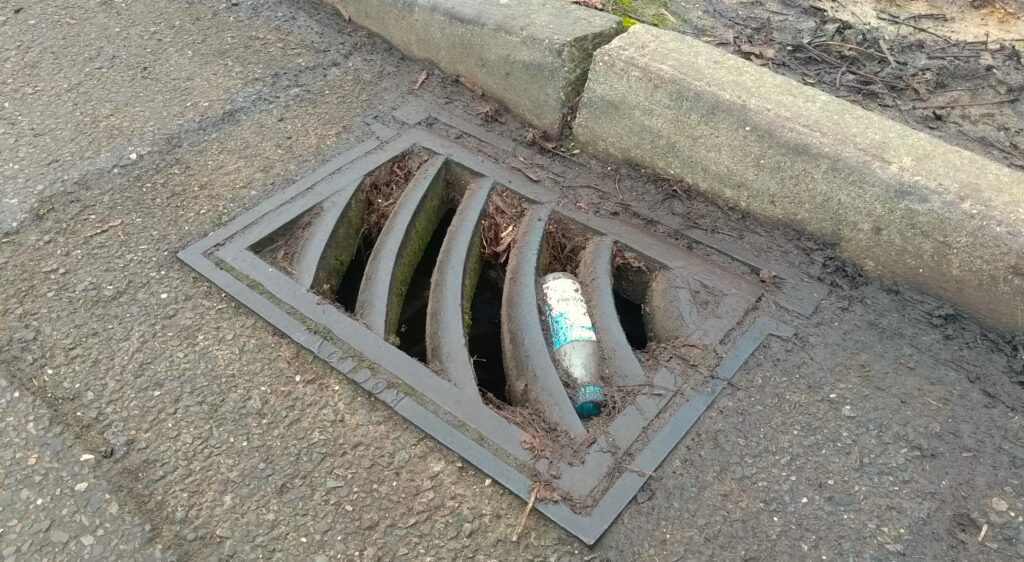
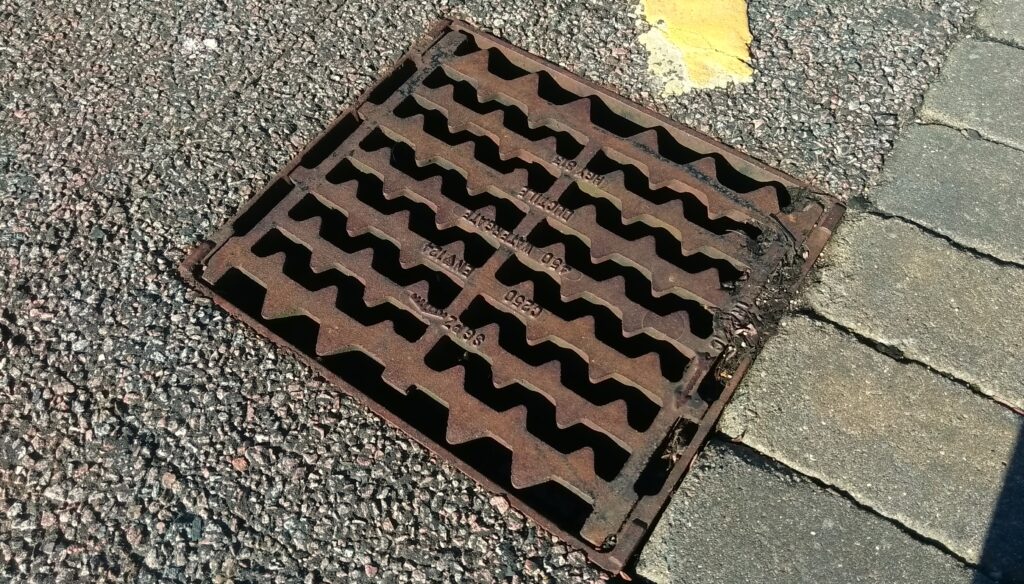
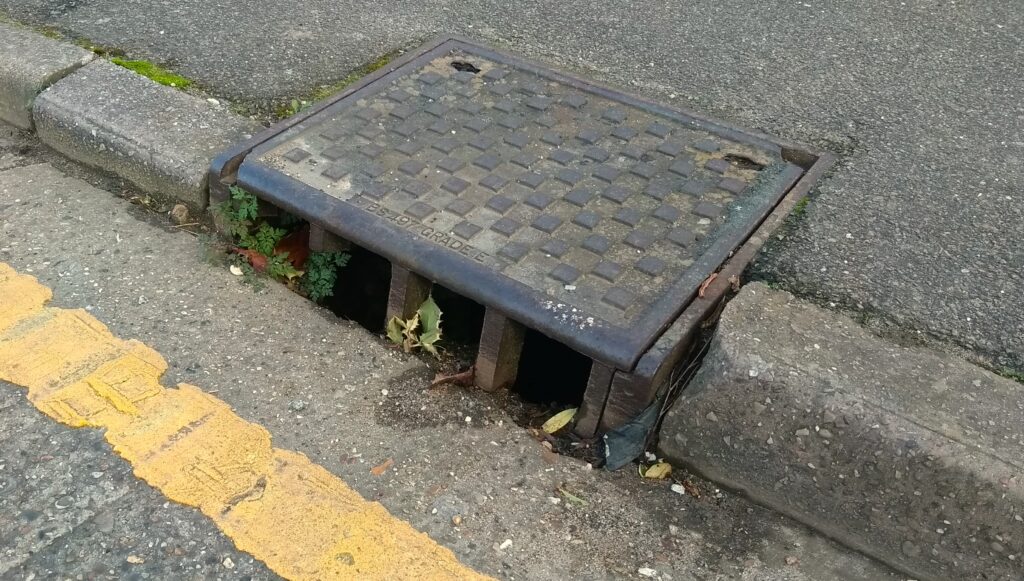
Killing by Zoosadism or Fear of (killing animals for fun or from fear) – on the rise in many parts of the so called First World
Poisoning, by accident or deliberately, again, most often by farmers and other hostile land owners
Invasive species, often too, by the irresponsible pet trade
Pollution, unintended, unacknowledged, unseen, POP’s – Persistent Organic Pollutants, Polycyclic aromatic hydrocarbons (PAHs) Mercury
Hunting – legal and illegal hunting
Habitat destruction: road building, housing, power production & and power distribution, poor land managemant
Dam building
Farming, land alteration, pesticides, herbicides, organophosphates and carbamates in fertilizers, toxic hydrazine for agricultural products etc. This list is very long
Water pollution by pharmaceuticals, sewerage works / spills & industrial waste. Again POP’s – Persistent Organic Pollutants
Weather augmentation, cloud seeding, con-trailing / chemtrailing – yes this is a thing, and very much real, just like weapons testing in MOD ranges, military testing ranges & defense contractor test sites, the atmosphere is used regularly for ‘testing’ things and ‘altering’ ‘things’
Weapons testing areas – often done in wild areas away from human settlements
Wars, depleted uranium shell radiation and lead poisoning – plumbism and saturnism . According to the Council of Europe, more than 100 different types of Toxic chemicals are released in great number in an average war
Habitat Augmentation – modest changing of habitat deliberately or unintentionally or indirectly – the Egyptian Tortoise is nearly extinct, largely because telephone poles were erected in their desert range, quite innocently, but it allowed the perusal of birds of prey to hunt the little Egyptian Tortoise like never before. Again the Egyptian Tortoise viably survives today, only because of captivity, most viably though, and by captivity in its home / indigenous range and too, abroad. Resent wars all along the southern Mediterranean (Gaza had Kleinmanni too) have pretty much sealed the fate of the Egyptian Tortoise in the wild
Viruses – both natural viruses, and too, more virulent viruses because of environmental pressures, and now also, in this new age of bio weapon & Gain of Function research – ‘non natural’ viruses!
Do you still think wild animals are better off in the ‘wild’ ?